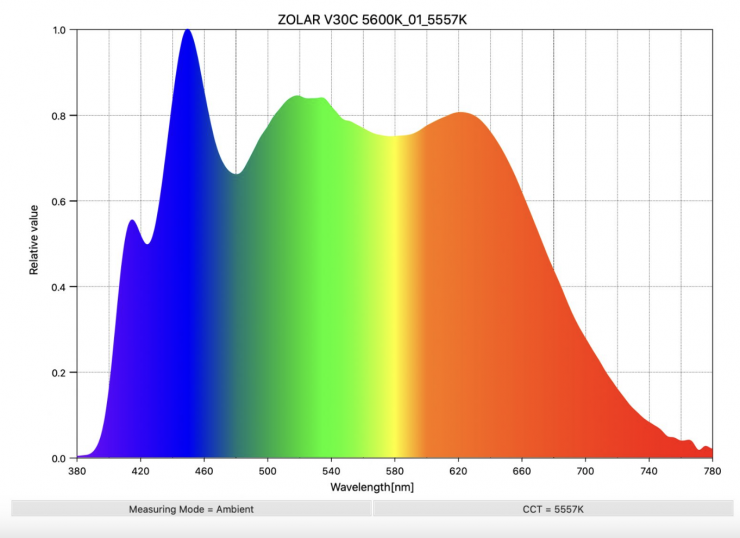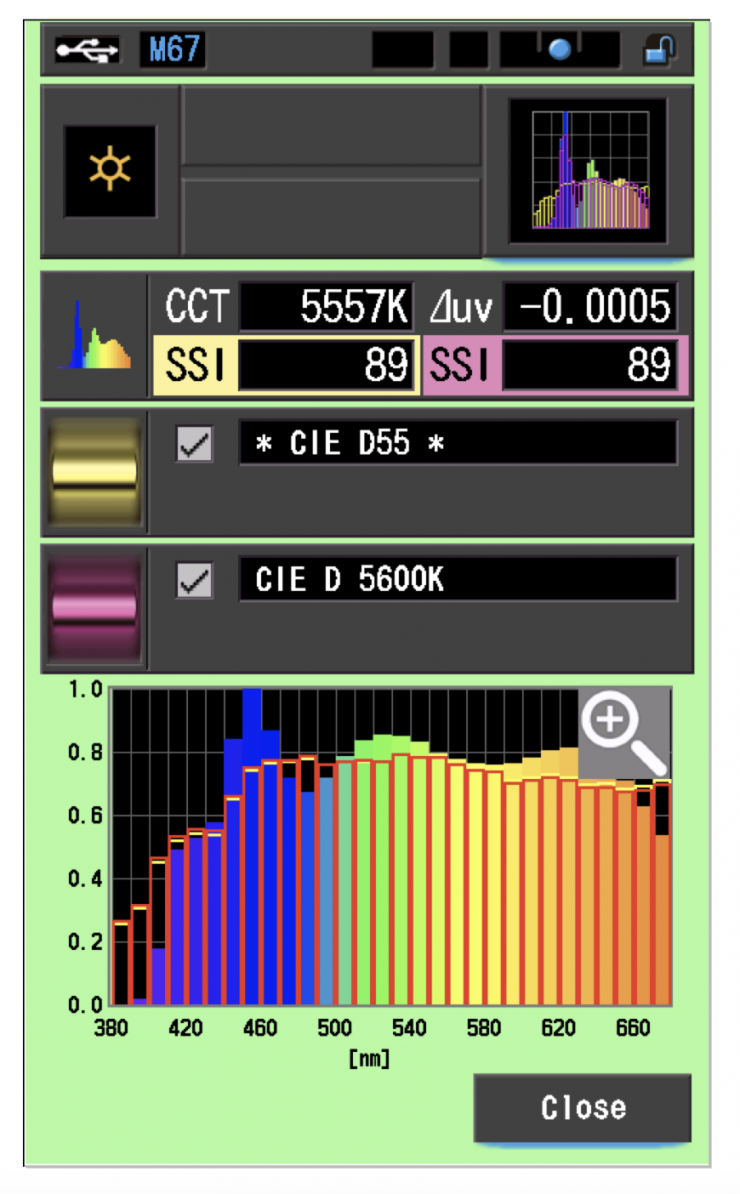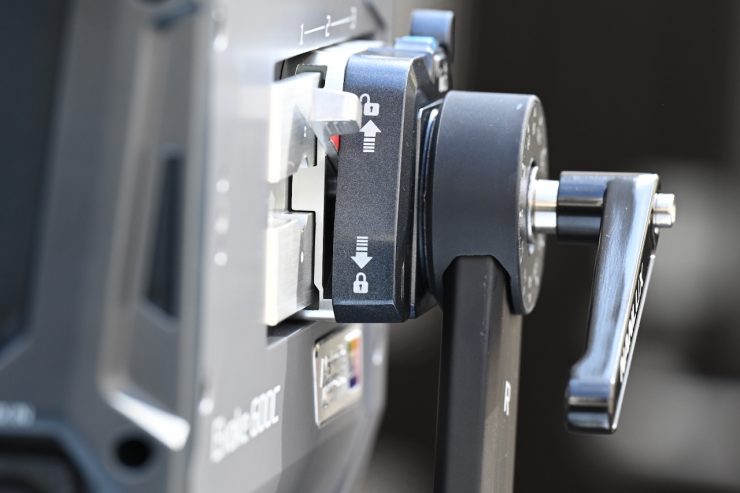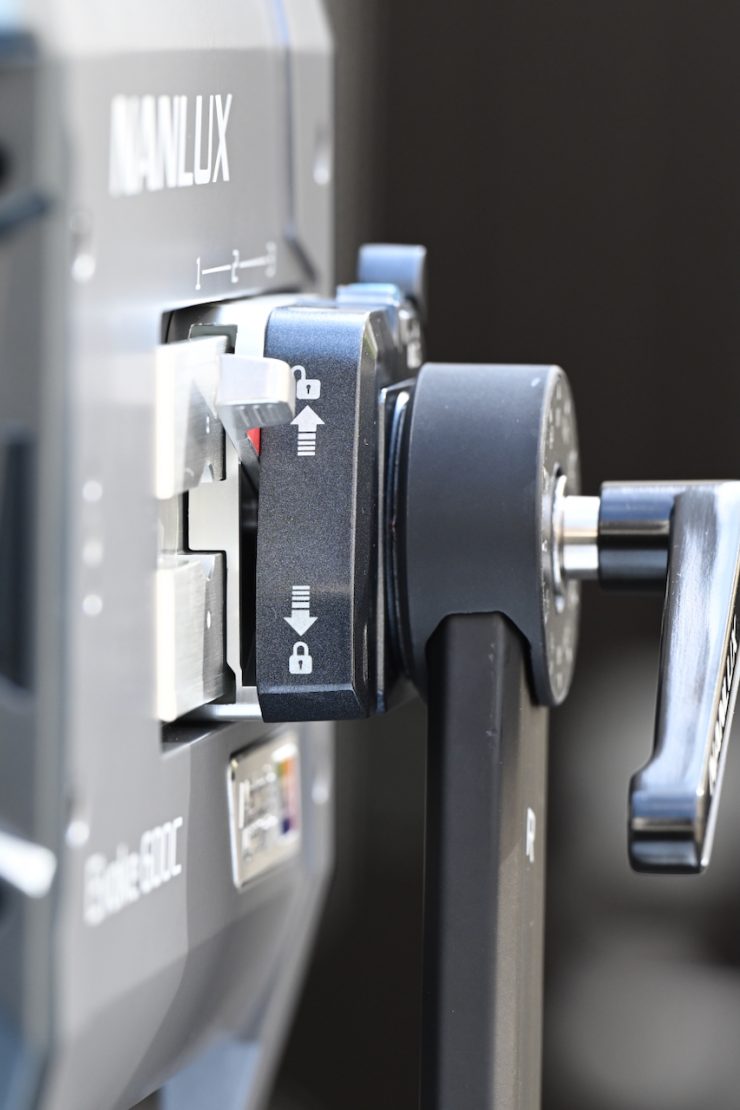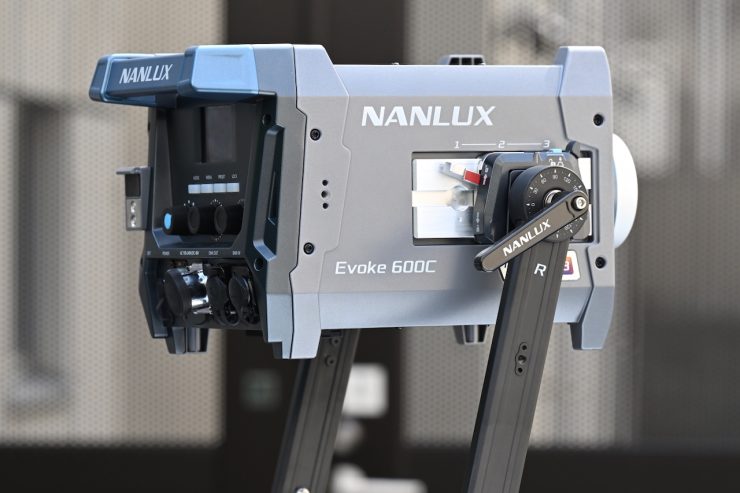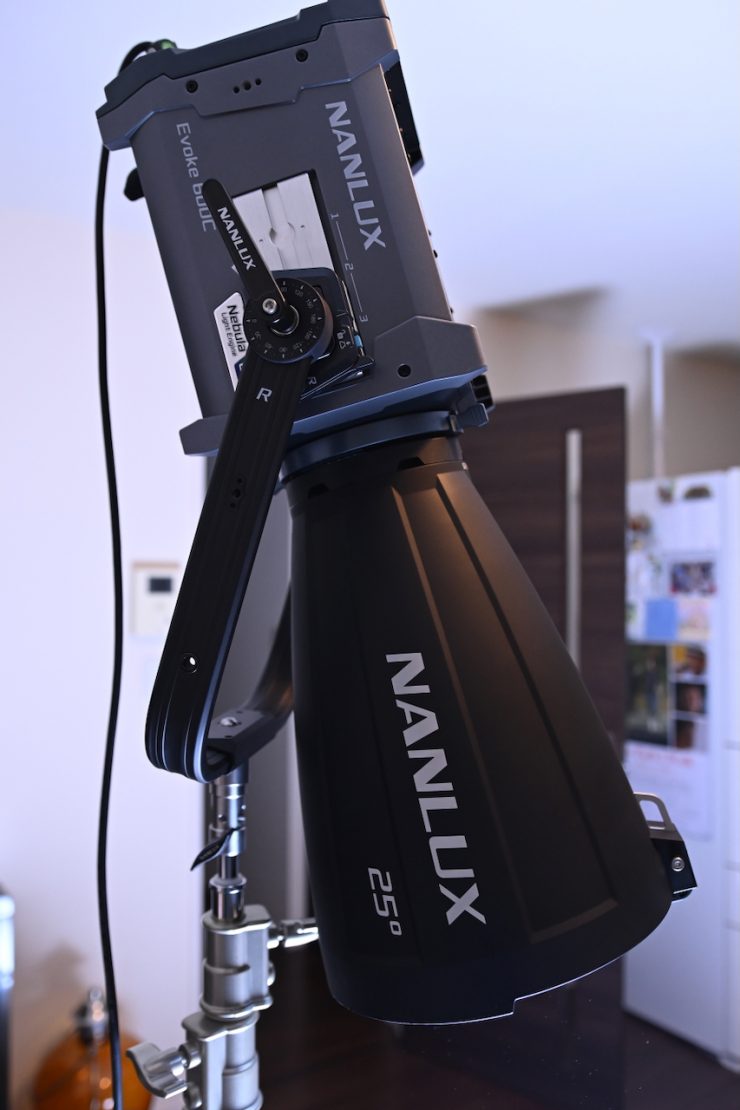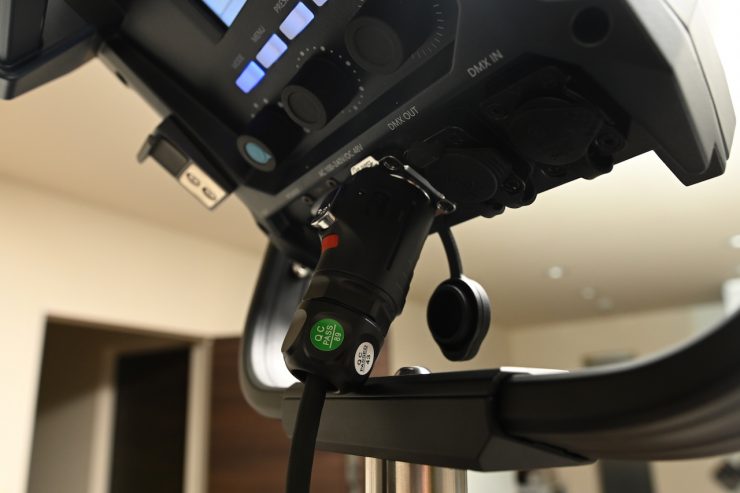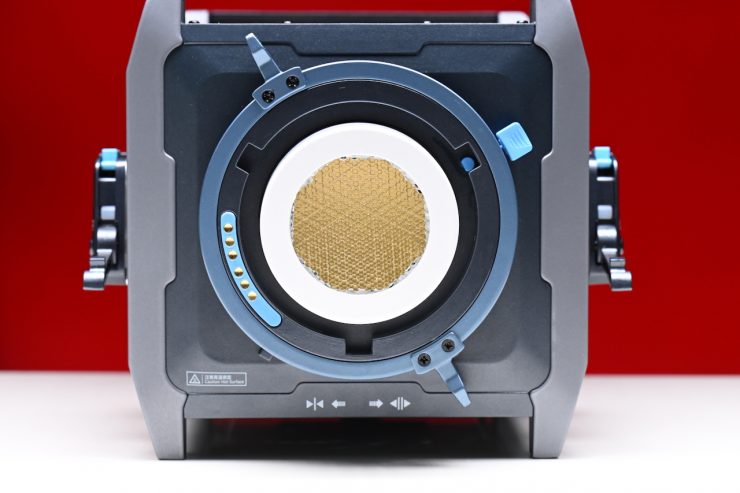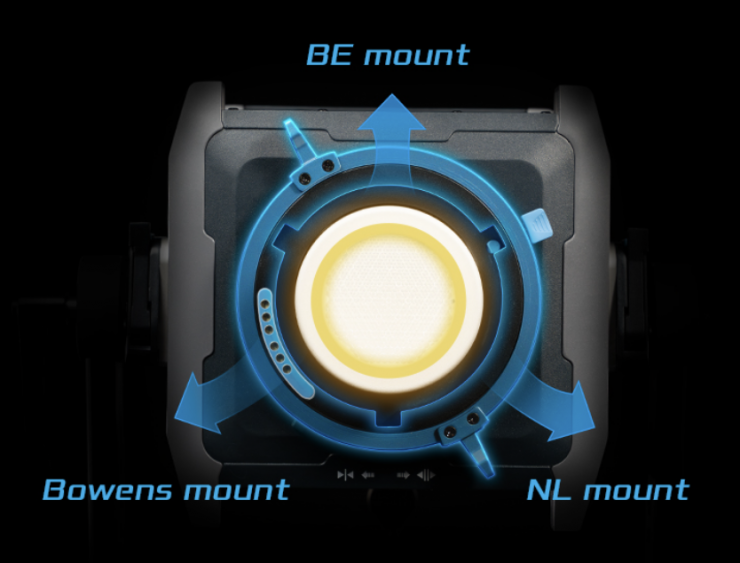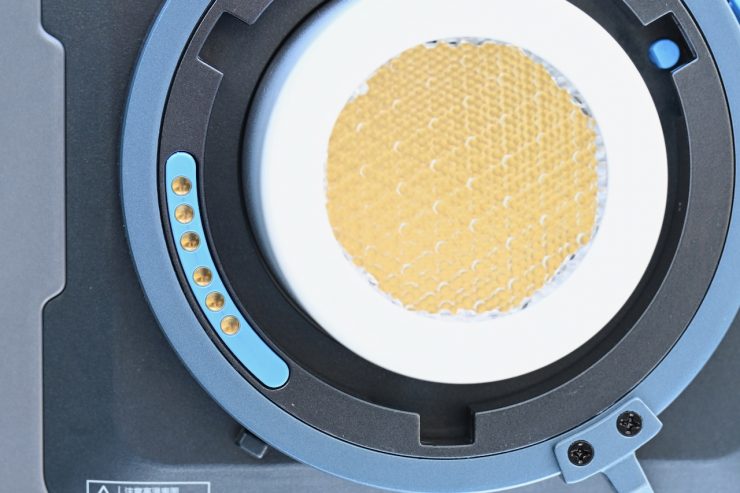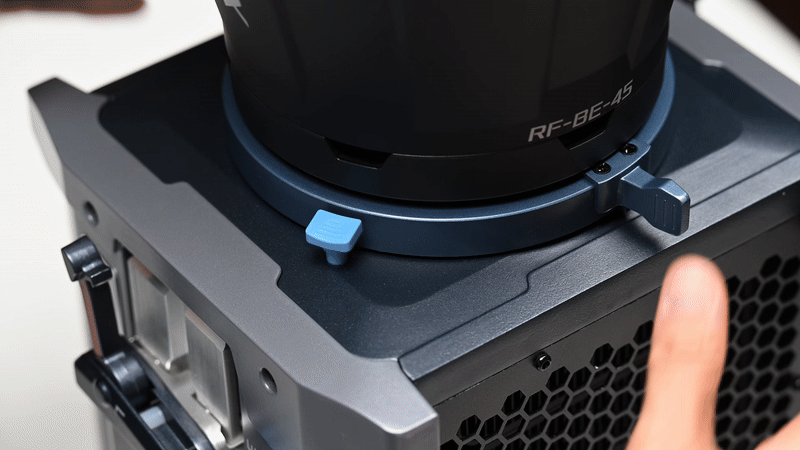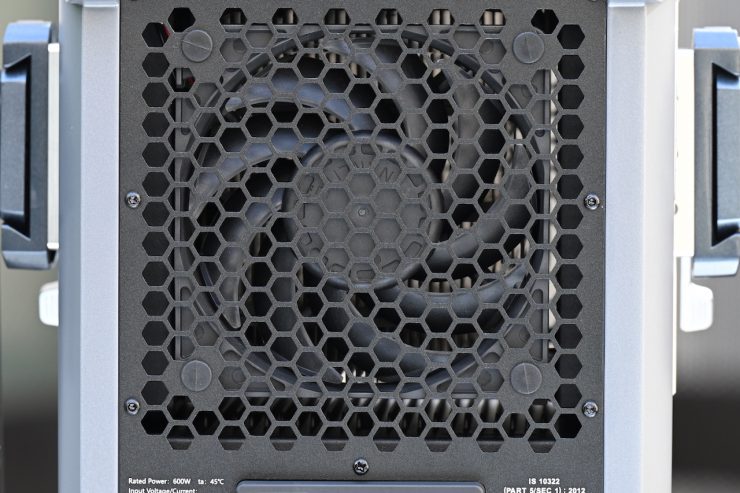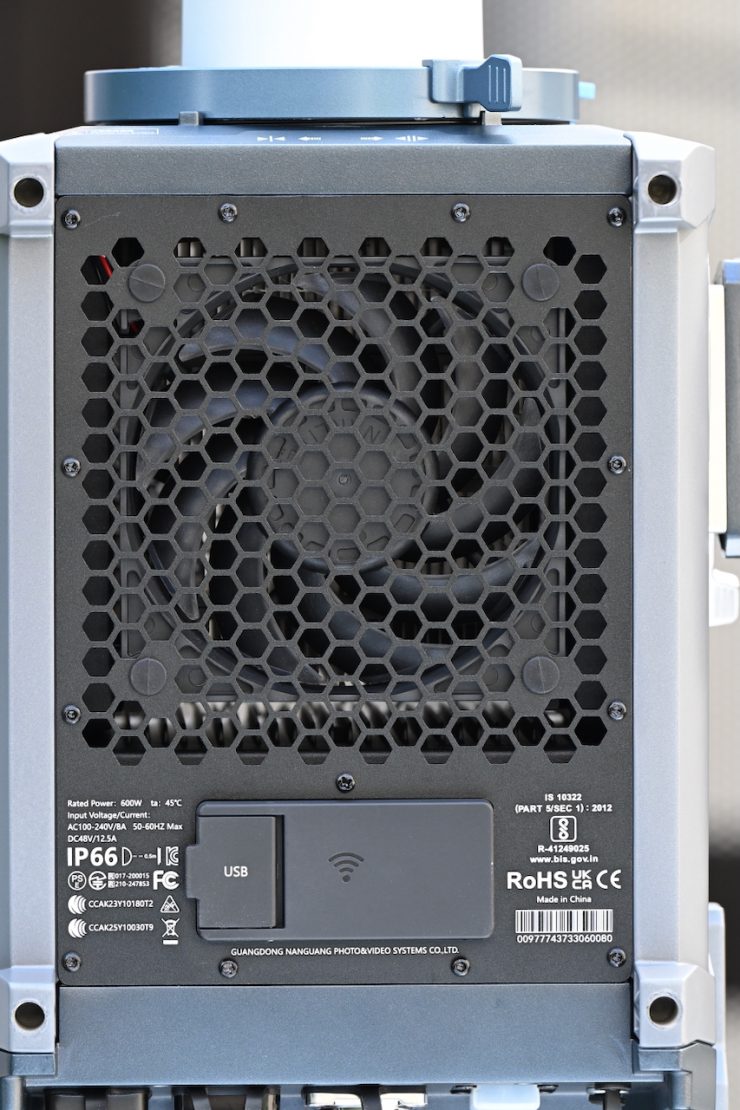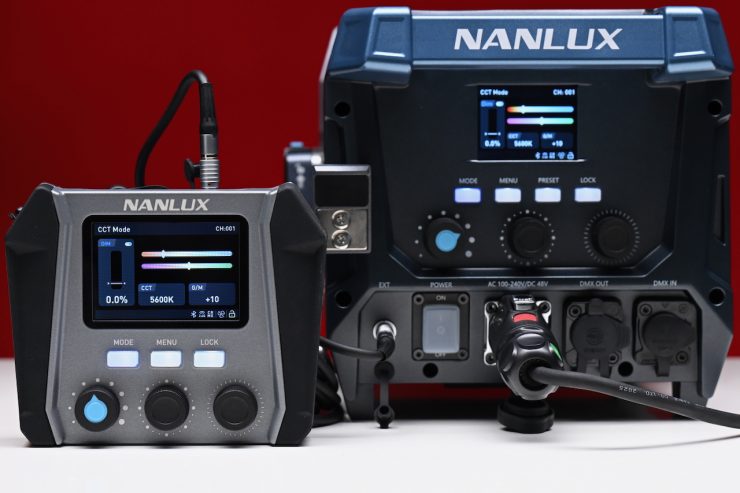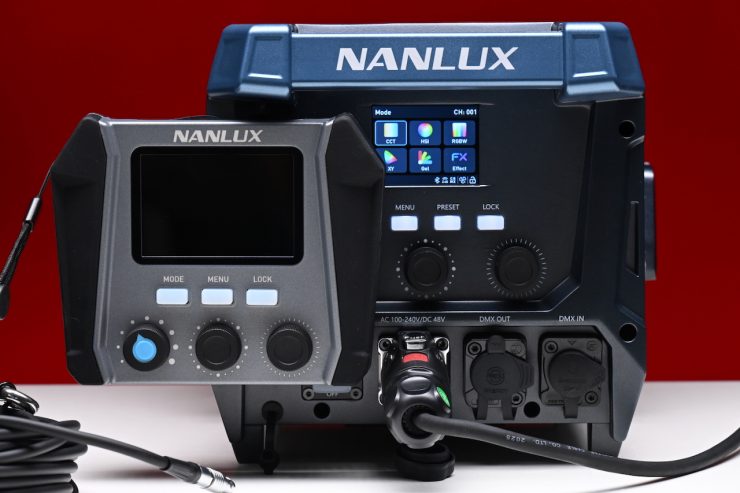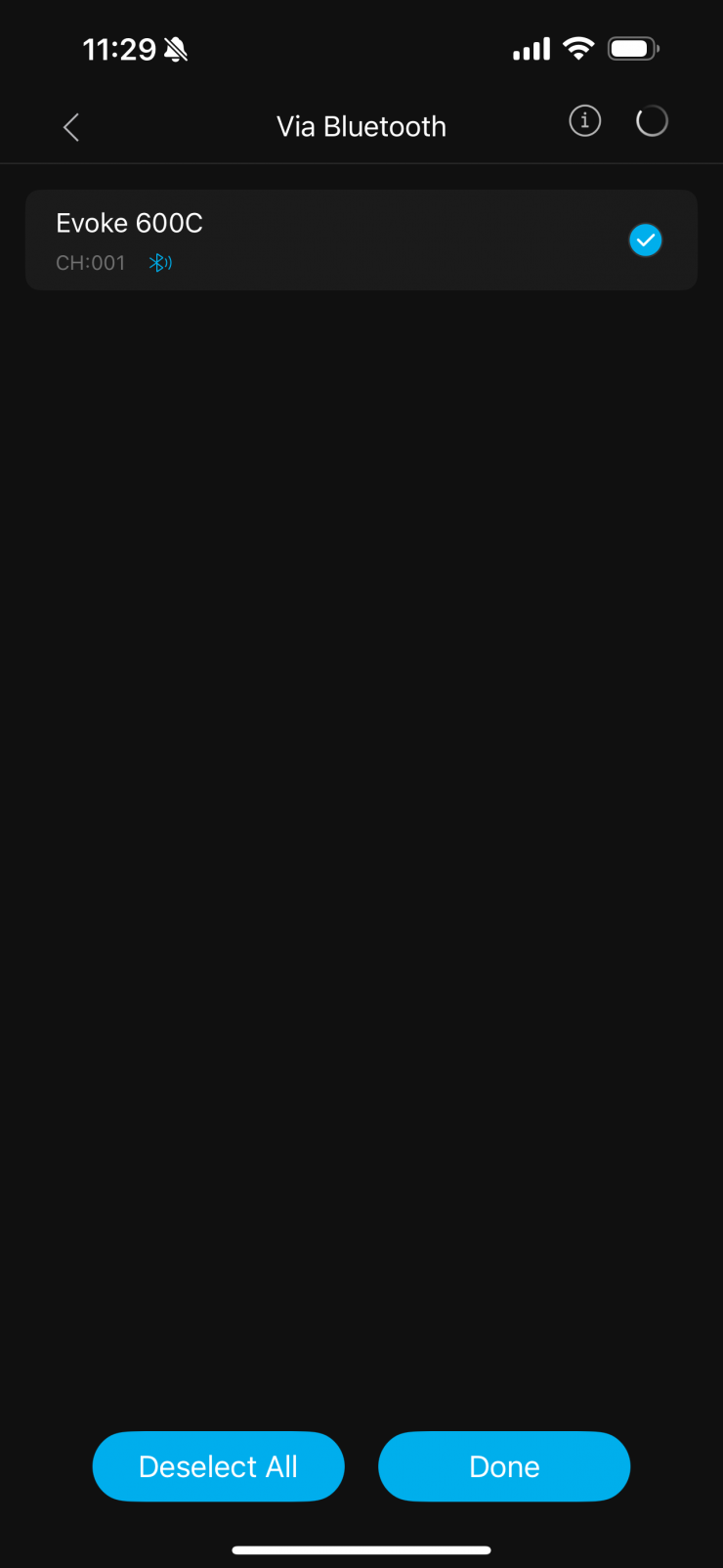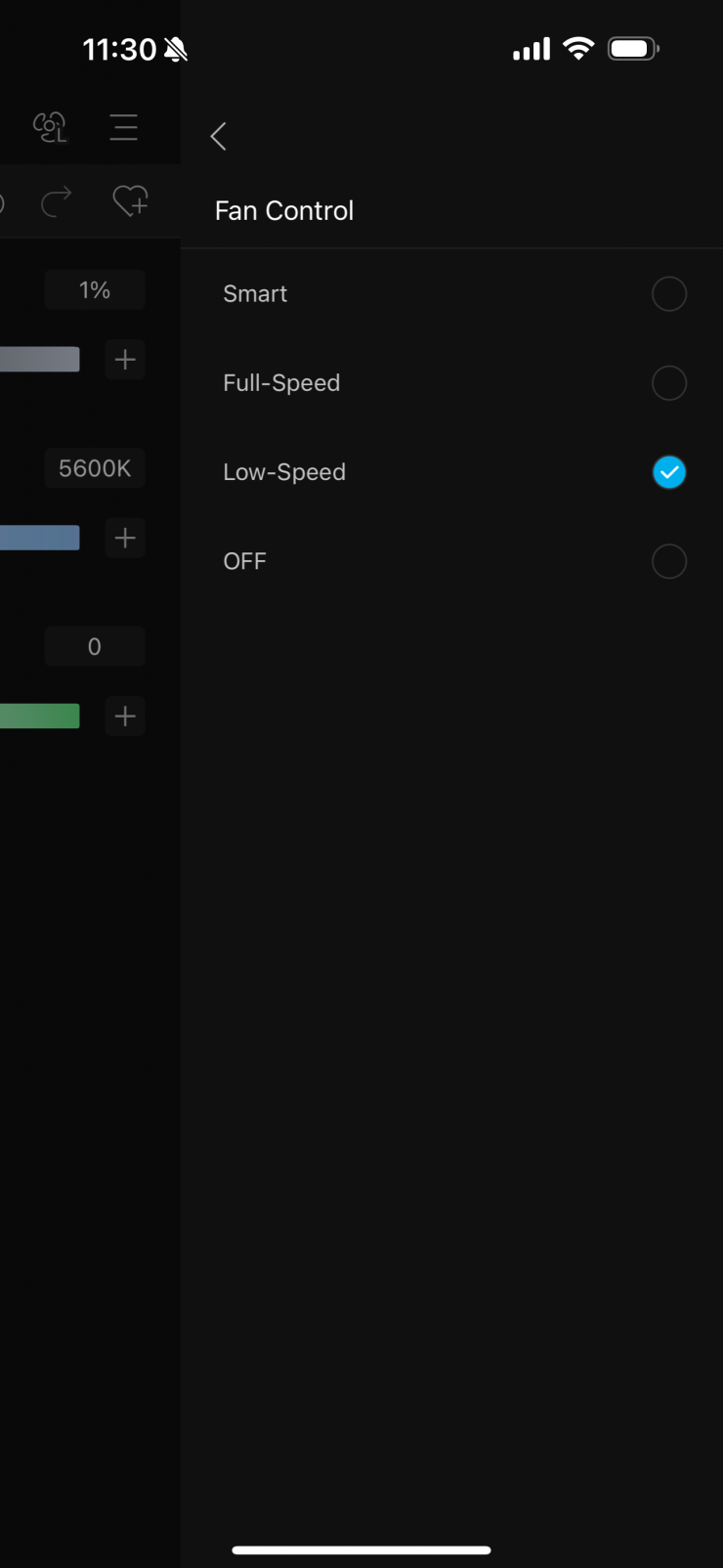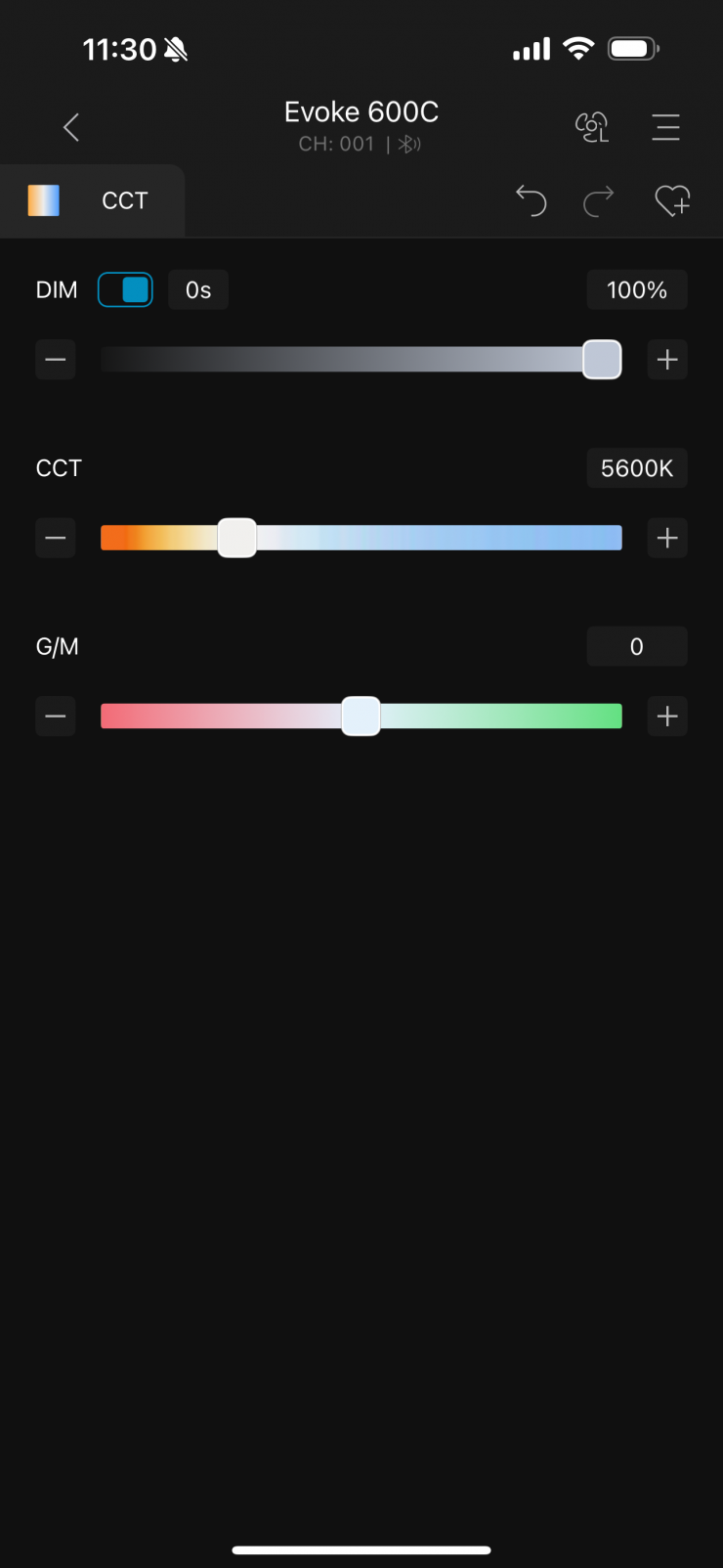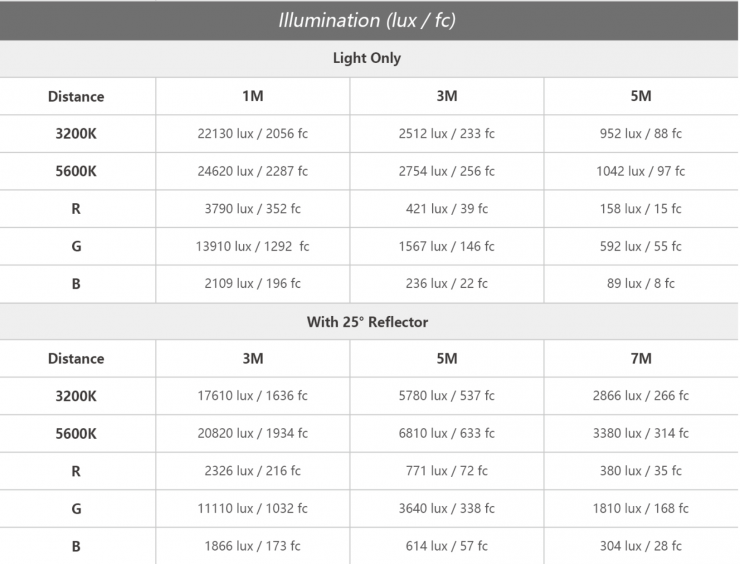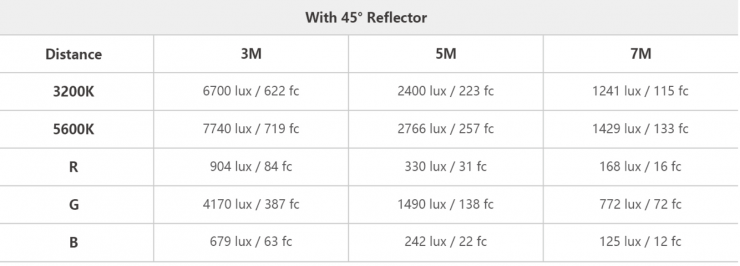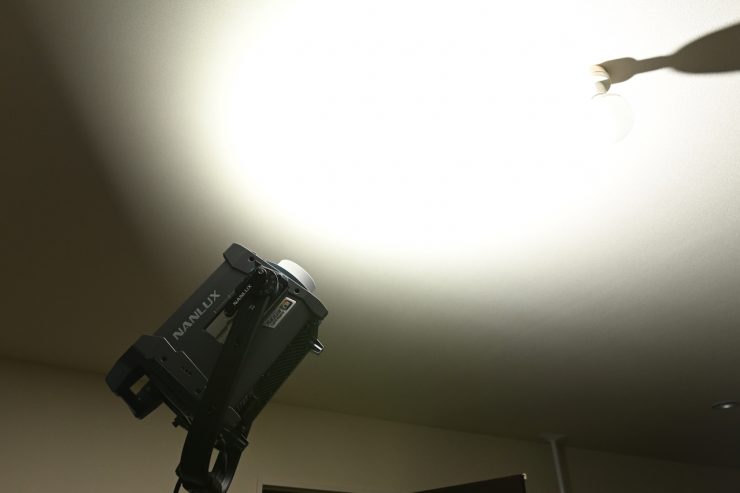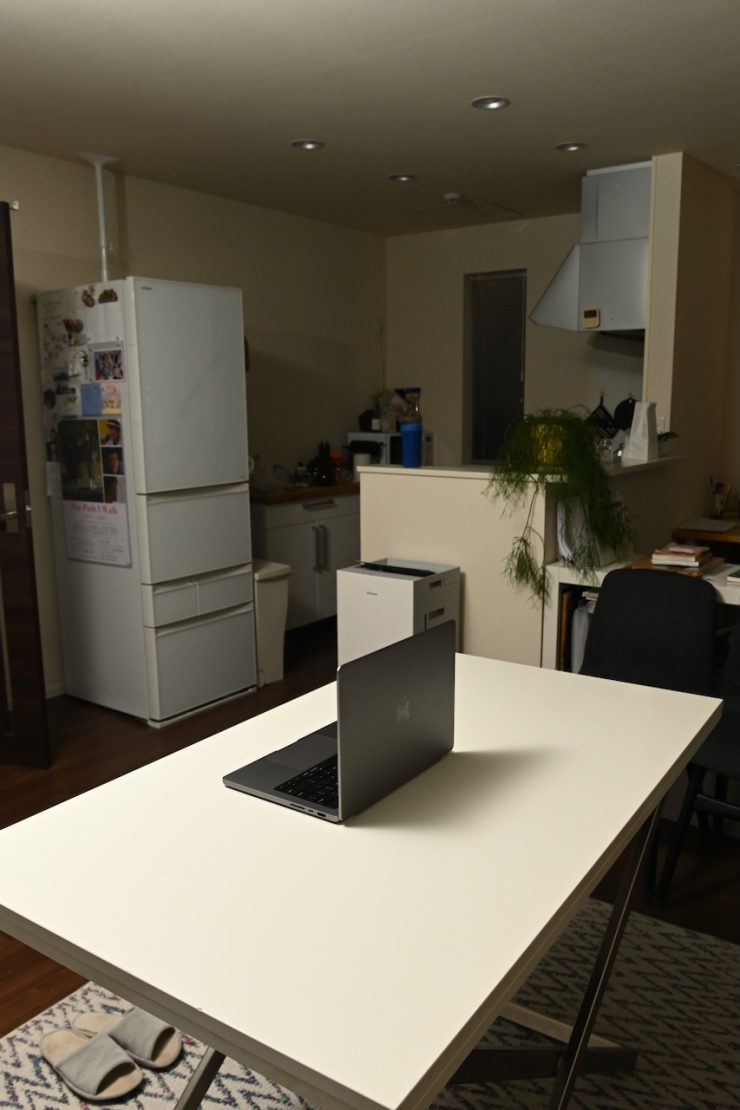NANLUX Evoke 600C Review – Newsshooter

NANLUX recently announced its new Evoke 600C, a 600W full-color light with a new 8-color Nebula C8 light engine.
On paper, this looks to be a very impressive fixture, and it is good to see NANLUX release some smaller-sized Evoke fixtures, as they are likely to appeal to a much wider audience than larger and more power-hungry fixtures. I previously reviewed the smaller EVOKE 150C on the site, and you can read that review here.
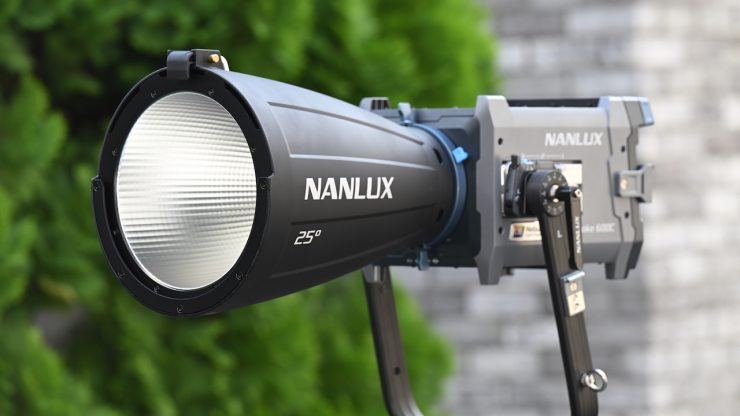
In recent years, we have seen lighting companies chasing high output, and while there is nothing wrong with that, ultimately, it’s the quality of the light that arguably matters the most. For a lot of owner/operators, lights in the 300-600W power draw range tend to be the sweetspot between size & weight, output, and power draw.
Key features
- Light, Trolley Case & Wired Controller
- Output: 24,620 Lux at 3.3′ (5600K)
- 1000-20,000K CCT; Full RGB Color Control
- +/- 200 Green/Magenta Tint Adjustment
- 8-Chip Light Engine & AC/DC Operation
- Onboard, DMX/RDM, CRMX & App Control
- CRI 96 | TLCI 97
- IP66 Rating & Bowens Compatibility
- Includes Yoke & AC Power Cord
- Includes 25° BE Mount Reflector
According to NANLUX, the 600W all-in-one fixture is claimed to deliver a class-leading wide color temperature range, broad color gamut coverage, excellent light quality, and precise dimming performance.
The Evoke 600C looks to be in direct competition with lights such as the Aputure 700x, Kelvin Epos 600, the now-discontinued Prolycht Orion 675 FS, Aputure LS 600c Pro, etc.
Lights in this form factor are very popular because of their versatility. We have seen the market flooded by so many similar-featured spotlights over the last few years. However, what we are now starting to see is vastly superior light engines being used.
Nebula C8 Light Engine

According to NANLUX, the Nebula C8 Light Engine is capable of delivering
exceptional light quality in both white and colored light.

Its eight colors (Deep Red, Red, Amber, Lime, Green, Cyan, Blue, Indigo), combined with an advanced mixing algorithm, enable an ultra-wide CCT range from 1,000K to 20,000K, which at least to my knowledge, is the widest range currently available. It also features a ±200 Green/Magenta adjustment, broader color gamut coverage, and claimed higher saturation.

NANLUX states that when compared to conventional color engines, the Nebula C8 achieves superior fidelity and skin tone accuracy in white light.
Looking back at light source technology, NANLUX and the industry have progressed in color fixtures from 4-color and 5-color solutions (RGBW/RGBWW) to 6-color systems (RGBLAC), and in bi-color fixtures from traditional Warm White & Cool White solutions to designs incorporating red and green LEDs.
With these goals in mind, NANLUX redefined its technological direction and embarked on a path of research and development that ultimately created the Nebula Light Engine.
With the Nebula Light Engine, NANLUX aims to provide users with a more precise, efficient, and safer creative experience.
The Nebula C8 is the first color light engine in the Nebula light engine series. The Nebula C8 Full Color Light Engine is the industry’s first eight-color light engine, which is claimed to achieve full coverage of the entire visible spectrum. With NANLUX’s proprietary color-mixing algorithm, its eight colors are said to be precisely balanced and seamlessly blended, delivering a wider CCT range and a broader color gamut.
The Nebula C8 is an evolution of NANLUX’s RGBLAC six-color light engine. The Nebula C8 builds on this with the addition of two more colors – deep red and indigo. This fills the gaps found in traditional color light engines, producing a more complete spectrum and offering a wider range of color temperatures and richer colors.
With the addition of the color deep red, the Nebula C8 Color Light Engine achieves the industry’s widest CCT range of 1,000K-20,000K, fully covering all color temperature needs in production.
The low end of Nebula C8’s CCT range has gone to 1000K, far below the color temperature of sunrise or candlelight, delivering exceptional capability for shaping ultra-warm tones.
In addition to the ultra-wide CCT range, the Nebula C8 also supports +/-200 green/magenta adjustment across its entire color temperature range, allowing users to fine-tune the tint at any color temperature with precision.
The natural rendering of human skin tones depends on the fixture’s full coverage of the red spectral range. However, in most color light engines available in the industry, the red spectrum leans toward orange, making skin tones appear pale and less natural both to the eye and on camera.
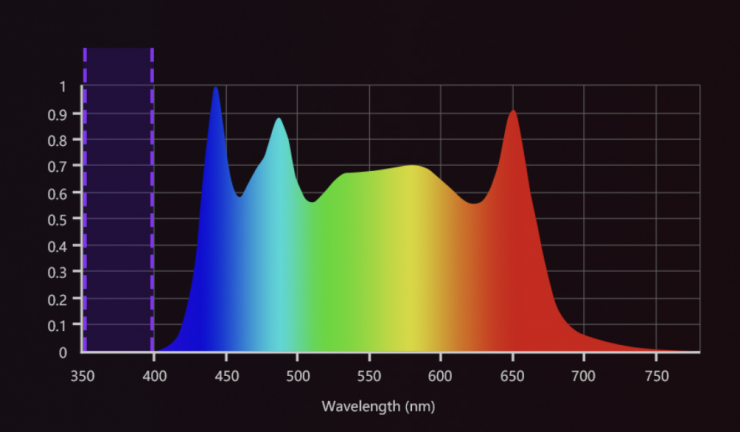
The Nebula C8 extends its original 645 nm red color with an added 665 nm deep-red color. This extends coverage across the red spectrum, delivering what NANLUX states as richer, healthier skin tones with a natural vibrancy.

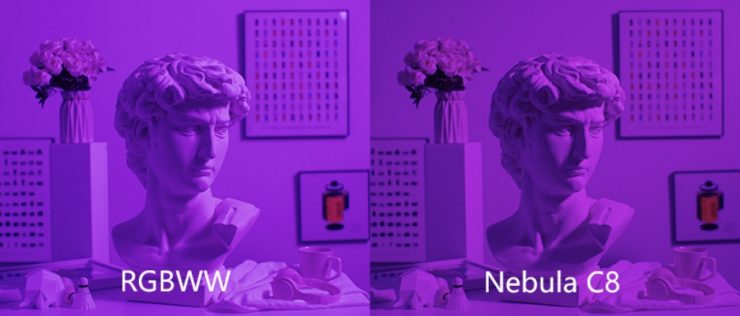
Compared with RGBW and RGBWW, Nebula C8 is claimed to deliver smoother and more accurate RGB transitions, addressing the common color distortion issues seen in traditional light engines during color blending.
Safety is always a top priority for NANLUX, both on-set operational safety and the user’s health. These were also taken into account during the development of the Nebula C8 Light Engine. After carefully refining its spectral distribution, the indigo LED has been engineered to eliminate ultraviolet wavelengths below 400 nm, thereby avoiding UV hazards to the skin and eyes of crew and talent on set, and ensuring safer, prolonged lighting use.
-
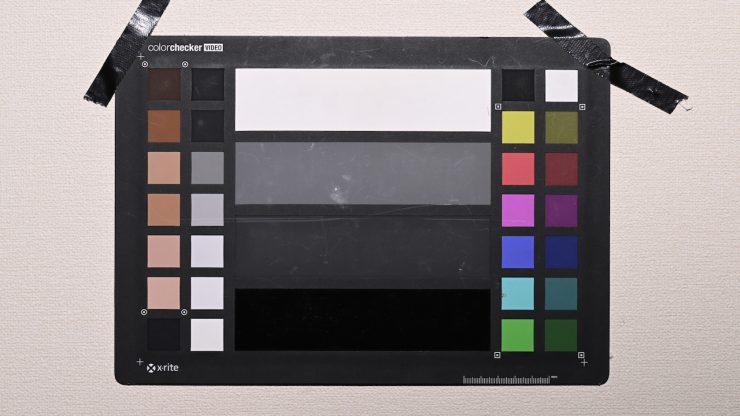
Preset 5600K WB -

Camera WB
Above, you can see a comparison test where I set the Evoke 600C at 5600K and then used a preset 5600K white balance on the camera. I then did the same shot again after doing a white balance on the camera.
-
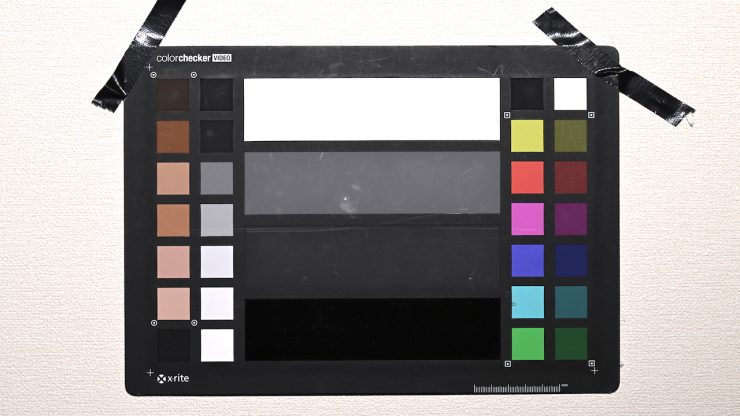
Preset 3200K WB -

Camera WB
Above, you can see a comparison test where I set the Evoke 600C at 3200K and then used a preset 3200K white balance on the camera. I then did the same shot after doing a white balance on the camera.
What I found interesting was that with the preset 5600 WB on the camera, the light leaned slightly magenta, but after doing a WB, it pushed slightly green. At 3200K, it did a similar thing, but it was more subtle.
How does the Nebula C8 light engine differ from the Aputure BLAIR-CG Light Engine?
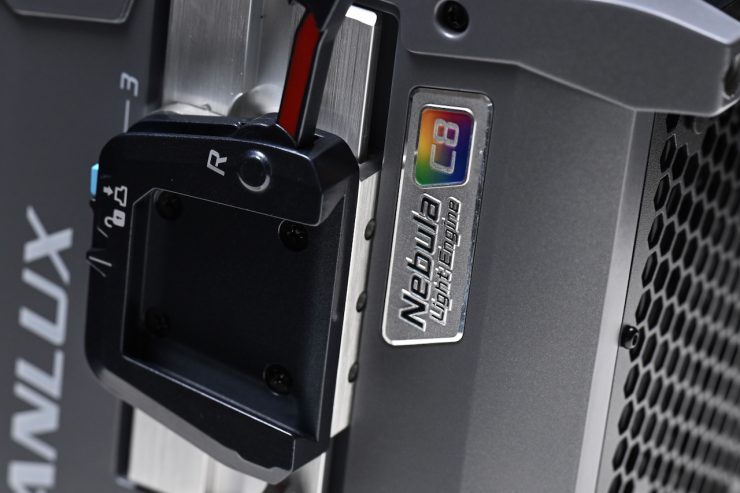
The NANLUX Nebula C8 light engine is quite different from the Aputure BLAIR-CG Light Engine.
Like the BLAIR light engine found in the STORM tunable white lights, the BLAIR-CG light engine includes a calibrated indigo emitter, which emulates the near-UV light of real daylight and tungsten. This activates the natural fluorescence of various fabrics, plant life, and other materials, thereby replicating the effect of natural light. White fabrics can appear whiter, colors more vibrant, and all surfaces in general will appear the same as they do under natural light.
The BLAIR Light Engine in the STORM 1200x utilizes blue, lime, amber, indigo, and red, LED emitters. With the new STORM 80c and 1000c, Aputure added additional cyan and green emitters. This is quite different from RGBWW or RGBACL. Lights that utilize RGBACL don’t use any white LEDs; instead, they mix all of those different color LEDs to produce white light, and that’s essentially what BLAIR is doing, too.
The light engine was designed to deliver a better quality white light to fill out the color spectrum while offering greater adjustability. The calibrated Indigo is said to enhance fluorescing materials, resulting in a higher quality white light that better matches natural daylight and black body sources such as tungsten quartz.
Adding Indigo is very interesting because the light it emits is right at the edge of our visible spectrum, and that is why engineers probably haven’t thought about doing it before; that was until now. But why Indigo? Well, not all objects or surfaces reflect light; some of them absorb it. What Aputure engineers found is that by adding an Indigo emitter, certain materials and objects retained their natural brightness and color. In practice, this actually makes quite a noticeable difference. In some of the examples I have seen, you can certainly see its benefits. The benefits will be more noticeable when using the light at daylight CCT setting as opposed to tungsten.
The human eye is only really capable of detecting wavelengths from 380 to 700 nanometers, and most LED lights don’t contain any information below around 420 nanometers. The BLAIR light engine adds information right out to 380 nanometers.
Lights like the Maxima 3. Maxima 6, or ZOLAR Vega 30C, use similar, but not the same technology.
-
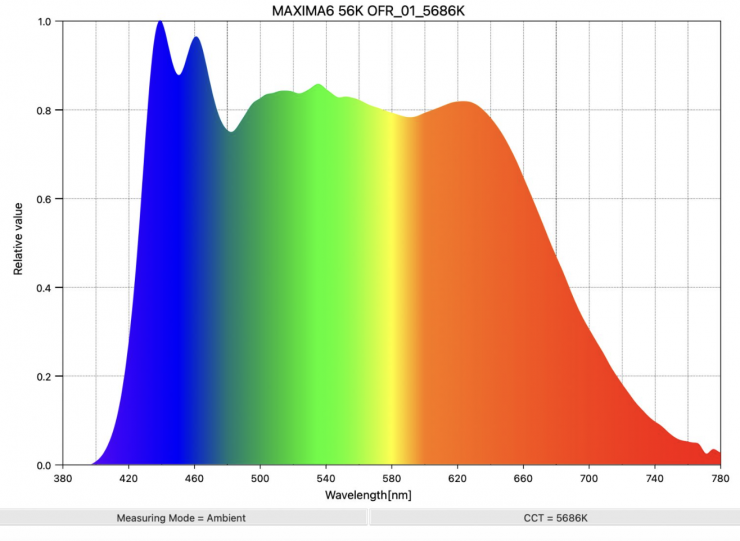
Maxima 6 GaN -
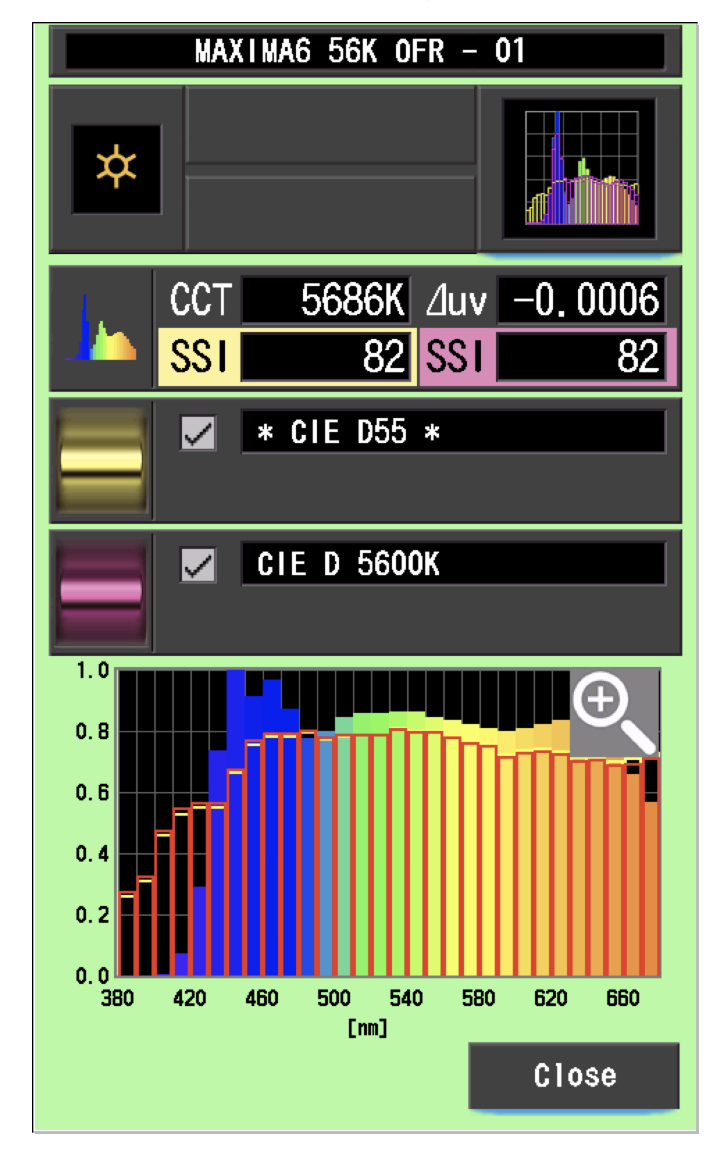
If we look above at the daylight spectrum of the Maxima 6 GaN or Maxima 3, you can see the extra blue spike at around 430nm, which is similar, but not quite the same as what you will see with the Aputure STORM 80c/1000c. The Maxima 6 GaN utilizes Gallium Nitride, which is a binary III/V direct bandgap semiconductor that is well-suited for high-power transistors capable of operating at high temperatures. Since the 1990s, it has been commonly used in light-emitting diodes (LEDs). Gallium nitride gives off a blue light used for disc-reading in Blu-ray.
Now, what you clearly need to remember is that the Maxima 6 GaN and Maxima 3 are daylight-only (5600K) fixtures.
If we have a look at a full-spectrum fixture that is doing something similar, in this case, the ZOLAR Vega 30C, you can see there is extra information at around 400nm. You can also see why this translates to high SSI scores.

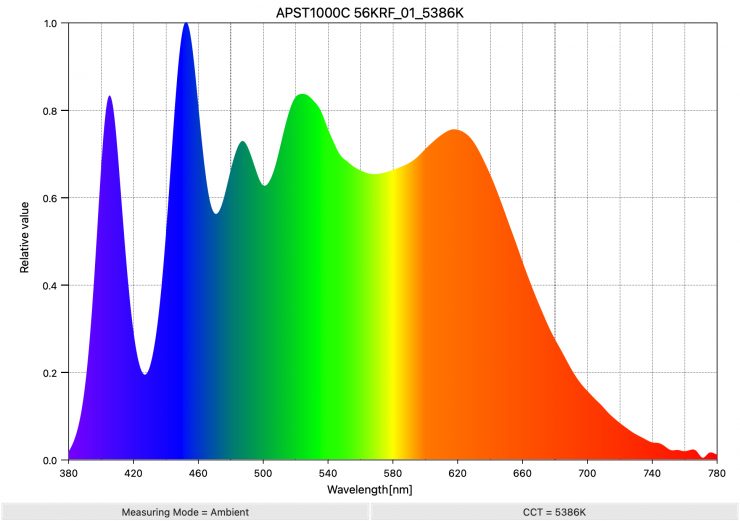
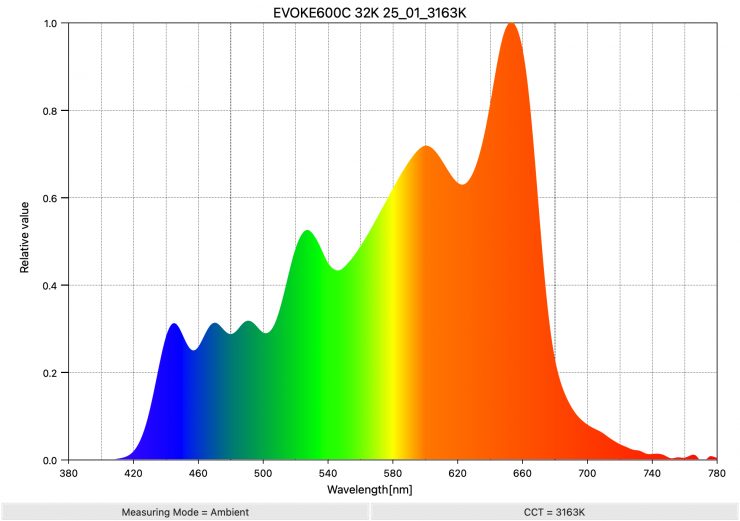
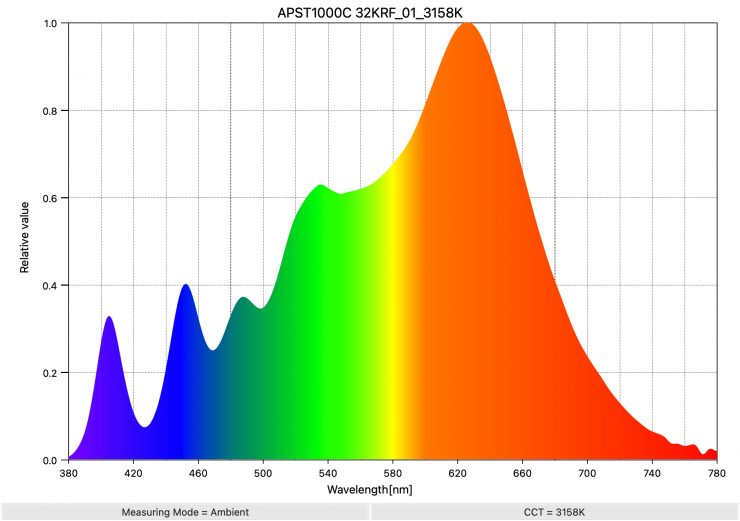
Above, you can see the spectral response of the Aputure STORM 1000c and the NANLUX Evoke 600C, both at 3200K and 5600K. As you can see, the spectral responses are vastly different. Aputure has added information at the 380-420nm edge of the spectrum, while NANLUX has added more information at the 640-680nm part of the spectrum.
-
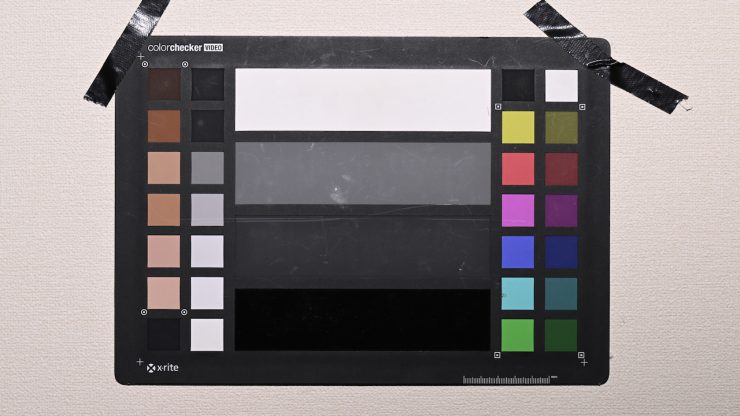
NANLUX Evoke 600C Preset 5600K WB -
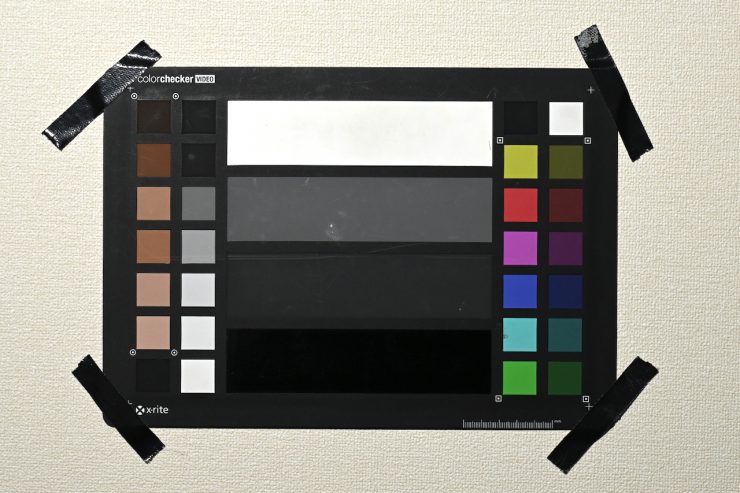
Aputure STORM 1000c Preset 5600K WB
Now, let’s do a test where we compare the NANLUX Evoke 600C against the Aputure STORM 1000c at a preset 5600K camera white balance. Both lights were set at 5600K. Yes, they are different lights with different power draws, but we are solely looking at how the light engine works here.
-

NANLUX Evoke 600C Preset 3200K WB -
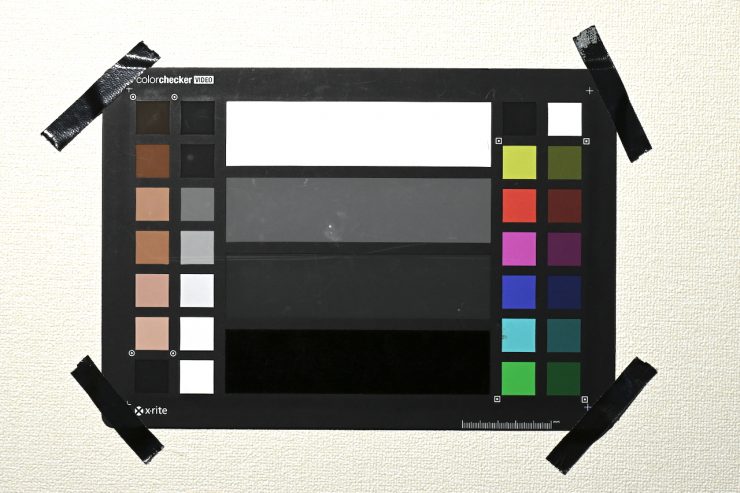
Aputure STORM 1000c Preset 3200K WB
Let’s now do that same comparison again, but this time with a 3200K preset camera white balance. Both lights were set at 3200K
-
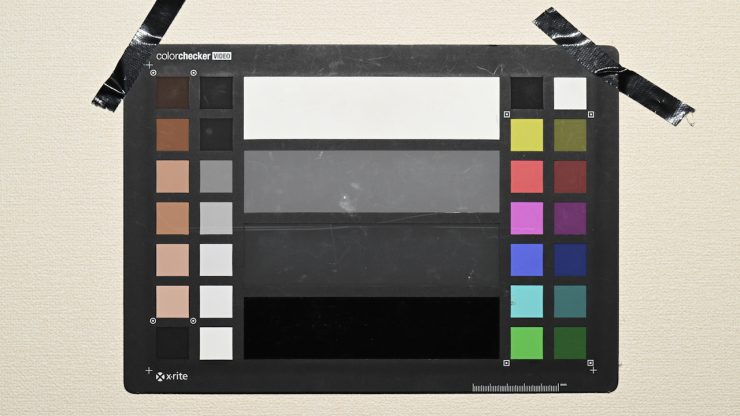
NANLUX Evoke 600C WB -

Aputure STORM 1000c WB
Ok, let’s see what happens if we do a camera white balance when the lights are set at 5600K.
-
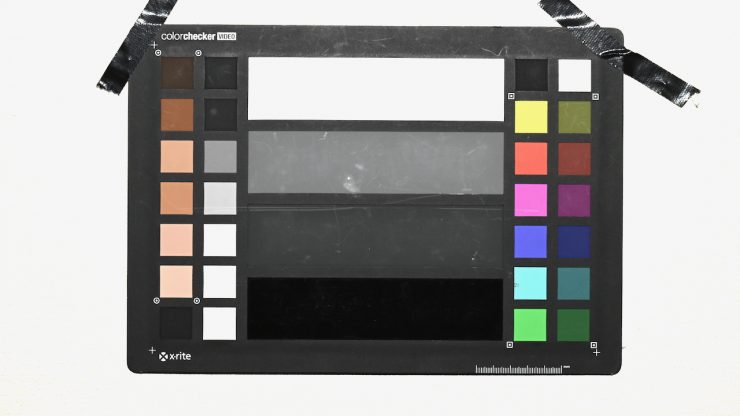
NANLUX Evoke 600C WB -
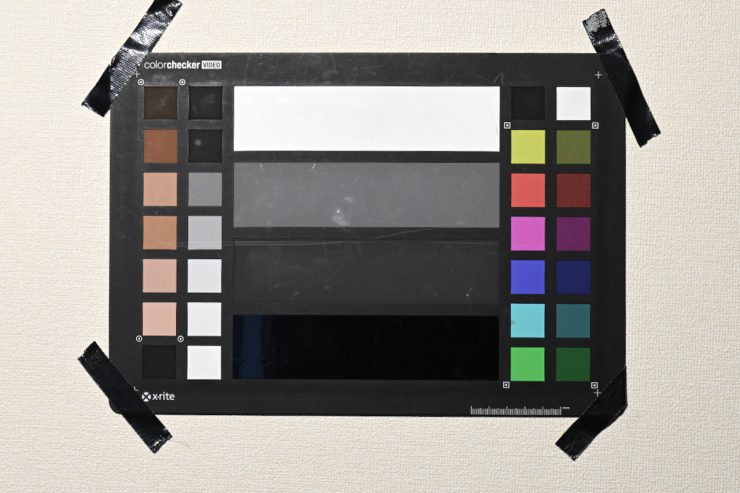
Aputure STORM 1000c WB
Ok, let’s see what happens if we do a camera white balance when the lights are set at 3200K.
When you do a camera white balance, there is a slight difference between the two images, especially when it comes to the color of the back wall. There are also slight differences if you look at some of the individual color tiles.
Concept

The concept behind the NANLUX Evoke 600C was to create a fixture that was designed to push the boundaries of cinema lighting. NANLUX set out to make a well-built, very flexible, fully-featured lighting source with a lighting engine that could deliver fantastic white light, as well as colored light.
You can only make a COB spotlight in a certain form factor, so in that regard, the Evoke 600C looks reasonably similar to a lot of other competing LED spotlights.
In some respects, the NANLUX Evoke 600C is almost what the ARRI Orbiter should have been. This is not to throw any shade on ARRI, but the Orbiter wasn’t bright enough for its size and weight; it didn’t have enough lighting modifiers available at launch, and it was arguably too expensive.
What do you get?
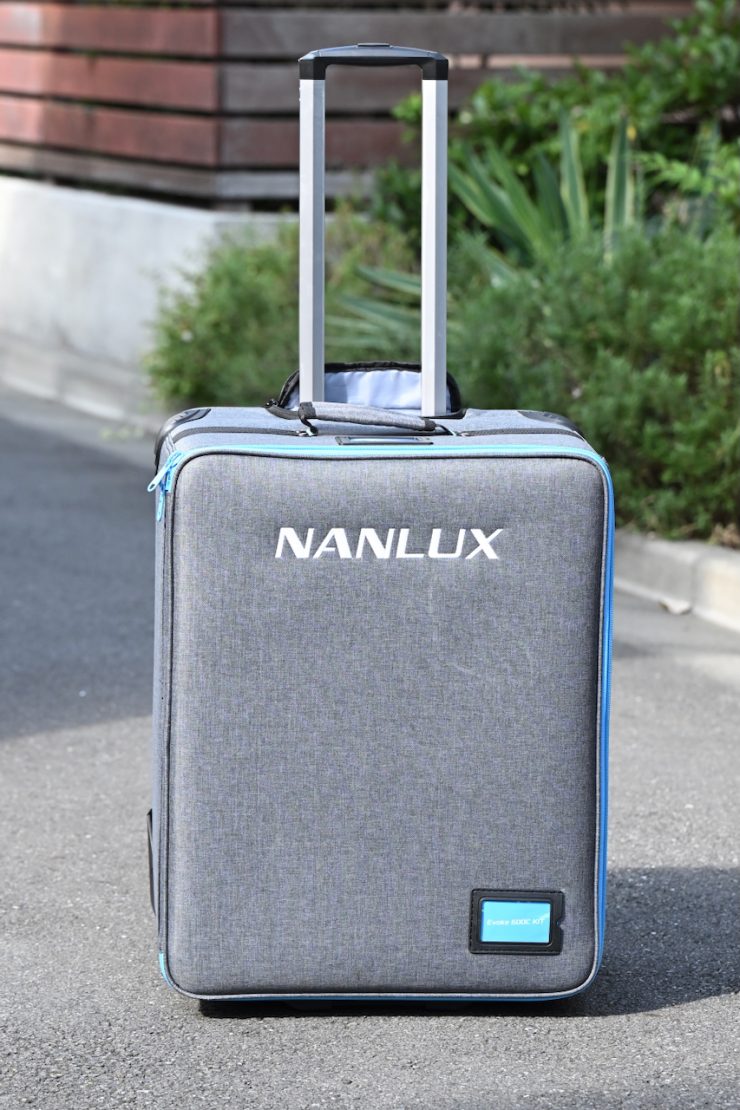
In the Nanlux Evoke 600C RGB LED Spot Light (Trolley Case Kit) that I will be reviewing, you get the following items:
- Nanlux Evoke 600C RGB LED Spot Light
- Yoke
- BE Mount Reflector (25°)
- AC Power Cable (19.6′)
- USB Flash Drive
- Magnetic Base
- Wired Controller
- Connection Cable (26.2′)
- Trolley Case
Build Quality & Design
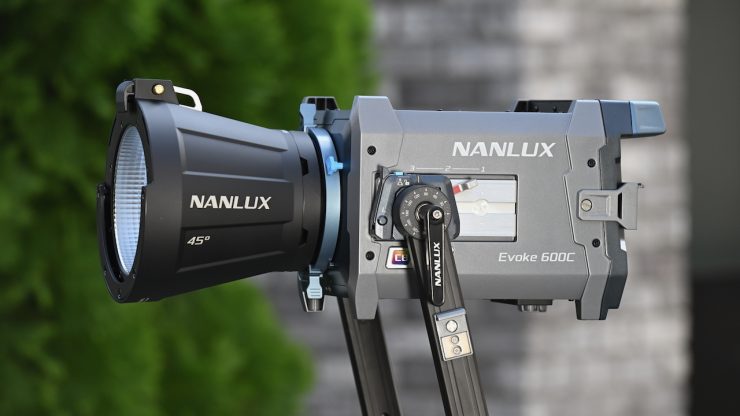
The Evoke 600C light is really well-made and constructed, and you can tell that a lot of thought and care went into the design. The build quality of NANLUX and Nanlite products has continued to improve over the years.
The design of the Evokle 600C was developed to be robust, reliable, and practical. The fixture’s all-in-one magnesium-alloy housing makes it light, easy to transport, and durable. The light was not only made to be robust, but its modular design also facilitates repairs if needed.

Unlike most similar fixtures, where there is a separate light head and power supply/controller, the Evoke 600C is a fully self-contained unit. This has its pros and cons. While having a single all-in-one unit takes away complexity, it does mean that you need to use heavier-duty lightstands, and it is harder to make on-board changes if the light is at a certain height.
Having multiple components can be a pain, but it does allow you to use smaller-sized light stands because you don’t have all the weight sitting just on the fixture itself. It also helps with cooling and minimizing any noise. You can’t have your cake and eat it too. Lighting manufacturers need to balance weight and size with power draw and efficiency.
The Evoke 600C also features an IP66-rated design that protects the fixture from dust, water, rough weather, and demanding environments.
It is nice that NANLUX includes a 19.6′ long AC power cord with the fixture.

Small touches like putting degree angle markings when you adjust the yoke frame are something you just don’t see on many other fixtures. This is where the attention to detail starts to show.
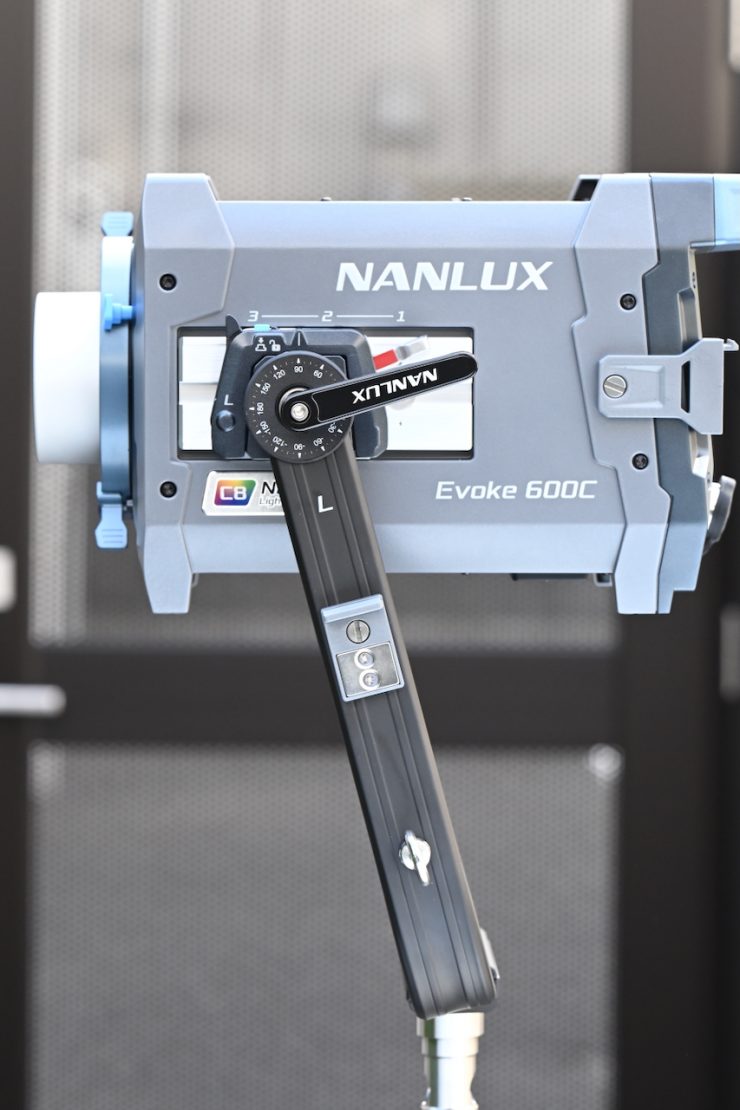
The yoke frame is well-made and exceptionally strong.
It can easily hold large lighting modifiers.
-

-

The included rolling case that comes with the light kit I was reviewing is decent enough. The retractable handle doesn’t wobble around and flex, and the wheels are solidly made.
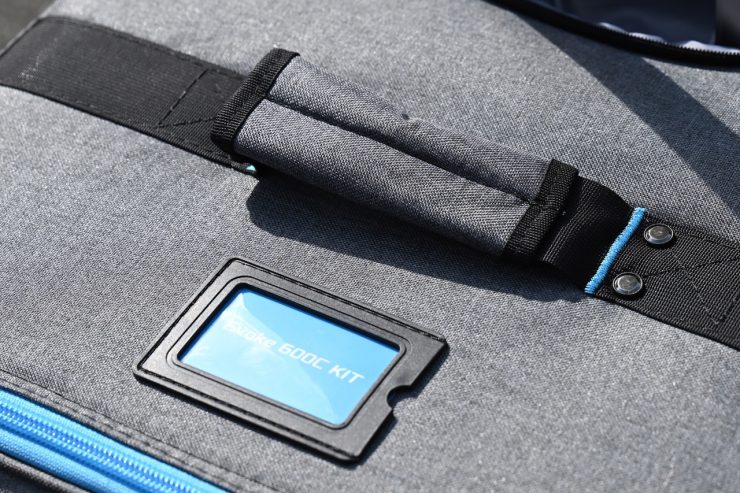
The only minor complaint I had with the case is that there is only one carry handle on it.
The Evoke 600C, like so many of the new lights coming to market, is an example of blending software and hardware. With software playing such a big role, lighting companies can continue to improve and update fixtures over time via firmware updates. This does give them somewhat of an advantage over older fixtures. There are so many lights on the market where manufacturers make a big deal about them being firmware upgradable, and then never release a single update. It will be interesting to see if NANLUX releases firmware updates going forward.
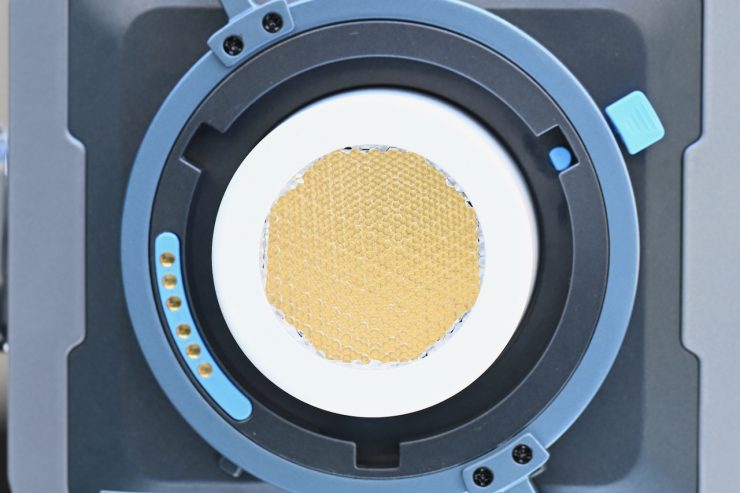
Quite a few LED lights on the market, including the Evoke 600C, are using COB technology. COB stands for “Chip On Board” where multiple LED chips are packaged together as one lighting module. The advantage of COB LEDs being multi-chip packaged is that the light-emitting area of a COB LED can contain many times more light sources in the same area that standard LEDs could occupy. This results in a greatly increased lumen output per square inch. The caveat with COB LEDs is that they produce a ton of heat, and that heat needs to be effectively dispersed. In a lot of situations, you also need to diffuse them as they are very bright to look at and unsuitable for directly lighting talent.
Quick Release Yoke
The side of the Evoke 600C has a new tilt-locking mechanism with an angle indicator to simplify repeat alignment. The offset design of the mechanism expands tilt range for large lighting modifiers.
The locking mechanism is well-made and relatively easy to use, and it allows you to quickly separate the light head from the yoke frame.
The yoke is offset with a dual-side locking mechanism and additional 1/4” -20 and 3/8” threads for accessory mounting.
Balance-adjusting rails allow the light to be moved forward and backward on the yoke to achieve better balance with different accessories attached.
NANLUX has also thought about how the light may be used and rigged, and they have put 1/4″-20 threads with anti-twist design on both sides of the fixture.
They can also be used to provide additional mounting points to secure the light even more in scenarios with increased risk of it falling, such as shooting inside a moving vehicle.
NANLUX also put a magnetic mounting attachment on the side of the yoke frame for the remote controller, as well as a laynard hook for a safety strap.
The light can be angled down at quite a steep angle, but if you are pointing it up, the power cable will hit the yoke frame, which somewhat limits the angle.
Weight & Size

The Evoke 600C has an all-in-one design that integrates lamp head, control unit, and power supply into a single 7.26 kg / 16.01 lb unit, measuring 358 x 246 x 205 mm /14.1 x 9.7 x 8.1″.
Having a fixture of this output and power draw that only weighs 7.26 kg / 16.01 lb is impressive.
So, how does this weight compare to some other similar fixtures?
| | TOTAL WEIGHT |
| NANLUX Evoke 600C | 7.26 kg / 16.01 lb |
| Aputure STORM 700x | 9.25 kg / 20.39 lb |
| Kelvin Epos 600 | 12.18 kg / 26.85 lb |
| Prolycht Orion 675 FS | 12 kg / 26 lb |
| Aputure LS 600c Pro II | 11.3 kg / 24.9 lb |
| Aputure STORM 400X | 6.95 kg / 15.31 lb |
| ARRI Orbiter | 11.7 kg* / 25.8 lbs |
| Aputure LS 600x Pro | 10.05 kg / 22.15 lb |
| Nanlite Forza 720B | 9.5 kg / 20.94 lb |
| Nanlite FC500C | 6.14 kg / 13.53 lb |
| Godox LITEMONS LA600R | 5.1 kg / 11.2 lb |
| COLBOR CL600R | 8.2 kg / 17.8 lb |
| Falcon Eyes S600CPro | 9.95 kg / 21.71 lb |
| HIVE LIGHTING Super Hornet 575-C | 6.12 kg / 13.5 lb |
* Doesn’t include the weight of the yoke frame
If you are travelling a lot, every kg or pound you can save helps, especially if you are flying.
The Evoke 600C, in its included rolling case, with all of the accessories that come with it, weighs 14.9 kg / 32.84 lb.
BE Mount
The Evoke 600C features the new BE mount (with electronic contacts), which can recognize accessories and correct color casts, also power the motorized attachment.
The fixture can still illuminate when mounted on an accessory without electronic contacts. It is also compatible with the Bowens mount accessory ecosystem and the NL mount accessories via the NL to BE mount adapter.
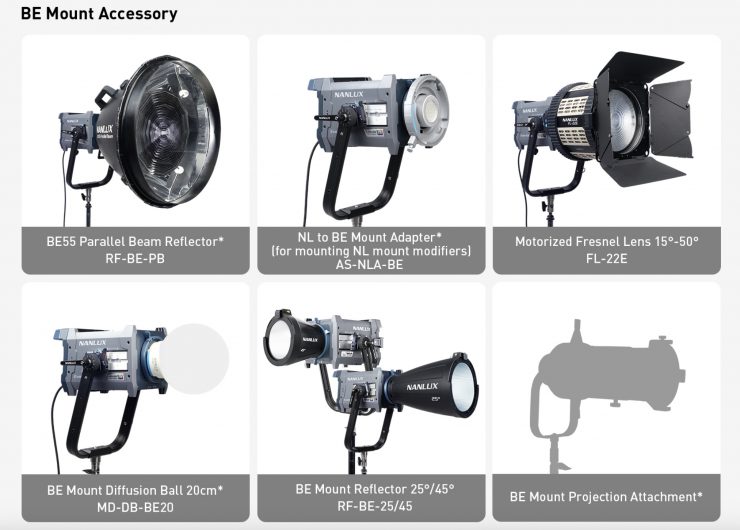

Above, you can see some of the lighting modifiers that will work with the Evoke 600C.
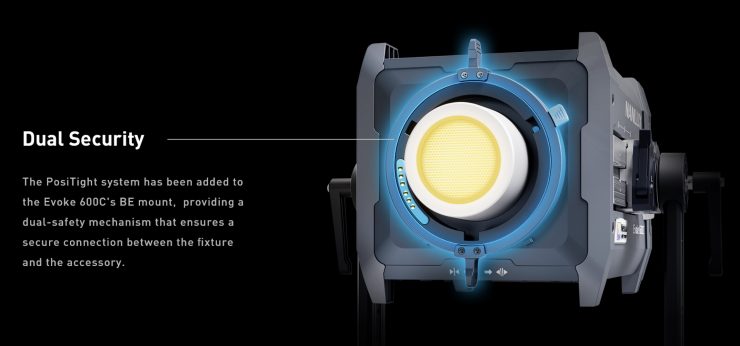
The BE-mount has NANLUX’s unique PosiTight locking system to eliminate movement and provide additional security to modifiers.
The PosiTight locking system works in a similar way to Aputure’s ProLock, however, as I previously mentioned, it utilizes a dual safety system.
Above, you can see how it works.
It is essentially like a PL locking mechanism for lights.
Power Draw
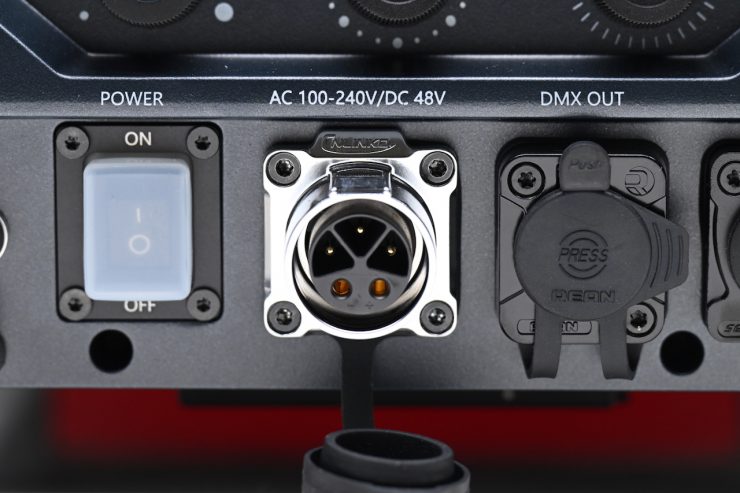
The light draws 600W, and the fixture’s extension port supports control devices, signal routing, and motorized accessories. An AC/DC input allows direct power from wall outlets (100–240V) or DC sources (48V/12.5A).
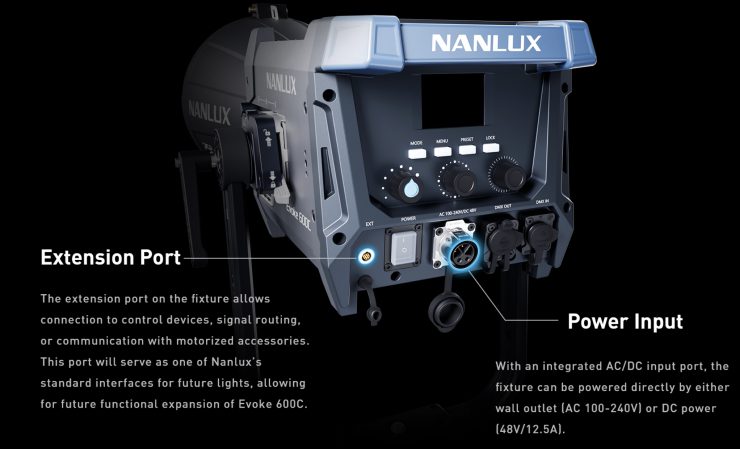
So, how does the power draw compare to other competing fixtures? Below you can see.
| NANLUX Evoke 600C | 600W |
| Aputure STORM 700x | 850W |
| Kelvin Epos 600 | 600W (nominal) 720W (rated) |
| Prolycht Orion 675 FS | 675W |
| Aputure LS 600c Pro II | 720W |
| Aputure STORM 400X | 500W |
| ARRI Orbiter | 500W |
| Aputure LS 600x Pro | 720W |
| Aputure LS 600d Pro | 720W |
| Nanlite Forza 720B | 800W |
| Nanlite FC500C | 500W |
| Falcon Eyes S600CPro | 600W |
| Godox LITEMONS LA600R | 600W |
| COLBOR CL600R | 600W |
| HIVE LIGHTING Super Hornet 575-C | 600W |
As you can see, the power draw of most of these lights is fairly similar, but some of them draw more than 100W more than the Evoke 600C. The competing Aputure STORM 700x draws 250W more.

There is a 48V DC input, so you can power it remotely from block batteries, etc. Unlike some competing fixtures, you can’t power it from regular 14.8V batteries, as there is no separate power supply/ controller with battery plates. This does arguably put it at a slight disadvantage if you need to power a fixture remotely in the field.
I wasn’t able to test the 48V power input as I didn’t have the correct equipment to power this fixture remotely.
How does it stay cool?
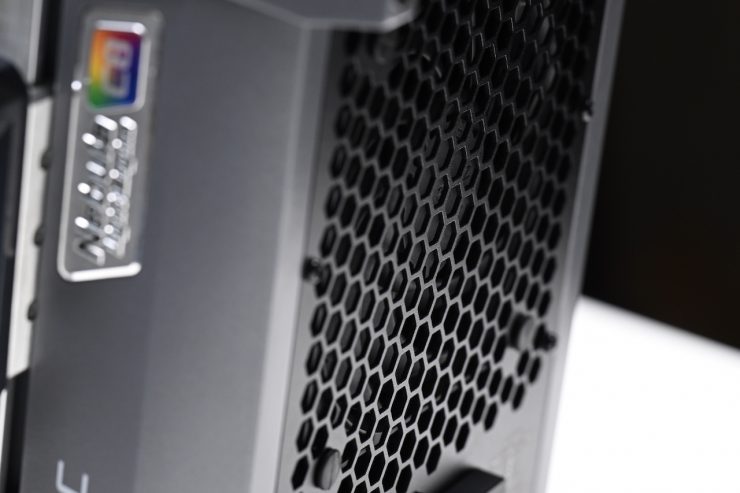
Large, high-powered COB lights get very hot, and keeping them cool is not an easy task. Using fans is the best solution, but the caveat with fans is that they can create noise.

The Evoke 600C is equipped with an efficient cooling system featuring five built-in fan modes. In Smart mode, the average noise level is claimed to be only 31 dB(A). Even during prolonged operation at full power, the fixture is said to maintain quiet, stable output, without interfering with on-set audio recording.
The light gives you the option of changing the fan speed. You can set it to:
- OFF (the cooling fan is turned off. Output is limited to 15%)
- LOW SPEED (the cooling fan is running at up to half speed and the output is limited to 50%)
- FULL SPEED (the cooling fan is running at 100%)
- SMART (the cooling fan will change speeds depending on the temperature of the fixture)
For the most part, the fan noise is reasonably minimal, especially for an all-in-one fixture with an integrated power supply.
Control & Operation

The Evoke 600C shares the same control options as other Evoke fixtures.
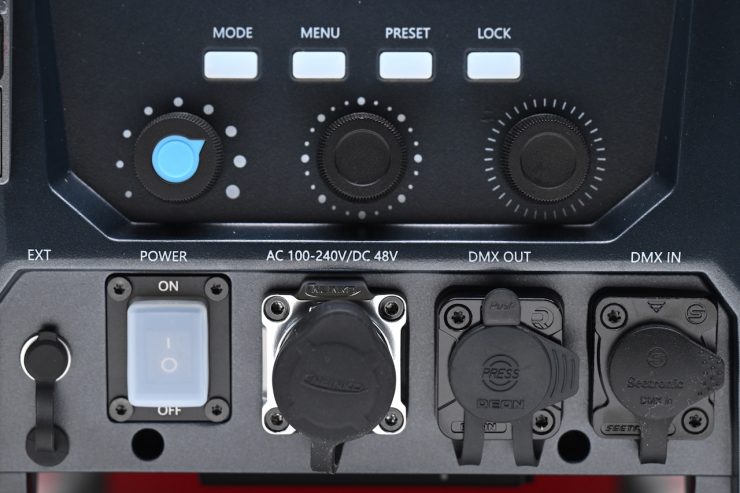
There is a 2.4-inch display, three knobs, and four buttons. It supports multiple control options, including the NANLUX wired remote controller, NANLINK App 2.0, DMX/RDM, LumenRadio CRMX, Art-Net/sACN, and remote controller. Thanks to a built-in NFC function, it can also pair instantly with an NFC-enabled phone or tablet running the NANLINK App 2.0.
The included Wired Controller has a magnetic attachment on the back of it, which allows you to mount it on two different spots on the fixture.
Now, there is an issue I encountered when trying to mount the Wired Controller on the back of the fixture. With the wired cable attached, it won’t fit as there is no clearance for the cable.
Operating Modes
The Evoke 600C offers six built-in lighting modes:
- CCT
- HSI
- RGBW
- XY Coordinates
- Gel
- Effect modes
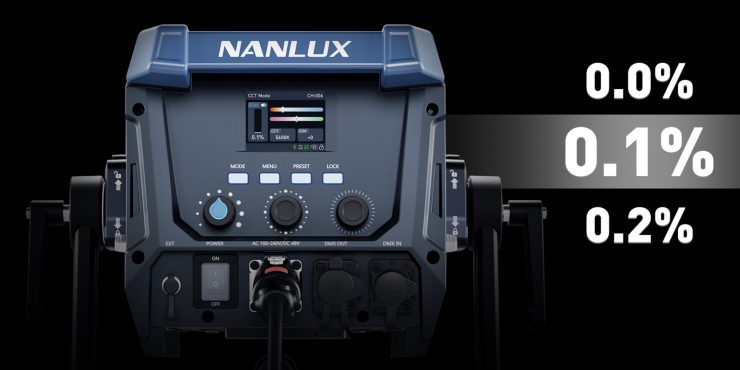
The Evoke 600C also has a fully linear dimming system that supports adjustments in 0.1% increments, ensuring smooth performance at low brightness and natural fade-ins and fade-outs.
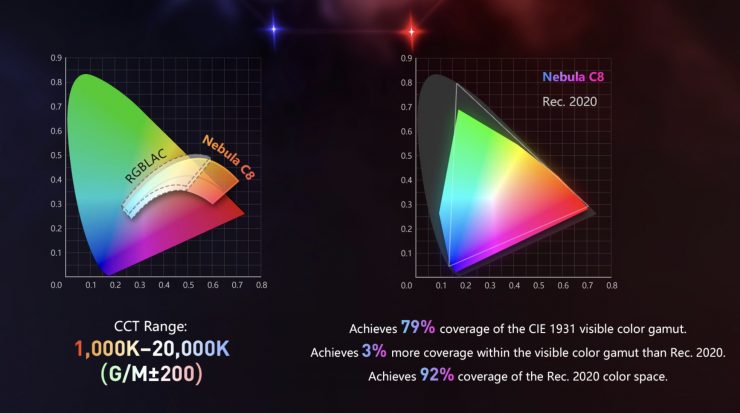
The Evoke 600C has an ultra-wide color temperature range, and it can achieve 79% coverage of the CIE 1931 visible color gamut. It is 3% higher than Rec. 2020 in the visible color gamut and has 92% coverage of the Rec. 2020 color space. It has a claimed CRI is 96, TLCI 97, and TM-30 scores of Rf 96 and Rg 100.
Correlated Color Temperature (CCT)
This is the mode most people are going to use the light in. In the CCT Mode, you have full access to making Kelvin color temperature adjustments between 1000-20,000K. This is a very wide range, and it offers plenty of versatility.
You can adjust the intensity right down to 0.1% and the light still stays on.

The fixture also has continuous variable (full minus green to full plus green) correction.
Being able to dial in more or reduce the amount of green coming from your lighting source can make a huge difference. Different camera companies use different sensors in their cameras, and they all react differently to light. Some camera sensors may lean towards magenta, and some may lean more towards green. By making CCT adjustments, you can dial in the light so that it looks better for whatever camera system you are using. CCT adjustment also helps when you are trying to match lights from different manufacturers.
The CCT range is very impressive, and it should suit most people’s needs.
HSI
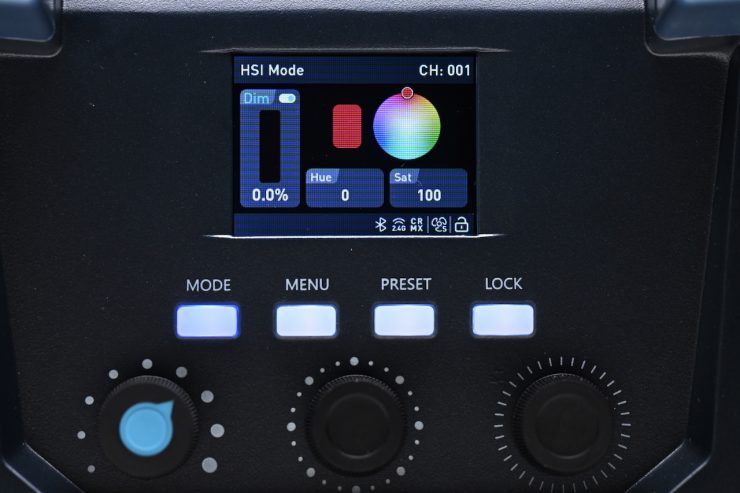
The HSI mode lets you create just about any color you can think of. It gives you full hue and saturation control as well as intensity. By manipulating the hue and saturation, you can create some really interesting colors that, depending on the project you are working on, can really add some creative flair. I quite like using this mode to create a lot of color separation between the foreground and background, or for recreating a really cold or warm-looking image.
Because the interface has really good visual aids, it is so much easier to dial in the exact color you want to create. On some lights, you have to use dials with no visual reference.
RGBW

In this mode, you can individually adjust the Red, Green, Blue, and White channels of the fixture.
XY

In this mode, you can adjust the x,y coordinates of the light. This can be handy when trying to match other fixtures or light sources if you have a Specromaster that can measure x,y coordinates.
Gel
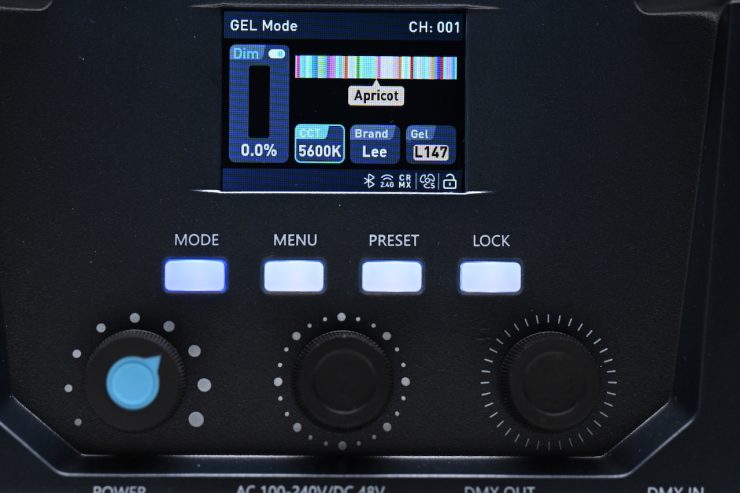
Inside the fixture, there is a huge assortment of industry-standard gels from both Lee and Rosco. In fact, you can choose from 230 Rosco gels and 230 LEE gels.
Having built-in Digital Gels not only means that you don’t have to physically carry gels around, but you can also quickly and easily replicate popular gels. Using the gel mode can help you match other lighting sources, especially if you are working with other lights with physical gels.

You can select the white point by adjusting the CCT slider, and then the selection of gels you see will change.
Effects
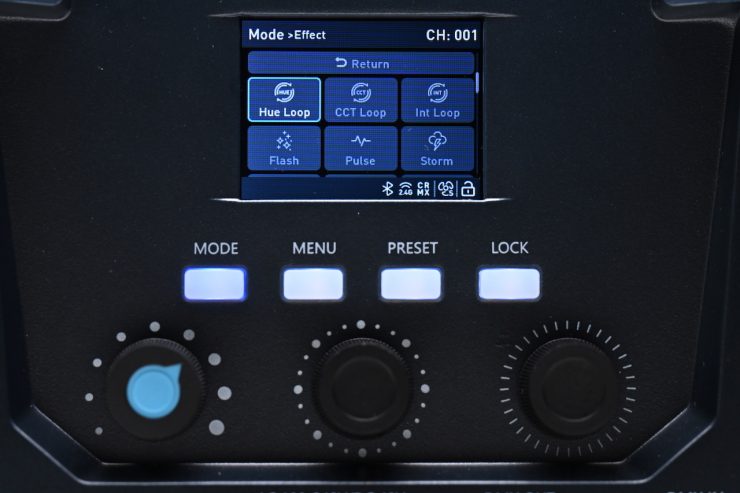
The Nebula C8 light engine allows the fixture to deliver a lot of very realistic full-color lighting effects.
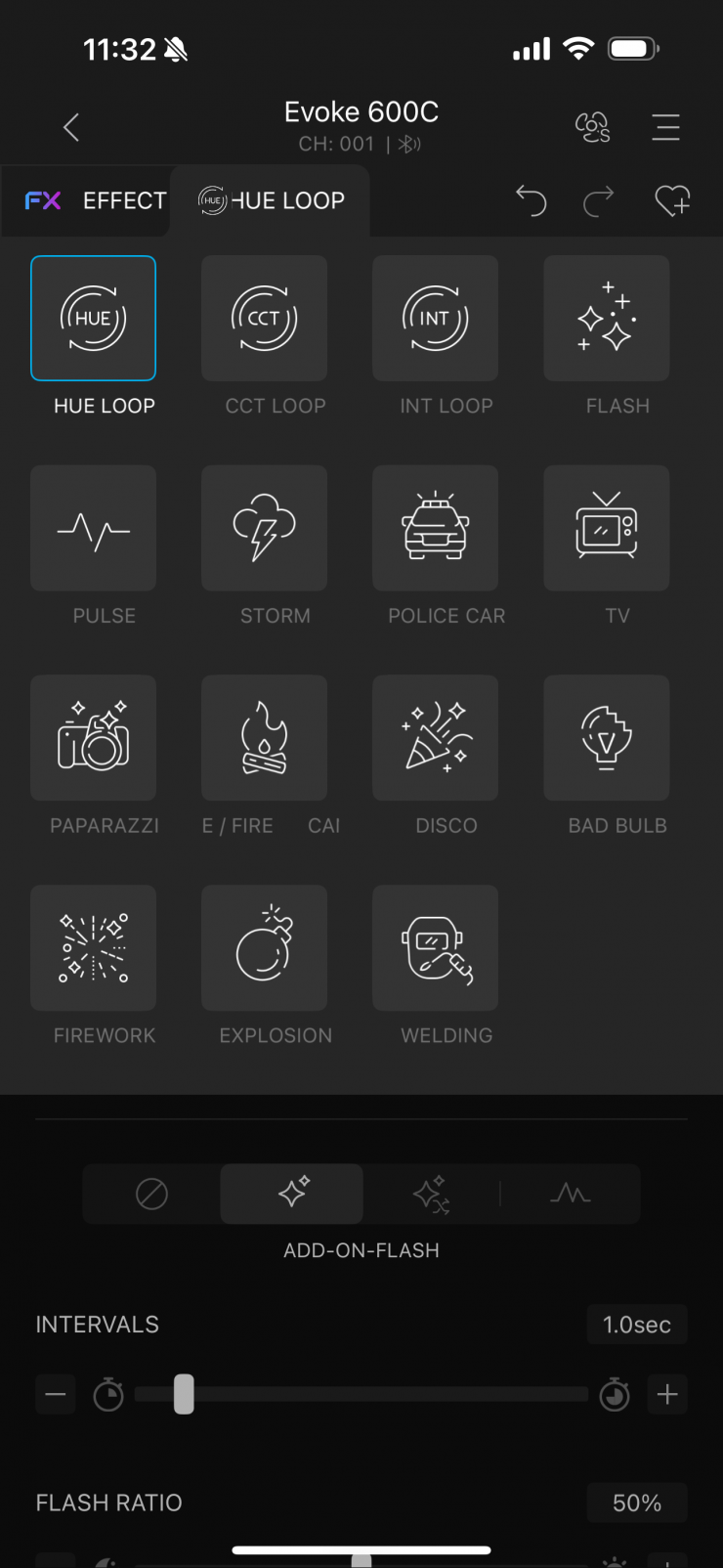
Effects mode lets you recreate 15 lighting effects that can be handy for certain scenarios. The effects are:
- CCT Chase
- Color Chase
- Fire
- Pulse
- Strobe
- Lightning
- Dimming
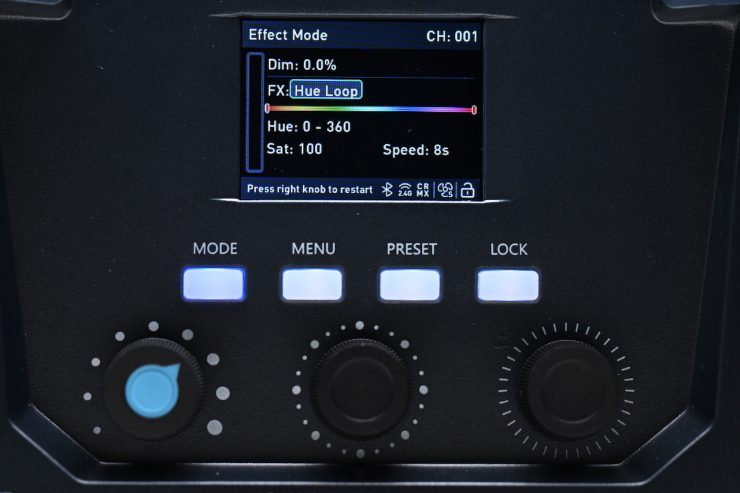
All the effects modes can be individually adjusted and tailored to your lighting needs.
NANLINK Bluetooth app
The light can be controlled via Bluetooth using the NANLINK App.
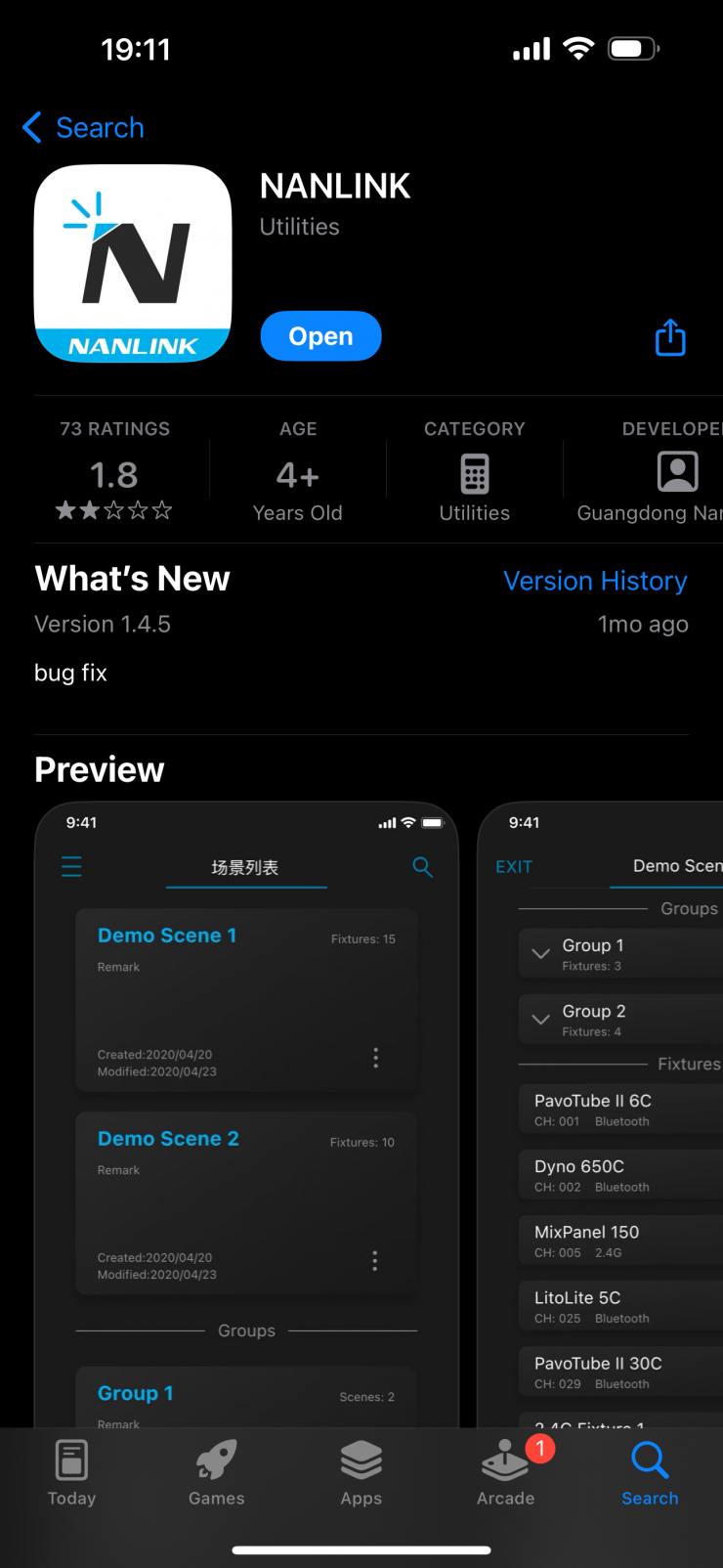
As well as making adjustments directly from the fixture, you can also use the free NANLINK Bluetooth app to control the light remotely.
With the app, the first thing I am going to do is create a new Scene and name it Evoke 600C. It will then ask me to add a fixture.
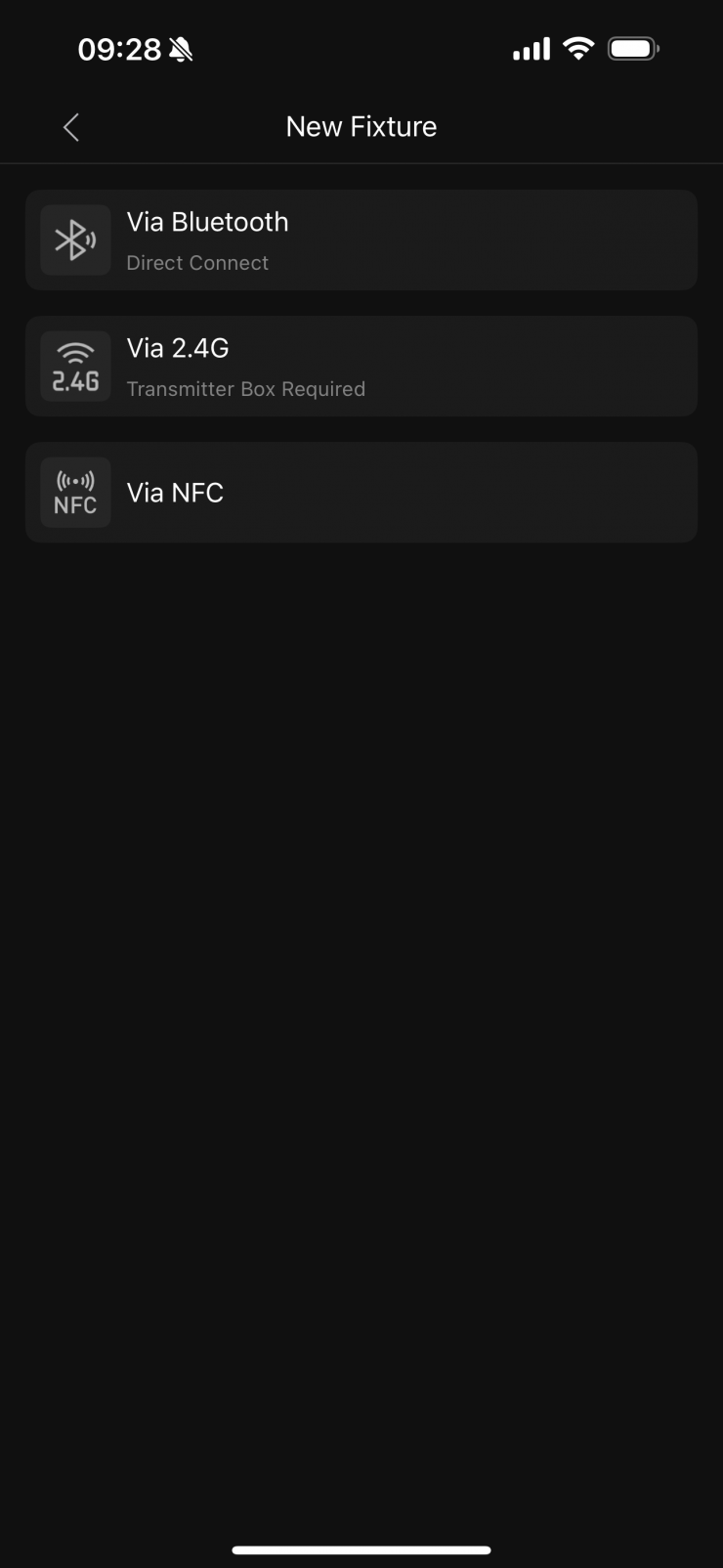
I then get a choice of how I would like to connect to the fixture. In this case, I will choose Bluetooth.
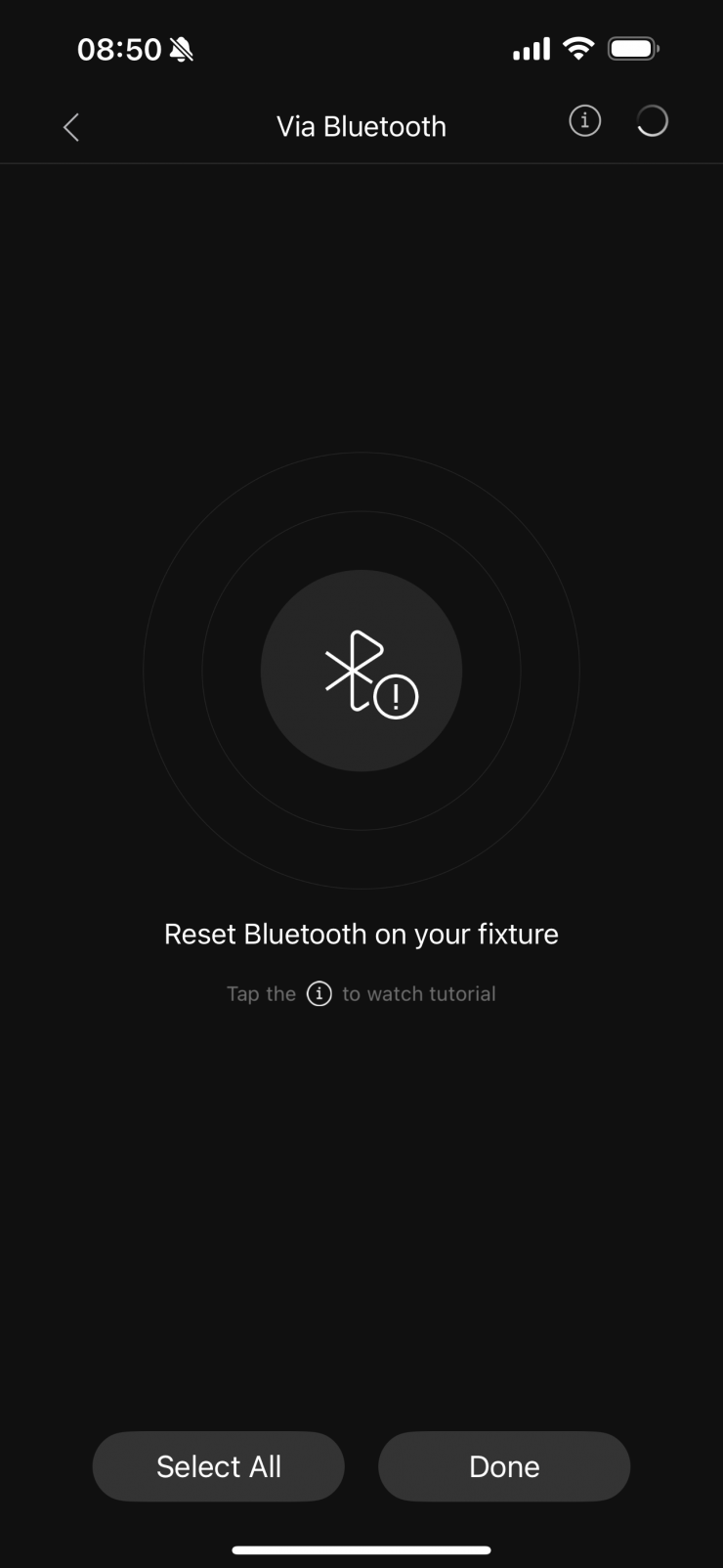
Once I click to add a new fixture, it will ask me to reset the Bluetooth on the fixture.
Once I have done this, the app will then show me any Nanlite/ NANLUX fixtures that are tuned on. I am now going to select the Evoke 150C.
It will then start setting the fixture up to use with the app.
I then end up at the main UI screen. By default, you will be on the CCT page. Here I can adjust the CCT, brightness, and +/- G/M bias.
You can use the sliders or simply type in values if you prefer.
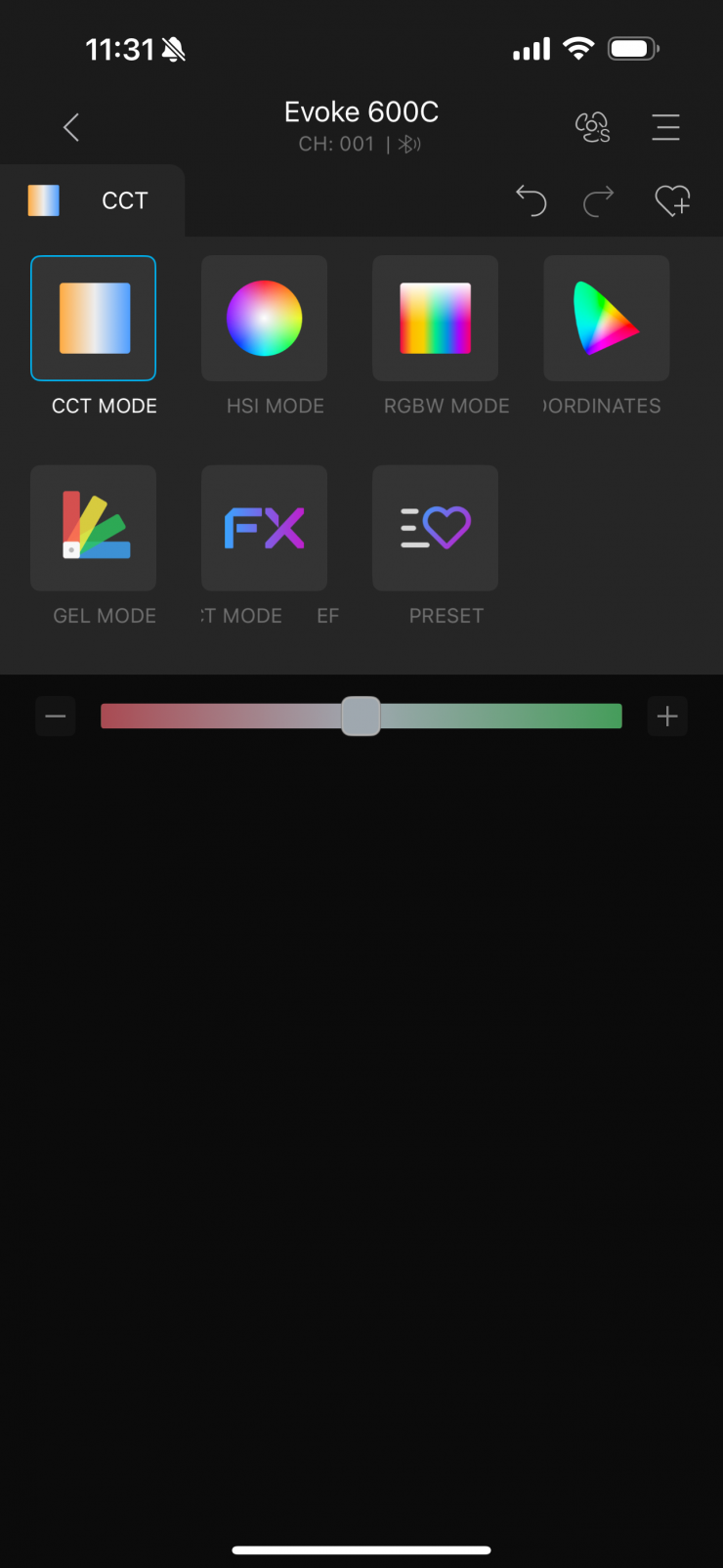
If I want to enter the various operating modes, I simply tap on where the CCT tab is.
Above, you can see what the screens and settings for each mode look like.
I can also save presets that I can store and recall at a later date.
Overall, the app works well. It is easy to make changes, and it connects up without any issues.
The app is reasonably easy to set up and get going. Once you have created a group, you can then add fixtures to that group. You simply scan for new lights if you haven’t added them previously.
There is a problem I encountered when using the app. The first one is that if you adjust the fan speed, for example, setting it to Low Speed, you can still move the intensity slider to 100%, even though the light’s output is capped at 50%. The intensity level should reflect the fan speed limitation.
Beam Angle
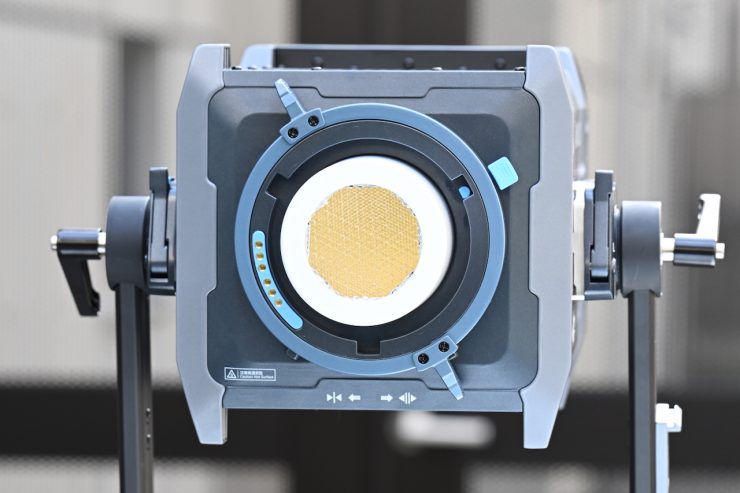
The native beam angle when the fixture is used open face is 65°. When you use it with its included reflector, the beam angle is 25°. A native beam angle of 65° is pretty tight. As a comparison, the Aputure 700x has a native beam angle of 58º.
Is there a hotspot when using the 25° Reflector?

I set up a test where I placed the Ecoke 600C at a distance of 3m / 9.9′ from a wall and then took measurements at the center, 15cm from the center, 30cm from the center, 50cm from the center, and 75cm from the center.
- Center: 25,600 lx
- 15cm from Center: 24,500 lx
- 30cm from Center: 21,400 lx
- 50cm from Center: 13,700 lx
- 75cm from Center: 4340 lx
The 25° Reflector doesn’t have any massive hot spot, and the fall-off is quite nice from around 30cm and out.
Photometrics

So now let’s get to the photometric results. I always test lights in this way so that I get a reference to how they compare to other fixtures. Results only tell part of the story and should never be used alone to judge a light. I have found from extensive testing over the years that certain lights that have good photometric results don’t always look good, and lights that have worse photometric scores can sometimes look better than their results indicate.
You can’t judge a light from one set of photometric results. You have to look at all of the different results to be able to come to a conclusion.
Different lights can also look different depending on what camera you happen to be using.
Output & Color Temperature Accuracy

I tested the NANLUX Evoke 600C at a variety of CCT settings with a Sekonic C-800 Spectrometer to find out how much output the light had and how accurate the Kelvin color temperature reproduction was. All readings are taken at a distance of 1m (3.28ft) in a controlled environment. The readings were also taken directly from the lighting source. In the case of using the light with the Reflector or softbox, the readings were taken from the end of the attachments.
Above, you can see the claimed output figures from the manufacturer.
OPEN FACE
Let’s first look at the light when it is used open face.
NANLUX Evoke 600C 5600K (Open Face)

Above, you can see that the Evoke 600C recorded an output of 34,000 lx (3160 fc) when set at 5600K and used open face.
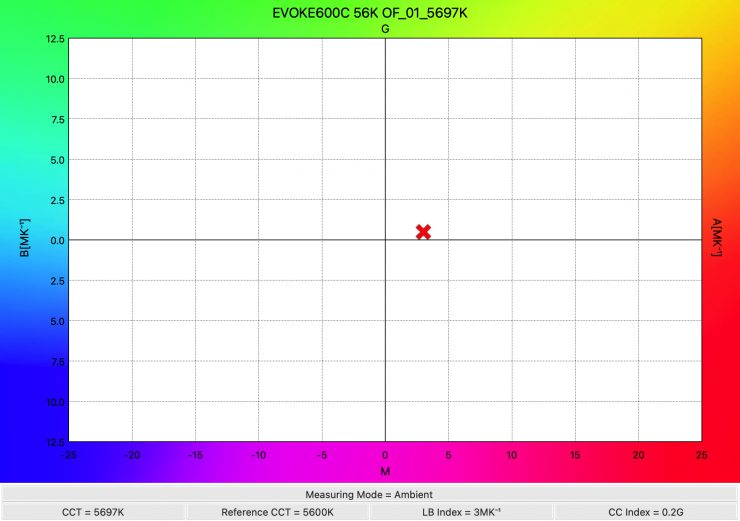
The light recorded a CCT reading of 5697K, which was a very good reading.
NANLUX Evoke 600C 3200K (Open Face)
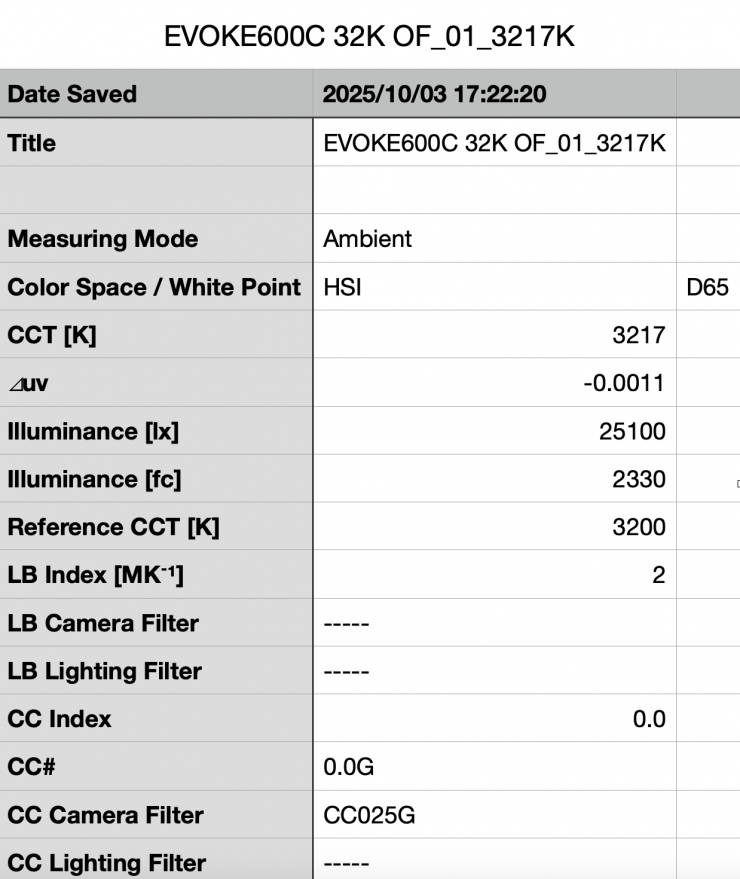
Above you can see the light’s output when it was set at 3200K in the open face configuration was 25,100 lx 2330 fc), which is 26.17% less than the 34,000 lx it produced at 5600K.

As far as CCT accuracy goes, it recorded a very accurate reading of 3217K.
Summary of results (Open Face)
| | OUTPUT | CCT |
| 2500K | 22,800 lx | 2469K |
| 3200K | 25,100 lx | 3217K |
| 4500K | 32,000 lx | 4527K |
| 5600K | 34,000 lx | 5697K |
| 6500K | 32,600 lx | 6745K |
| 8000K | 32,500 lx | 8351K |
| 10000K | 31,400 lx | 10570K |
Above, you can see a summary of results when the light was used open face at various CCT settings.
The results show me that the light’s CCT accuracy when used open face was pretty good up until about 5600K. Above 6500K, it isn’t nearly as good. Yes, anytime you put anything in front of a light, it will alter the CCT, but nonetheless, this is something you need to be very aware of.
What was nice to see is that the light’s output is pretty consistent from 4500-10,000K. At 2500K and 3200K, it had less output.
25° Reflector
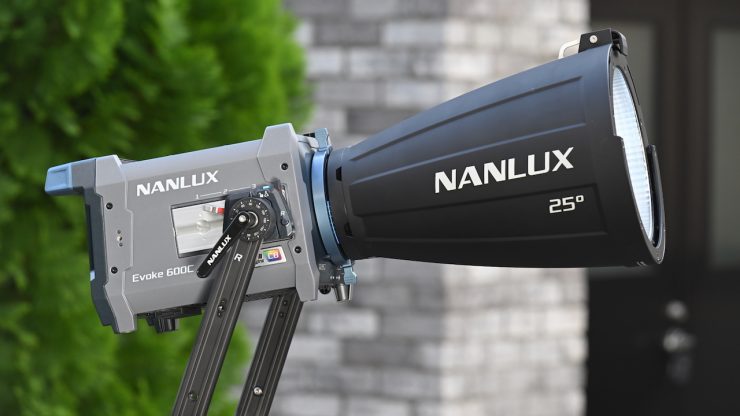
So, now let’s see how much output the light has when used with its standard 25° reflector.
NANLUX Evoke 600C 5600K (25° Reflector)
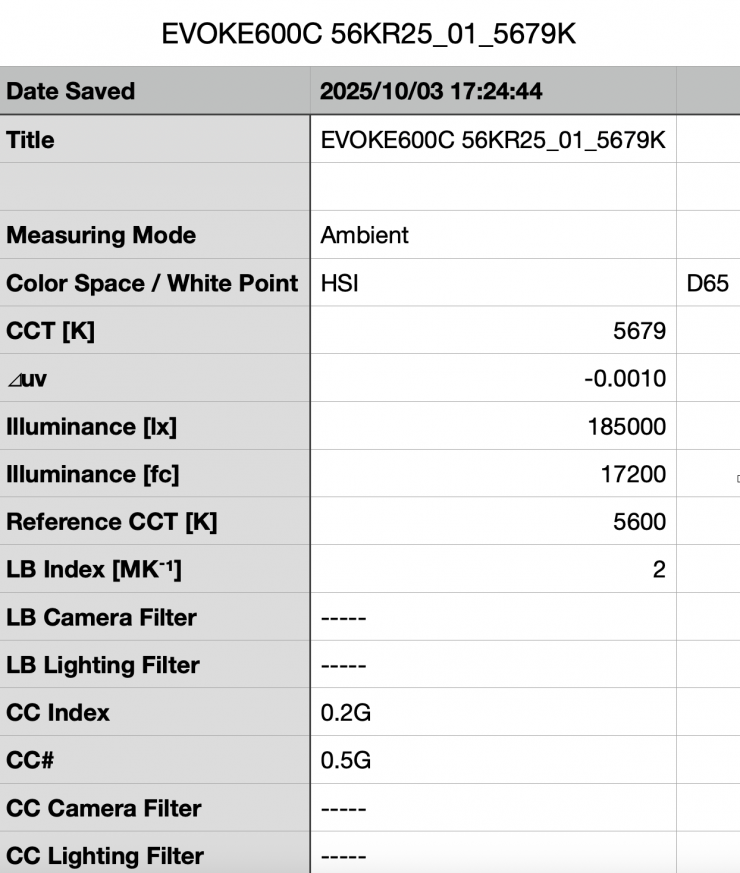
Above you can see the light’s output when it was set at 5600K with the standard reflector was 185,000 lx (17,200 fc). It is important to note that this measurement was made 1m/ 3.3′ from the end of the reflector.
This is a ton of output from a light this size using a reflector.

As far as CCT accuracy goes, it recorded a very good reading of 5679K. As the 25° Reflector is communicating with the fixture, the CCT doesn’t get altered much.
NANLUX Evoke 600C 3200K (25° Reflector)

Above you can see the light’s output when it was set at 3200K with the standard 25° reflector was 134,000 lx (12,500 fc), which was 27.56% less than what it output at 5600K.
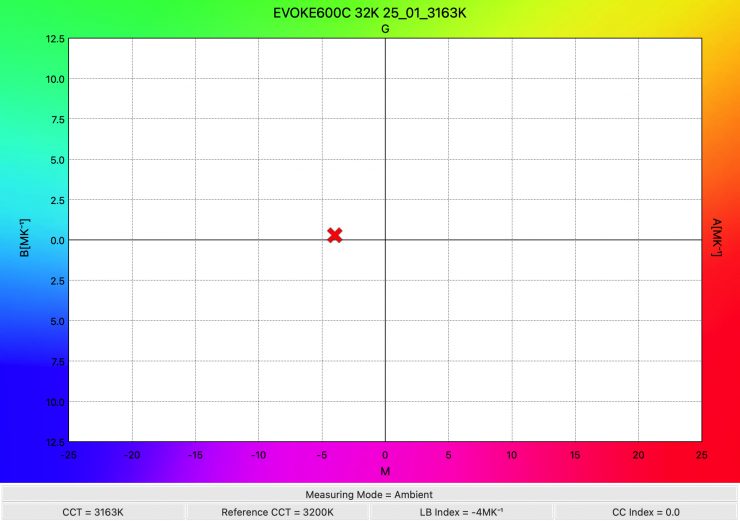
As far as CCT accuracy goes, it recorded a reading of 3163K, which was an excellent score.
Summary of results (25° reflector)
| | OUTPUT | CCT |
| 2500K | 114,000 lx | 2431K |
| 3200K | 134,000 lx | 3163K |
| 4500K | 175,000 lx | 4527K |
| 5600K | 185,000 lx | 5679K |
| 6500K | 195,000 lx | 6616K |
| 8000K | 184,000 lx | 8351K |
| 10000K | 185,000 lx | 11022K |
Above, you can see a summary of results when the light was used with its 25° reflector at various CCT settings.
The results show me that the light’s CCT accuracy when using the standard 25° reflector was excellent from 2500-6500K. The output was pretty consistent from 4500-10000K, but the light does have significantly less output at 2500K and 3200K.
45° Reflector

So, now let’s see how much output the light has when used with the optional 45° reflector.
NANLUX Evoke 600C 5600K (45° Reflector)
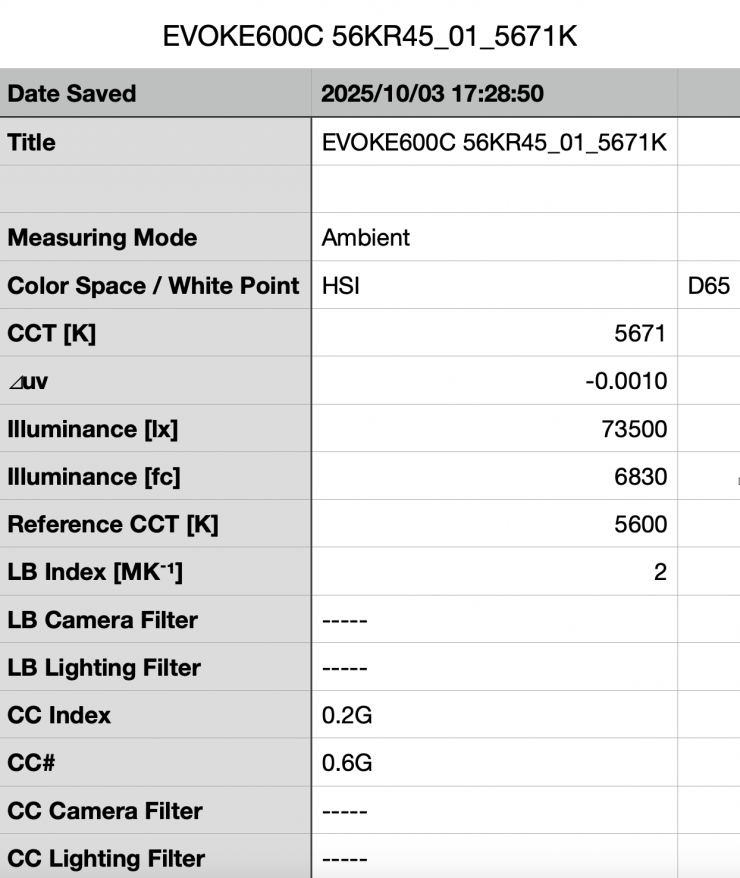
Above you can see the light’s output when it was set at 5600K with the 45° reflector was 73,500 lx (6830 fc). It is important to note that this measurement was made 1m/ 3.3′ from the end of the reflector.
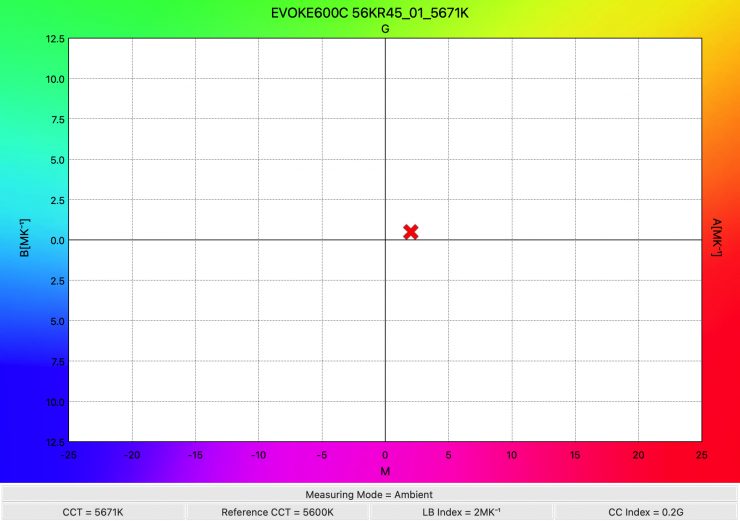
As far as CCT accuracy goes, it recorded an excellent reading of 5671K.
NANLUX Evoke 600C 3200K (45° Reflector)

Above you can see the light’s output when it was set at 3200K with the 45° reflector was 49,700 lx (3200 fc), which was 32.38% less than what it output at 5600K.
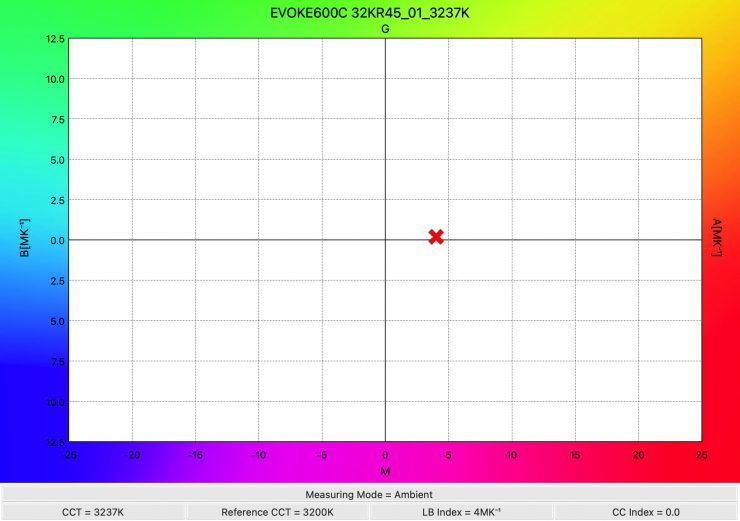
As far as CCT accuracy goes, it recorded a reading of 3237K, which was an excellent score.
Summary of results (45° reflector)
| | OUTPUT | CCT |
| 2500K | 43,300 lx | 2539K |
| 3200K | 49,700 lx | 3237K |
| 4500K | 68,200 lx | 4543K |
| 5600K | 73,500 lx | 5671K |
| 6500K | 77,300 lx | 6465K |
| 8000K | 78,900 lx | 7800K |
| 10000K | 70,600 lx | 10872K |
Above, you can see a summary of results when the light was used with its reflector at various CCT settings.
The results show me that the light’s CCT accuracy when using the 45° reflector was excellent from 2500-6500K. The output was pretty consistent from 4500-10000K. These were very good results.
How does this compare to some of the competitors we have reviewed? Below you can see:
5600K
| | Output at 5600K | CCT (K) |
| NANLUX Evoke 600C | 73,500 lx (45° reflector) |
5671K |
| Kelvin Epos 600 | 83,000 lx (62° reflector) |
5666K |
| Prolycht Orion 675 FS | 55,700 lx (55° reflector) |
5515K |
| Aputure LS 600c Pro | 49,000 lx (62° reflector) |
5617K |
| Nanlite Forza 720B | 73,000 lx (55° reflector) |
5397K |
| Aputure LS 600x Pro | 64,800 lx (55° reflector) |
5397K |
The new Aputure STORM 700x has a claimed output of 168,380 lx*
(35° reflector), but you need to remember that it draws 250W more, and the reflector has a tighter beam angle.
3200K
| | Output at 3200K | CCT (K) |
| NANLUX Evoke 600C | 49,700 lx (45° reflector) |
3237K |
| Kelvin Epos 600 | 71,400 lx (62° reflector) |
3252K |
| Prolycht Orion 675 FS | 47,700 lx (55° reflector) |
3230K |
| Aputure LS 600c Pro | 37,300 lx (62° reflector) |
3209K |
| Nanlite Forza 720B | 58,900 lx (55° reflector) |
3148K |
| Aputure LS 600x Pro | 49,600 lx (55° reflector) |
3046K |
Below you can see how the output of the NANLUX Evoke 600C compares to some HMI fixtures at a distance of 3m.
| | OUTPUT @5600K 3m / 9.9′ |
| NANLUX Evoke 600C (45° reflector) | 8167 lx |
| ARRI M8 (Standard reflector 60°) | 4589 lx |
| ARRI M18 (Standard reflector 63°) | 9556 lx |
| K 5600 Lighting Joker 2 400W (50° super wide) |
2400 lx |
| K 5600 Lighting Joker 2 800W (50° super wide) |
5560 lx |
Please note that the readings from the two K 5600 Lighting options and the ARRI M8 and M18 are claimed figures. I haven’t independently tested these lights.
While the Evoke 600C is quite different from a light like the Joker2 and M18, at least you can get some idea of how its output compares.
Output when using various Fan Settings
As I am thorough, I wanted to see what the output was of the Evoke 600C when it was used in its various different fan settings.
NANLUX Evoke 600C 5600K 25° Reflector (Fan Off)

Above you can see the light’s output when it was set at 5600K in its Fan Off Mode with the standard reflector was 30,100 lx (2790 fc), which was 83.72% less than what it output in its Smart of Full Speed fan mode.
NANLUX Evoke 600C 5600K 25° Reflector (Low Speed)
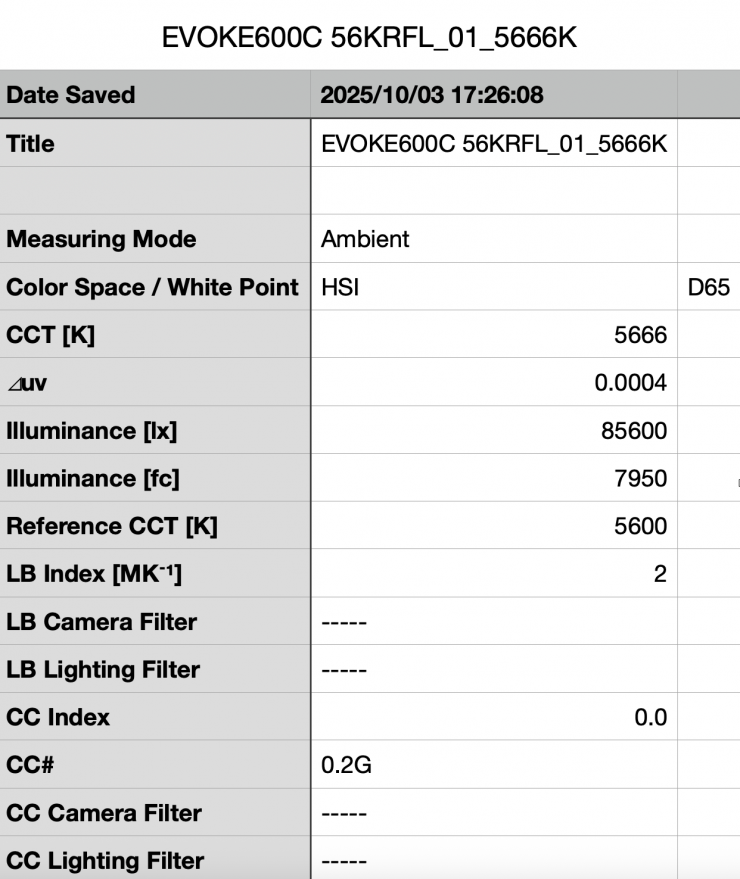
Above you can see the light’s output when it was set at 5600K in its Low Speed Fan Mode, with the standard reflector, was 85,600 lx (7950 fc), which was 53.72% less than when it is used in its Smart or Full Speed fan mode.
DoPchoice Octa 3′ Softbox
As this is a light that is likely to be used with lighting modifiers such as softboxes, let’s have a look at the output and CCT accuracy when using a DoPchoice Octa 3′ softbox.
NANLUX Evoke 600C 5600K (DoPchoice Octa 3′ Softbox)

Above you can see the light’s output when it was set at 5600K and used with a DoPchoice Octa 3′ was 6860 lx (638 fc).
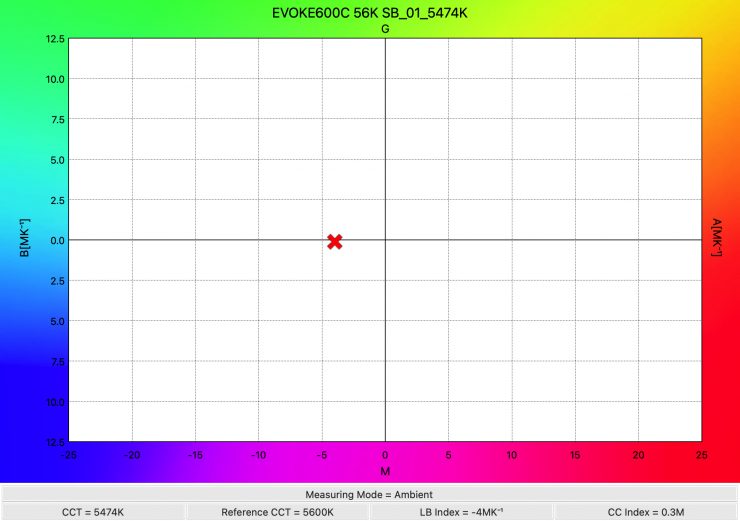
As far as CCT accuracy goes, it recorded a reading of 5474K.
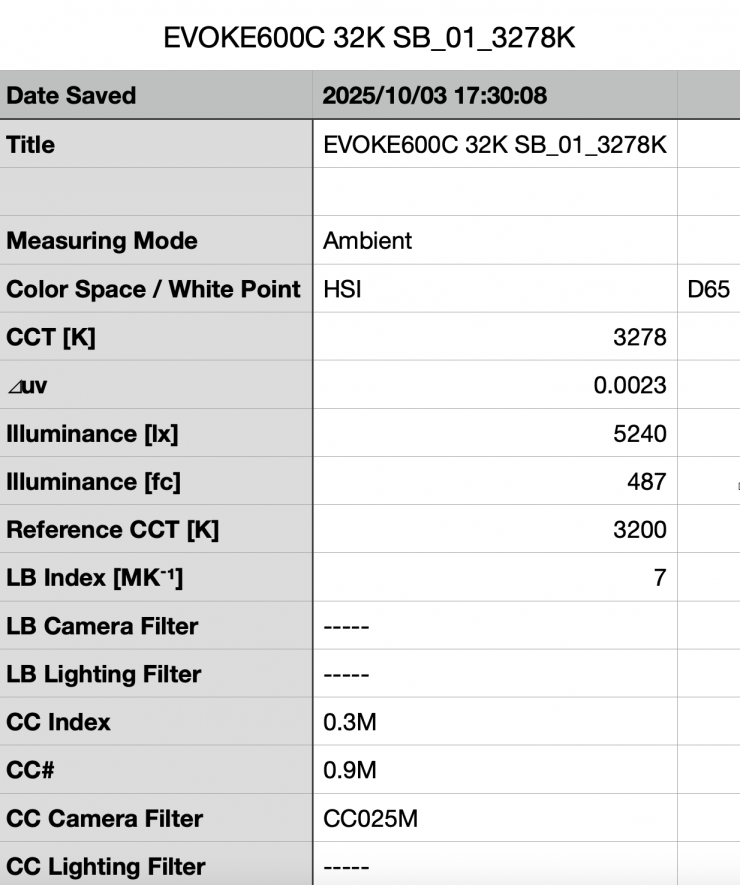
Above you can see the light’s output when it was set at 3200K, with a DoPchoice Octa 3′ soft box was 5,240 lx (487 fc).
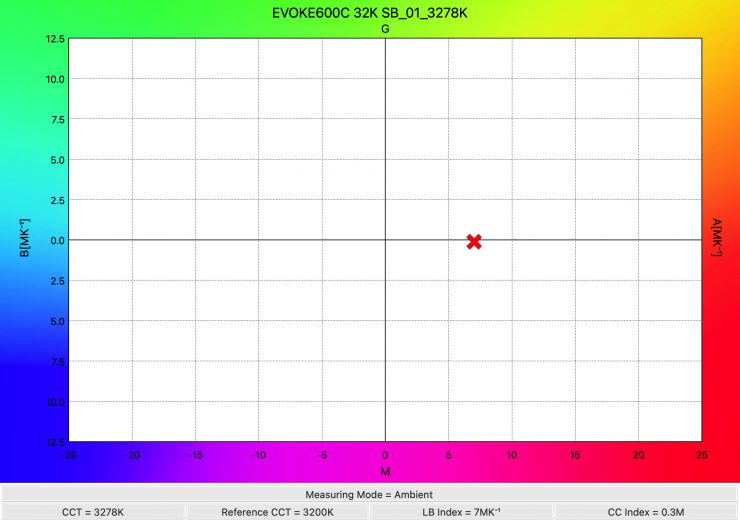
As far as CCT accuracy goes, it recorded a reading of 3278K.
FL-22E Motorized Fresnel
Let’s have a look at the output and CCT accuracy when using the optional FL-22E Motorized Fresnel.
NANLUX Evoke 600C 5600K (FL-22E Motorized Fresnel 50° @3m /9.9′)
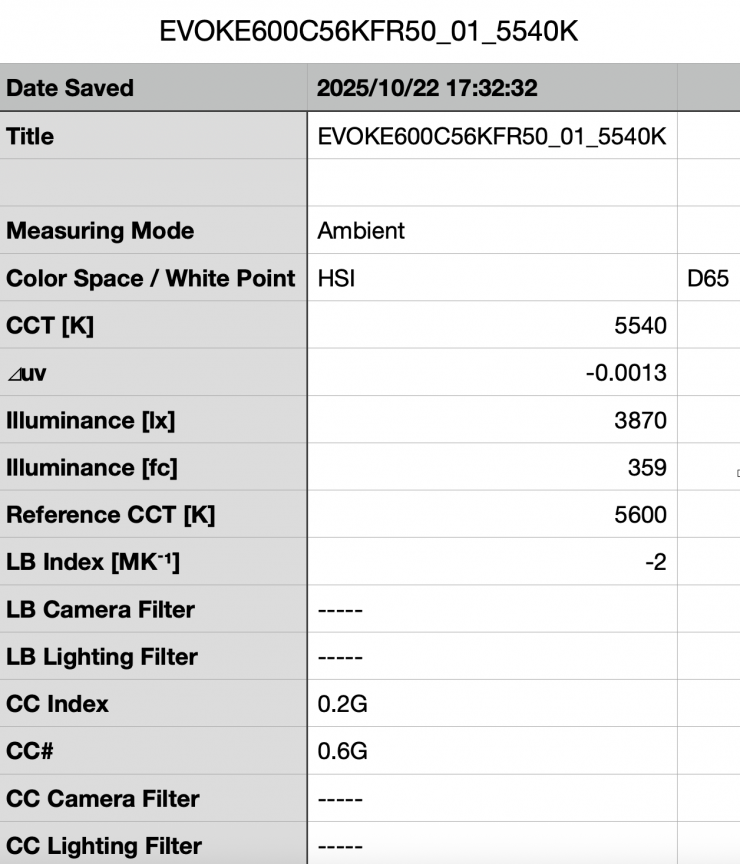
Above you can see the light’s output when it was set at 5600K and used with the optional FL-22E Motorized Fresnel when set at 50° @3m /9.9’was 3870 lx (359 fc).
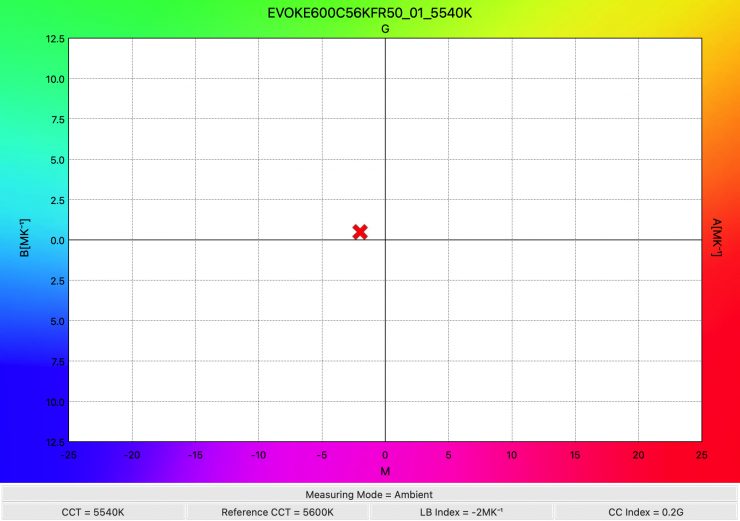
As far as CCT accuracy goes, it recorded a very good reading of 5540K.
NANLUX Evoke 600C 5600K (FL-22E Motorized Fresnel 35° @3m /9.9′)
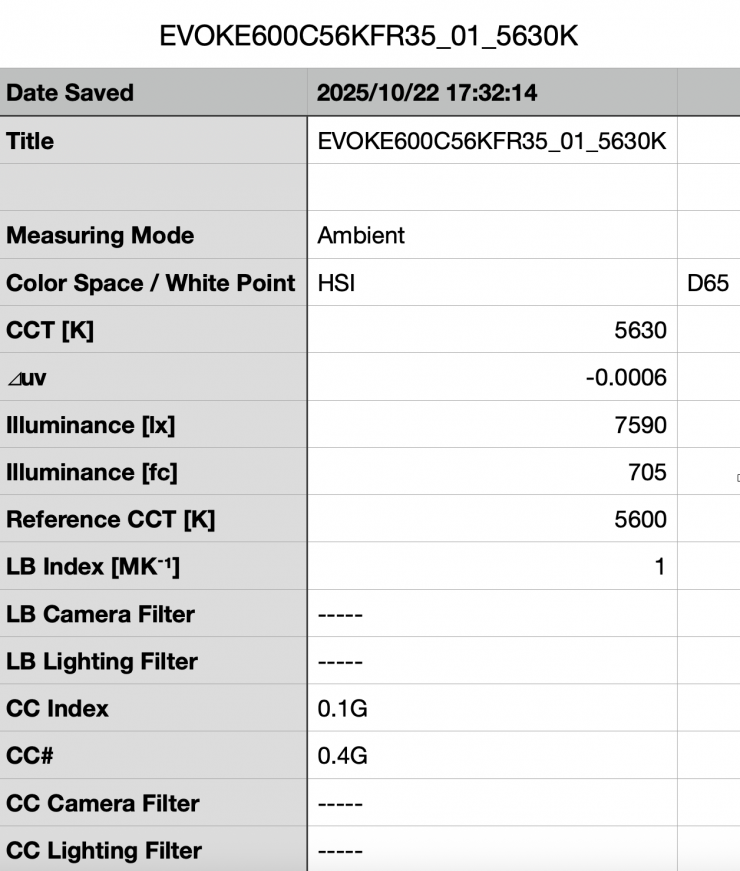
Above you can see the light’s output when it was set at 5600K and used with the optional FL-22E Motorized Fresnel when set at 35° @3m /9.9’was 7590 lx (705 fc).

As far as CCT accuracy goes, it recorded a very good reading of 5630K.
NANLUX Evoke 600C 5600K (FL-22E Motorized Fresnel 15° @3m /9.9′)
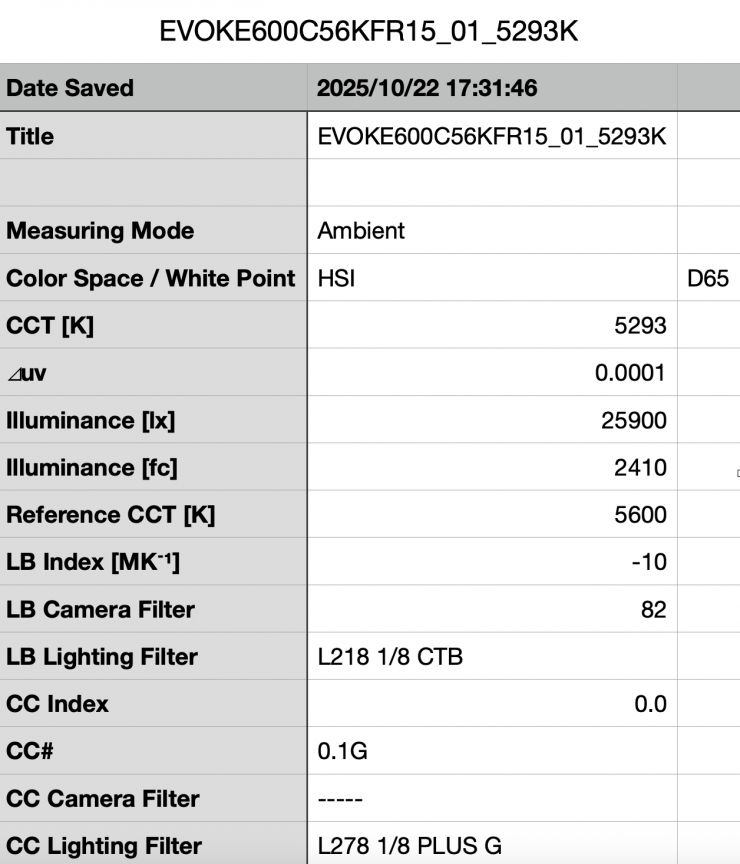
Above you can see the light’s output when it was set at 5600K and used with the optional FL-22E Motorized Fresnel when set at 15° @3m /9.9’was 25,900 lx (2410 fc). If we use the inverse square law, that equates to 233,100 lx @1m / 3.3′.
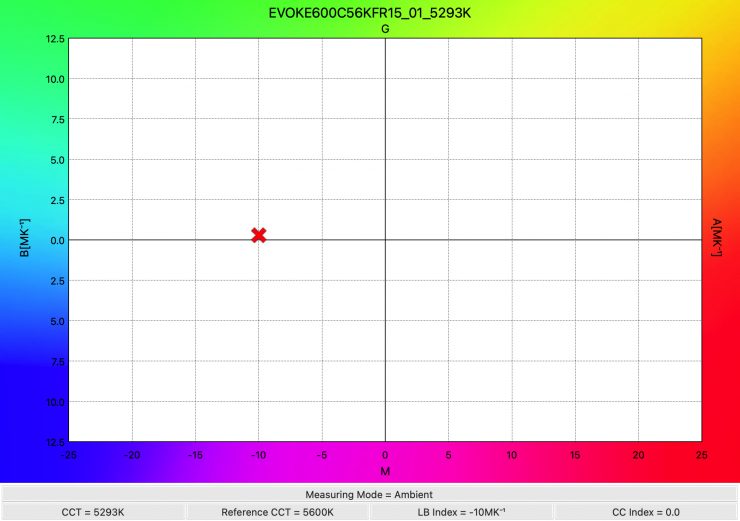
As far as CCT accuracy goes, it recorded a reading of 5293K.
+/- Green adjustment
As the fixture includes +/- Green adjustment, you can quite easily correct any tint. While there is no exact science to this, and it really depends on what camera you are using as well, it’s just a matter of trial and error to see what setting actually works the best. The nice thing is, any light with +/- Green adjustment can be fine-tuned to deliver better results.
CCT consistency & linear output when dimming the light
Now, what you should always do when testing lights is to see if the CCT remains consistent when dimming the light. Just because you set a light at say 5600K, that doesn’t mean that the CCT will remain stable as you start dimming the fixture down. I also wanted to see how linear the dimming curve was.
I decided to do a series of tests at 100%/75%/50%/25%10% to see if the CCT being recorded changed. This was done at a distance of 1m / 3.3′ using a Sekonic C-800. These tests were done at 5600K with the light being used with its 25° Reflector.
NANLUX Evoke 600C 25° Reflector (Linear Dimming)
| CCT READING | OUTPUT | INTENSITY % |
| 5679K | 185,000 lx | 100 |
| 5724K | 140,000 lx | 75 |
| 5703K | 84,500 lx | 50 |
| 5704K | 47,500 lx | 25 |
| 5704K | 20,100 lx | 10 |
The Evoke 600C maintained excellent CCT consistency as you start dimming the fixture. My testing showed that the CCT readings varied by just 35K from 100% to 10%.
As far as how linear the output is when you start dimming the light, at 50% output, it had 54.32% less output than when used at 100%. At 25% it had 74.32% less output than when used at 100%. At 10% output, it had 89.313% less output than when used at 100%. This shows me that the light’s dimming curve is very linear.
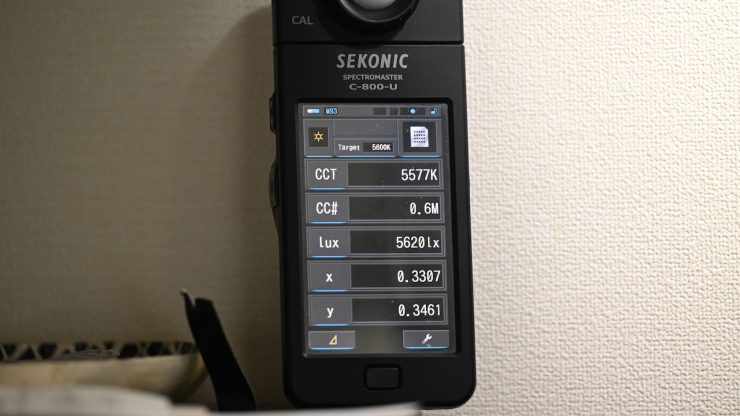
Even when I reduced the output down to 1%, at 5600K, it still gave me a very good reading of 5577K.
Color Rendering
So now that we have seen how much output the Evoke 600C produces, how does it perform when it comes to replicating accurate colors?
NANLUX Evoke 600C 5600K (25° reflector)
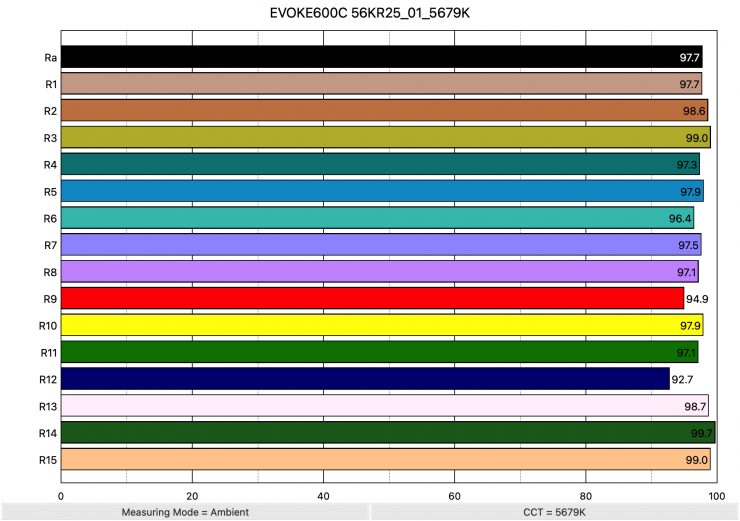
Above, you can see that when the light was set at 5600K, using the 25-degree reflector recorded an average CRI (R1-R8) of 97.7 and an extended CRI (R1-R15) of 97.43. For replicating accurate skin tones, it recorded 94.9 for R9 (red), 98.7 for R13 (closest to caucasian skin tones), and 99.0 for R15 (closest to Asian skin tones). These are right up there with the best results I have ever seen from an LED light at 5600K.

The light, when set at 5600K using its 25° reflector, recorded a TLCI score of 98.
NANLUX Evoke 600C 3200K (25° reflector)
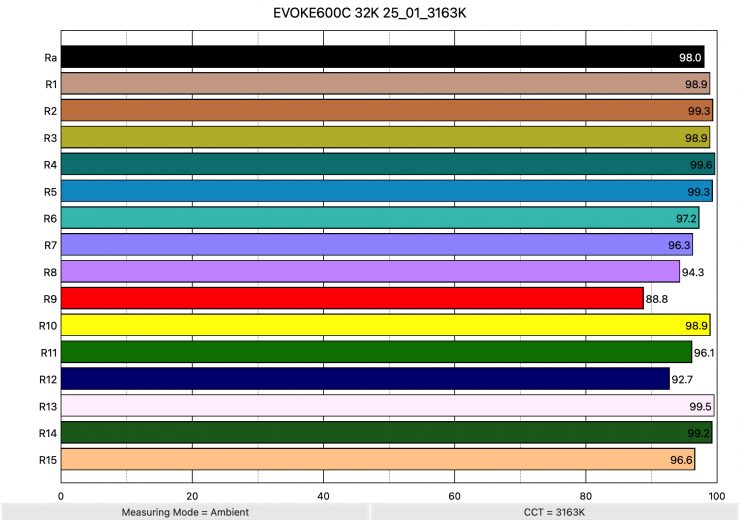
Above, you can see the scores for when the light was used at 3200K. It recorded an average CRI (R1-R8) of 98.0 and an extended CRI (R1-R15) of 97.04. For replicating accurate skin tones, it recorded 88.8 for R9 (red), 99.5 for R13 (closest to caucasian skin tones), and 96.6 for R15 (closest to Asian skin tones). Only R9 (red) was marginally under 90.
These results were outstanding and almost as good as when the light was used at 5600K.
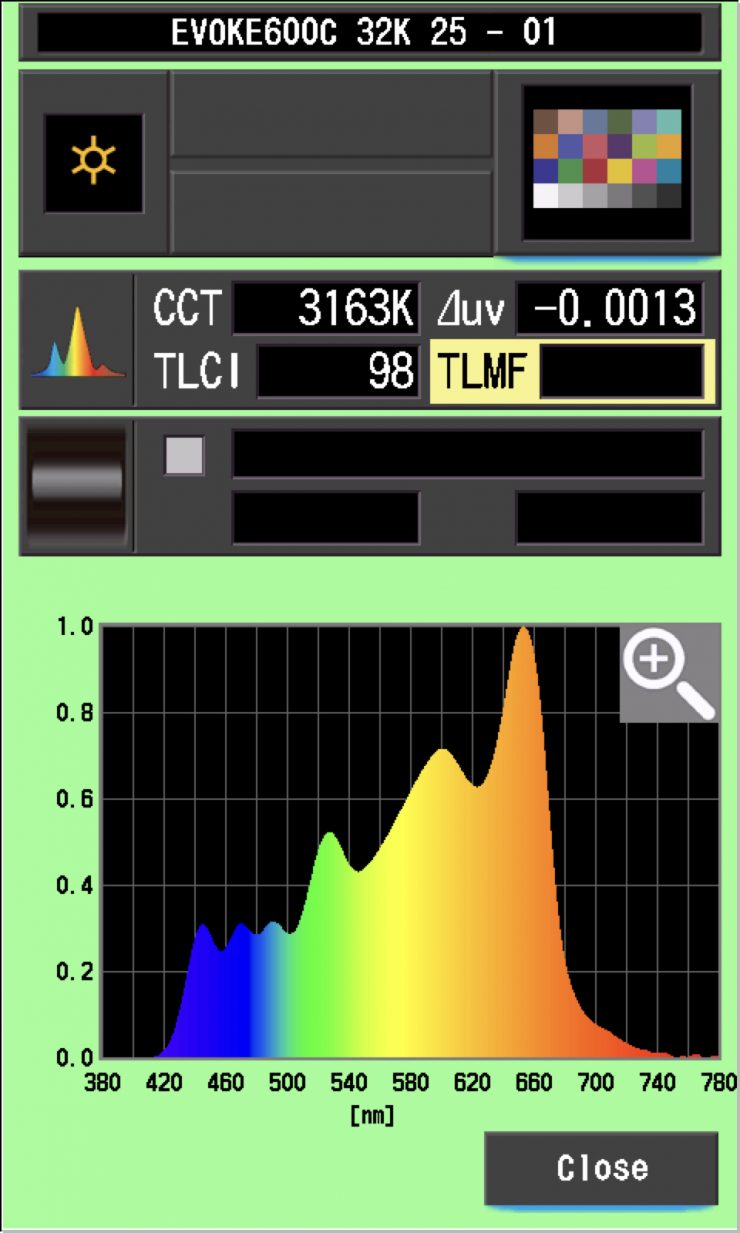
The light, when set at 3200K, recorded a TLCI score of 98.
NANLUX Evoke 600C 5600K (45° reflector)

Above, you can see that when the light was set at 5600K, using the 45-degree reflector recorded an average CRI (R1-R8) of 98.0 and an extended CRI (R1-R15) of 97.75. For replicating accurate skin tones, it recorded 96.5 for R9 (red), 98.6 for R13 (closest to caucasian skin tones), and 99.1 for R15 (closest to Asian skin tones). These are the best results I have ever seen from an LED light at 5600K.

The light, when set at 5600K using the 45° reflector, recorded a TLCI score of 99.
NANLUX Evoke 600C 3200K (45° reflector)
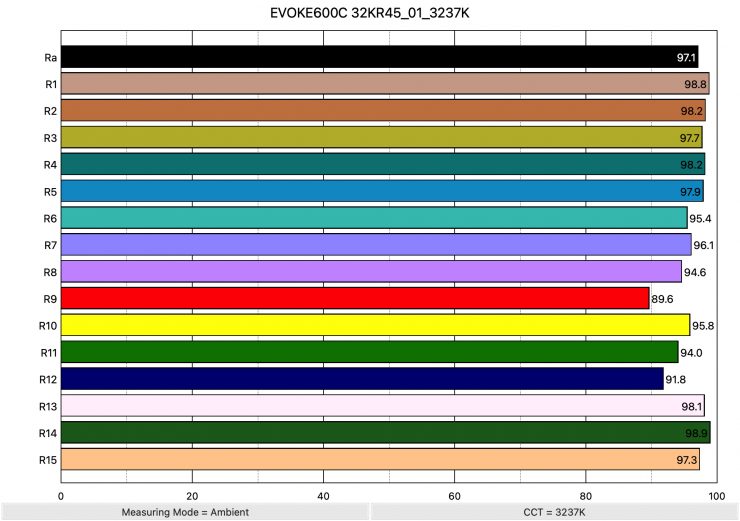
Above, you can see the scores for when the light was used at 3200K. It recorded an average CRI (R1-R8) of 97.1 and an extended CRI (R1-R15) of 96.16. For replicating accurate skin tones, it recorded 89.6 for R9 (red), 98.1 for R13 (closest to caucasian skin tones), and 97.3 for R15 (closest to Asian skin tones). Only R9 (red) was marginally under 90.
These results were outstanding but not quite as good as when the light was used at 5600K.

The light, when set at 3200K, recorded a TLCI score of 98.
How do these figures at 3200K and 5600K compare to other lights that we have previously reviewed? Below you can see:
5600K
| | EXTENDED CRI | R9 | R13 | R15 |
| NANLUX Evoke 600C | 97.75 | 96.5 | 98.6 | 99.1 |
| Kelvin Epos 600 | 96.06 | 95.9 | 98.4 | 98.0 |
| Prolycht Orion 675 FS | 96.73 | 98.2 | 98.9 | 99.5 |
| Aputure LS 600c Pro | 95.32 | 98.9 | 99.1 | 99.0 |
The scores were outstanding for the NANLUX Evoke 600C, and it had the highest extended CRI score I have ever seen from an LED light at 5600K.
3200K
| | EXTENDED CRI | R9 | R13 | R15 |
| NANLUX Evoke 600C | 96.16 | 89.6 | 98.1 | 97.3 |
| Kelvin Epos 600 | 97.42 | 91.7 | 99.3 | 97.6 |
| Prolycht Orion 675 FS | 94.19 | 79.0 | 96.5 | 93.2 |
| Aputure LS 600c Pro | 96.78 | 91.5 | 93.9 | 95.7 |
The scores were excellent for the NANLUX Evoke 600C at 3200K were outstanding. The extended CRI score was right up there with other similar lights I have reviewed.
NANLUX Evoke 600C 5600K (Open Face)
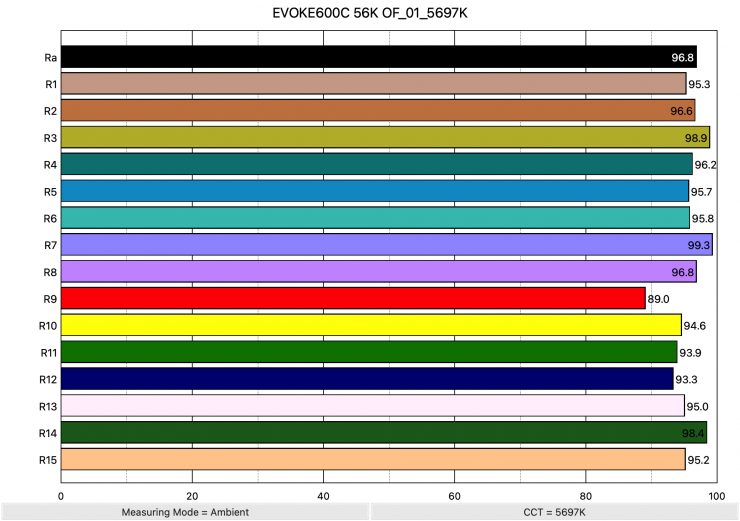
Above you can see that when the light was set at 5600K and used open face recorded an average CRI (R1-R8) of 96.8 and an extended CRI (R1-R15) of 95.6. For replicating accurate skin tones, it recorded 89.0 for R9 (red), 95.0 for R13 (closest to caucasian skin tones), and 95.2 for R15 (closest to Asian skin tones). These are excellent results, and only R9 (red) was marginally below 90.
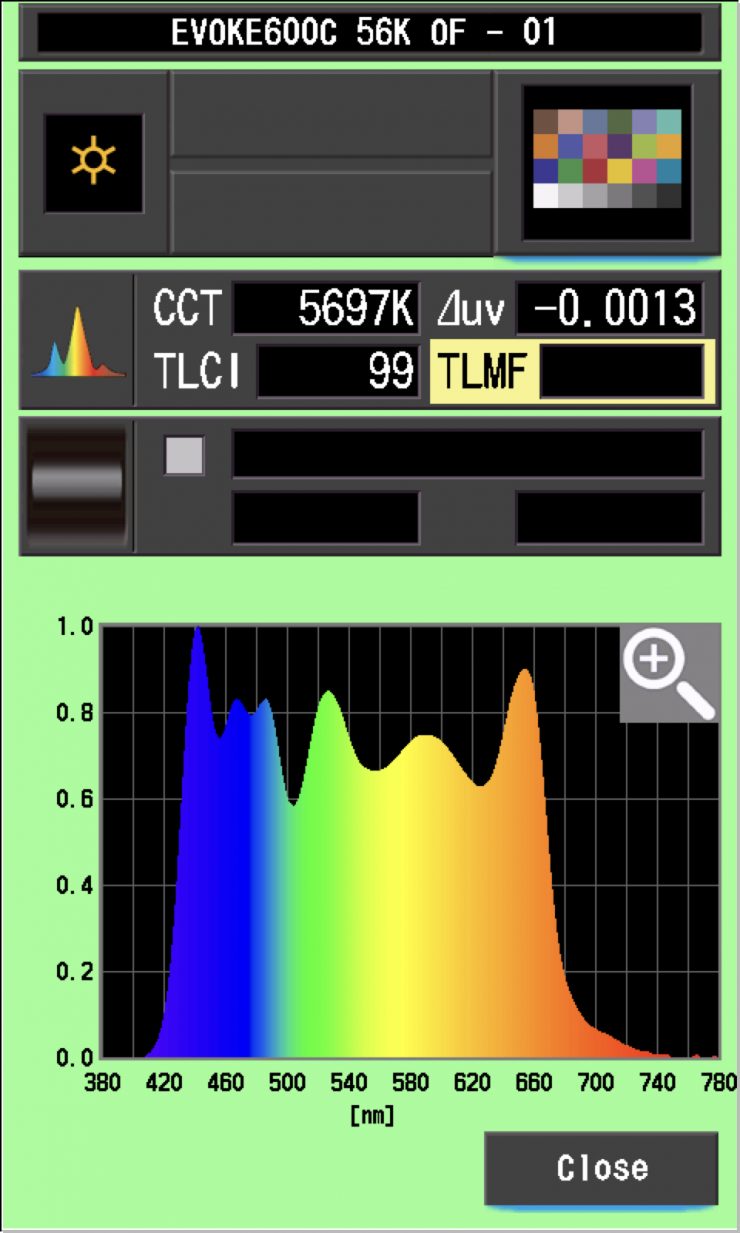
The light, when set at 5600K and used open face, recorded a TLCI score of 99.
NANLUX Evoke 600C 3200K (Open Face)

Above, you can see that when the light was set at 3200K using the standard reflector recorded an average CRI (R1-R8) of 98.2 and an extended CRI (R1-R15) of 97.16. For replicating accurate skin tones, it recorded 90.4 for R9 (red), 99.0 for R13 (closest to caucasian skin tones), and 97.4 for R15 (closest to Asian skin tones). These are outstanding results, and not a single value was below 90.
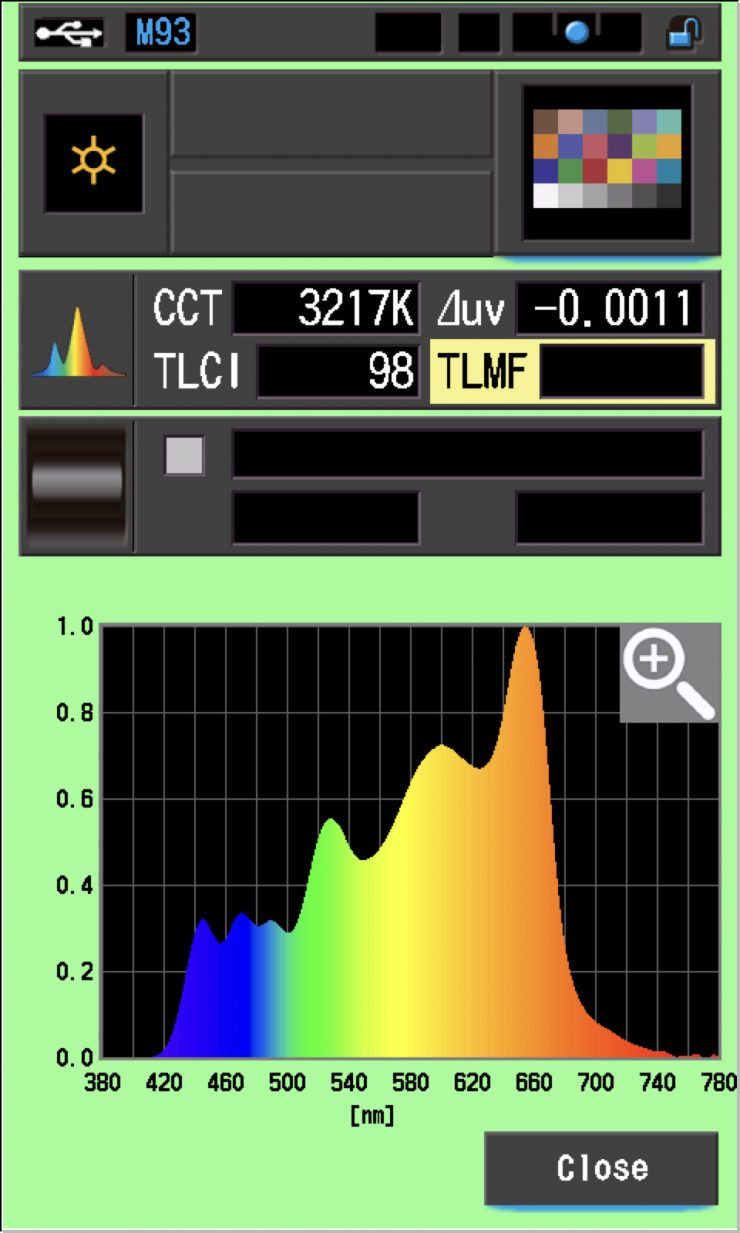
The light, when set at 3200K and used open face, recorded a TLCI score of 98.
CC Index & ⊿uv
The CC Index displays the CC correction value and whether any magenta or green need to be added or subtracted. 1 CC corresponds to 035 Kodak CC values or 1/8 Rosco filter values. Any reading less than +1.00 or -1.00 and you’re probably not going to need to make any kind of adjustment. The ⊿uv is the value to show how much this light is away from being an ideal light source (black body radiation = incandescent lamp). As with the CC Index you want this number to theoretically be zero. Kelvin is not a linear value, so we need to convert from Kelvin to MK-1 to compare the values of color temperature. To calculate from Kelvin to Mired is MK-1= 1*1000000/Kelvin. While this may sound confusing, it is the only way of measuring if the Kelvin shift is significant enough to warrant having to use a filter for correction. Below are the results for the NANLUX Evoke 600C:
NANLUX Evoke 600C Vs MK-1 (open face)
| | Kelvin | Difference in K | MK-1 | Difference in MK-1 |
| SET VALUE | 2500K | 0 | 400 | 0 |
| ACTUAL READING | 2469K | 31 | 405.02 | -5.02 MK-1 |
| SET VALUE | 3200K | 0 | 312.5 | 0 |
| ACTUAL READING | 3217K | 17 | 310.84 | 1.66 MK-1 |
| SET VALUE | 4500K | 0 | 222.22 | 0 |
| ACTUAL READING | 4527K | 27 | 220.89 | 1.33 MK-1 |
| SET VALUE | 5600K | 0 | 178.57 | 0 |
| ACTUAL READING | 5697K | 97 | 175.53 | 3.04 MK-1 |
| SET VALUE | 6500K | 0 | 153.84 | 0 |
| ACTUAL READING | 6745K | 245 | 148.25 | 5.59 MK-1 |
| SET VALUE | 8000K | 0 | 125 | 0 |
| ACTUAL READING | 8351K | 351 | 119.74 | 5.26 MK-1 |
| SET VALUE | 10000K | 0 | 100 | 0 |
| ACTUAL READING | 10570K | 570 | 94.60 | 5.4 MK-1 |
These figures might look confusing, but what they tell me is that the light is very CCT-accurate across its range. Any MK-1 score that is under -9/9 means you wouldn’t have to use any color correction gels. The MK-1 scores for this light were extremely good, especially at 3200K and 4500K.
NANLUX Evoke 600C CC INDEX & ⊿uv (open face)
| | CC INDEX | ⊿uv |
| 2500K | 0.3G | -0.0009 |
| 3200K | 0 | -0.0011 |
| 4500K | 0.1G | -0.0011 |
| 5600K | 0.2G | -0.0013 |
| 6500K | 0.4G | -0.0005 |
| 8000K | 0.5G | 0.0009 |
| 10000K | 0.9G | 0.0002 |
The CC Index & ⊿uv scores were very consistent. The ⊿uv scores were some of the best I have seen. The CC Index scores do clearly show that the light does lean slightly magenta, but that comes as no surprise given how the new light engine works.
TM-30
TM-30 is a relatively new color rendering standard that was developed to deal with the limitations of CRI. TM-30 looks at 99 individual colors. These 99 colors are categorized into seven groups: nature, skin color, textiles, paints, plastics, printed material, and color systems.
TM-30 scores go from 0 – 100. The higher the score, the more accurate a light is at producing colors. Any TM-30 Rf score in the ’90s is considered to be good. What is interesting and something that you need to be very aware of is that two separate light sources with the exact same CRI scores can render colors very differently. A light with a high CRI rating could have a low TM-30 score. Conversely, a light with a good TM-30 score could have a bad CRI score.
Now, there are two measurements associated with TM-30, Rf and Rg.
Rf (Color Fidelity)
Rg (Color Gamut)
With Rf value, ideally, you want a score in the 90’s.
With Rg value, a score below 100 indicates that the light source renders colors with less saturation than the reference source. So ideally, you want this score to be above 100.
Above, you can see the scores for the NANLUX Evoke 600C at various CCT settings. Below, I have listed the figures as well.
Here are the results:
| | Rf | Rg |
| 2500K | 95 | 101 |
| 3200K | 96 | 100 |
| 4500K | 97 | 101 |
| 5600K | 96 | 102 |
| 6500K | 96 | 101 |
| 8000K | 95 | 100 |
| 10000K | 96 | 100 |
The TM-30 scores were excellent for this light, and it shows me that it is very consistent at replicating accurate colors with full saturation. The consistency of the light is very impressive.
Output & accuracy when creating saturated colors
I also wanted to test the light to see how it performed when creating super-saturated colors using the 25° reflector.
0° – RED
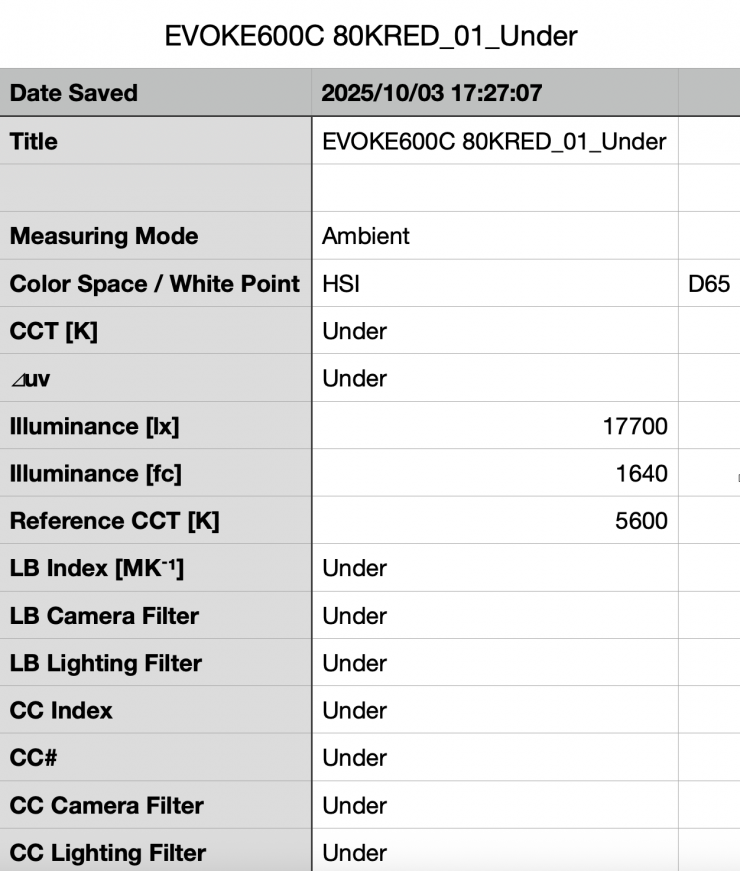
Above, you can see that the light, when using its 25° reflector, recorded an output of 17,700 lx (1640 fc).

As far as creating an accurate 0° RED, the Evoke 600C was spot on with a reading of 0°.
120° – GREEN
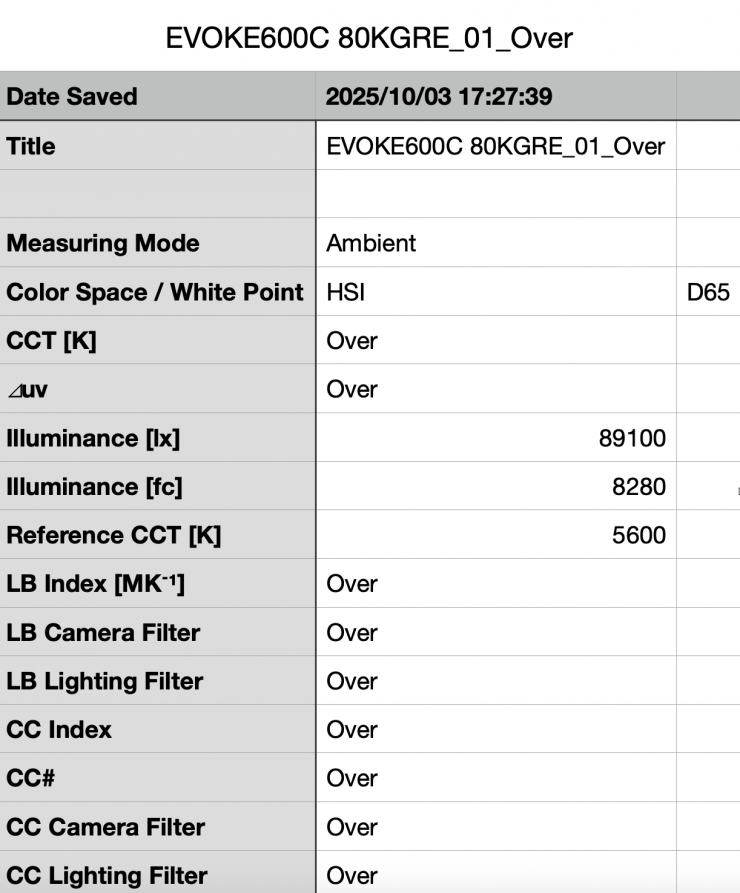
Above, you can see that the light, when using its 25° reflector, recorded an output of 89,100 lx (8280 fc).

As far as creating an accurate 120° GREEN, the Evoke 600C was spot on with a 120° reading and 100% saturation.
240° – BLUE
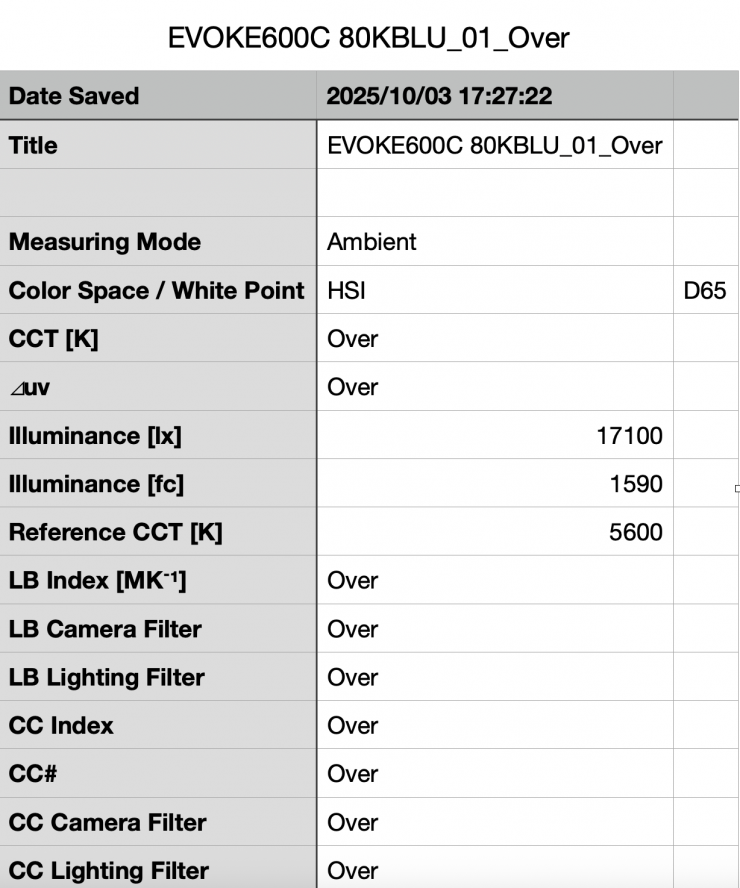
Above, you can see that the light, when using its 25° reflector, recorded an output of 17,100 lx (1590 fc).

As far as creating an accurate 240° BLUE, the Evoke 600C was spot on with a reading of 240°.
60° – YELLOW
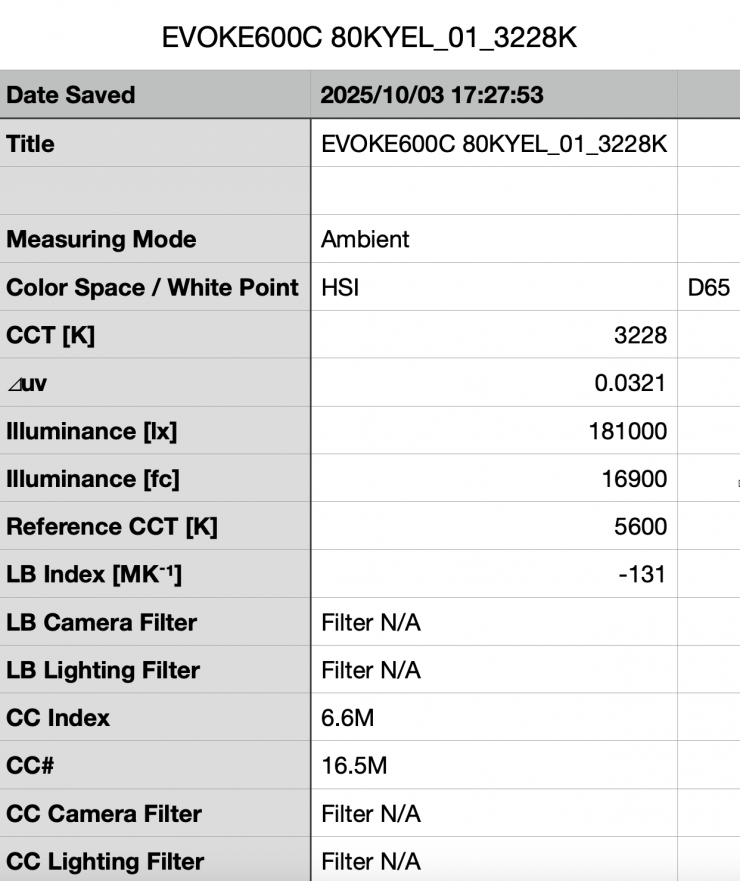
Above, you can see that the light, when using its 25° reflector, recorded an output of 181,000 lx (16,900 fc).

As far as creating an accurate 60° Yellow, the Evoke 600C was 11° off with a reading of 49°.
With the Evoke 600C, the output certainly doesn’t remain consistent depending on what color you are trying to generate. This is something you need to keep in mind.
SSI
SSI (Spectral Similarity Index) was developed by the Sci-Tech Council of the Academy. SSI gives me the ability to set any light as a standard, or use predefined standards (such as CIE D55), and then give other lights an SSI score based upon how well they will match standards such as CIE D55 measure spectral response and compare it directly against an ideal light source.
SSI is a much better way to judge an LED light than CRI or TLCI, although they don’t tell the full story of any light, and you can’t judge a light by SSI scores alone.
SSI is useful for seeing how well different lights will play together. As the Sekonic C-800 Spectromaster can measure SSI, I decided to test out the Evoke 600C to see how it performed.
Evoke 600C 3200K
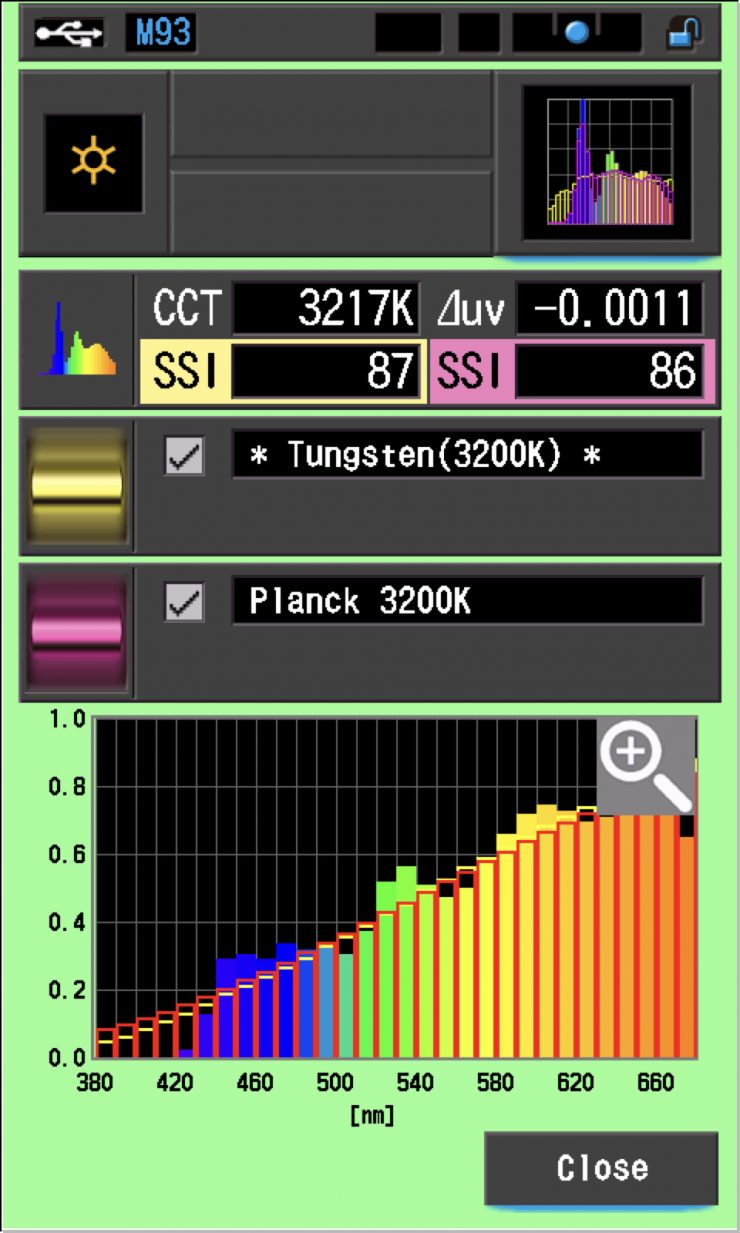
In this graph, the red bars indicate a perfect Planck 3200K source. The gold bars indicate a perfect 3200K Tungsten source. This lets us compare how close to a perfect 3200K lighting source the Evoke 600C is. Any SSI score in the high 70s, low ’80s is very good for a 3200K LED light. These were outstanding scores.

As a comparison, above are the results for the Kelvin Epos 600.
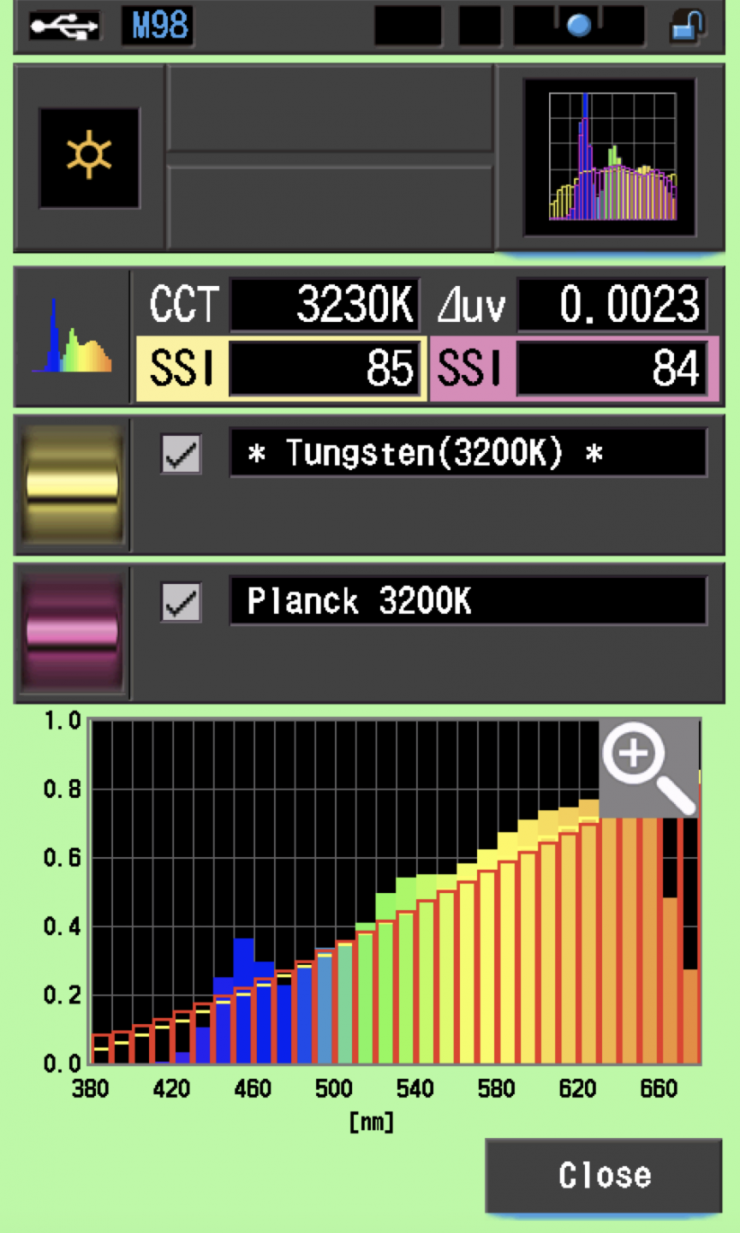
As another comparison, above are the same results for the Prolycht Orion 675 FS.
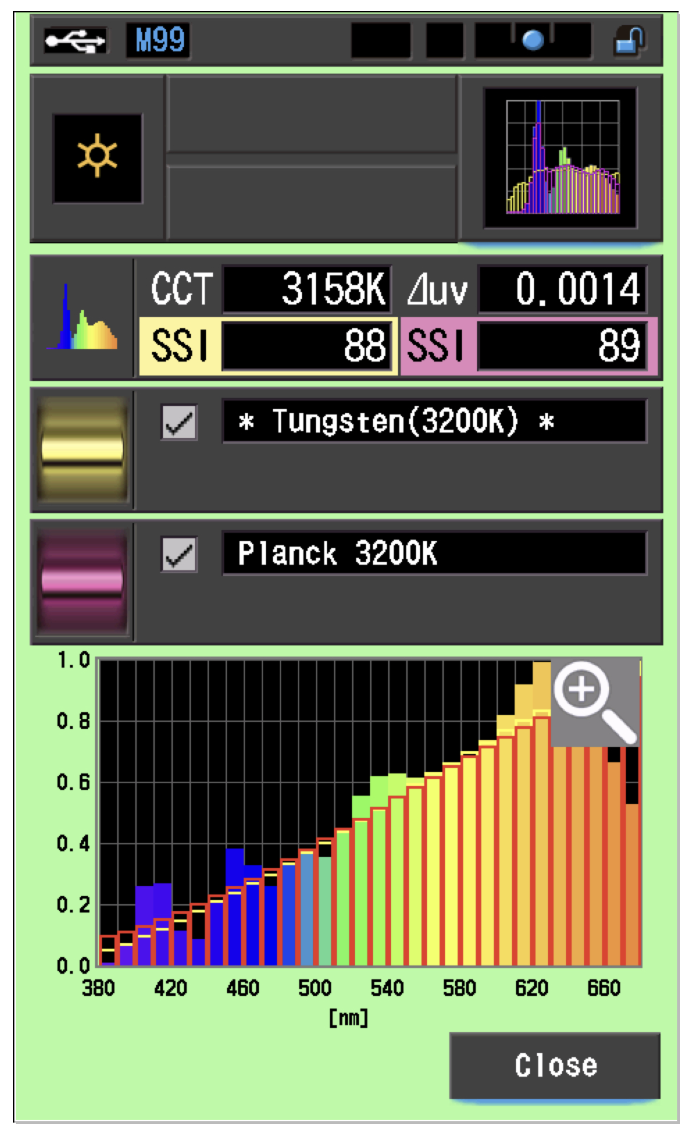
As another comparison, the results for the Aputure STORM 1000c are above.
Evoke 600C 5600K
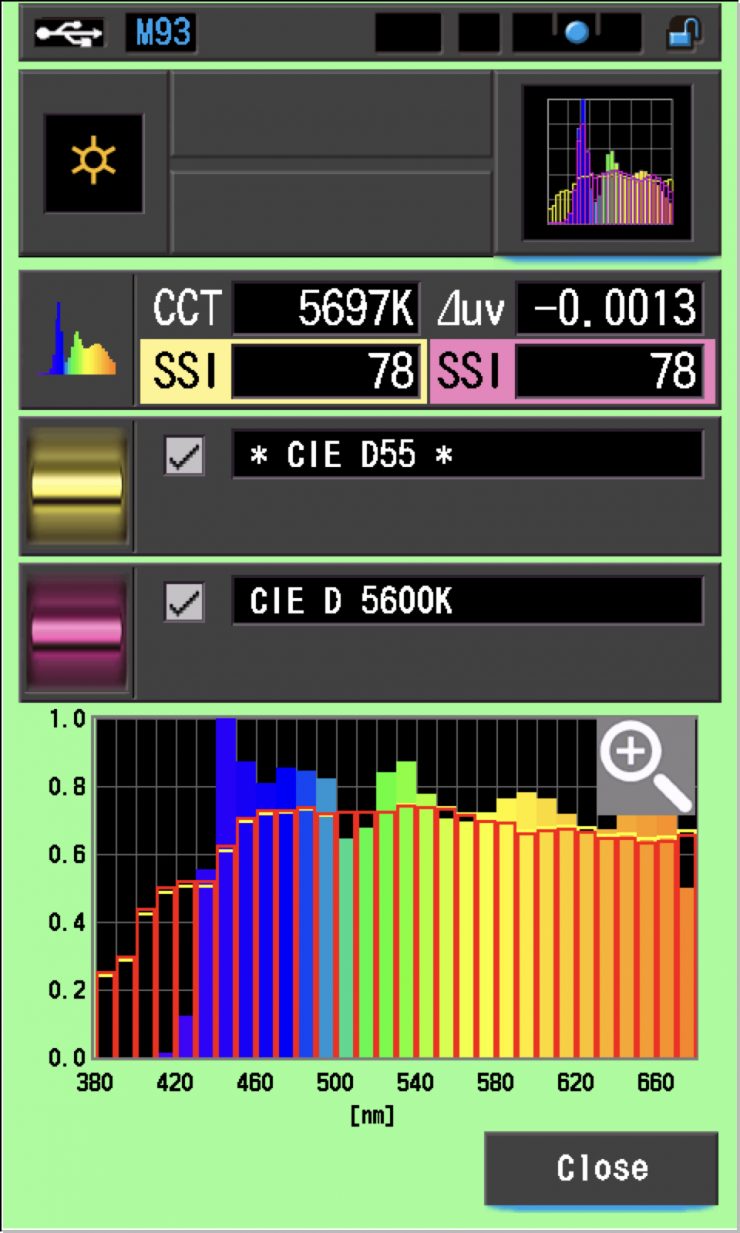
In the graph above, the gold bars indicate a perfect CIE D55 source. The red bars indicate a perfect CIE D 5600K source. This lets us compare how close to a perfect 5600K lighting source the Evoke 600C is. A score in the low 70s is typical for a 5600K LED source.
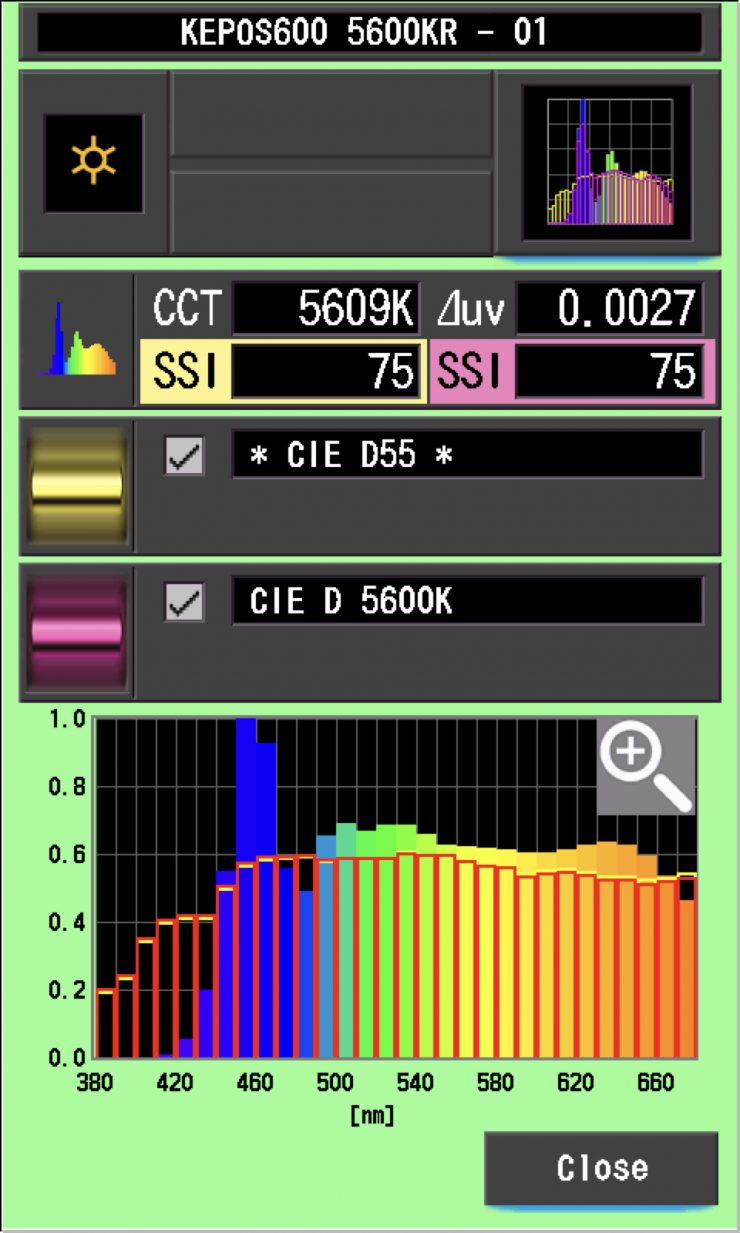
As a comparison, above are the results for the Kelvin Epos 600.

As another comparison, above are the scores for the Prolycht Orion 675 FS.
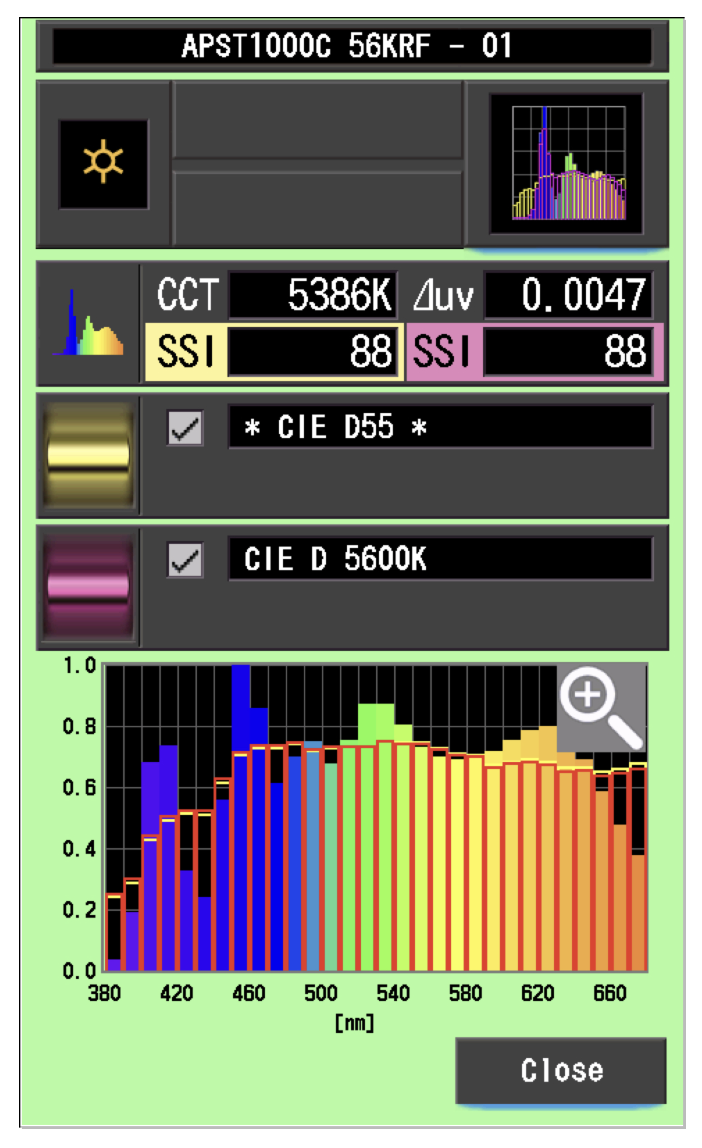
As another comparison, above are the results for the Aputure STORM 1000c.
The main reason we want to record SSI scores is so we can see how well they match with other lights. As an example, I wanted to see how well the Evoke 600C matched the Aputure 1000C and Kelvin Epos 600. Below you can see the results.
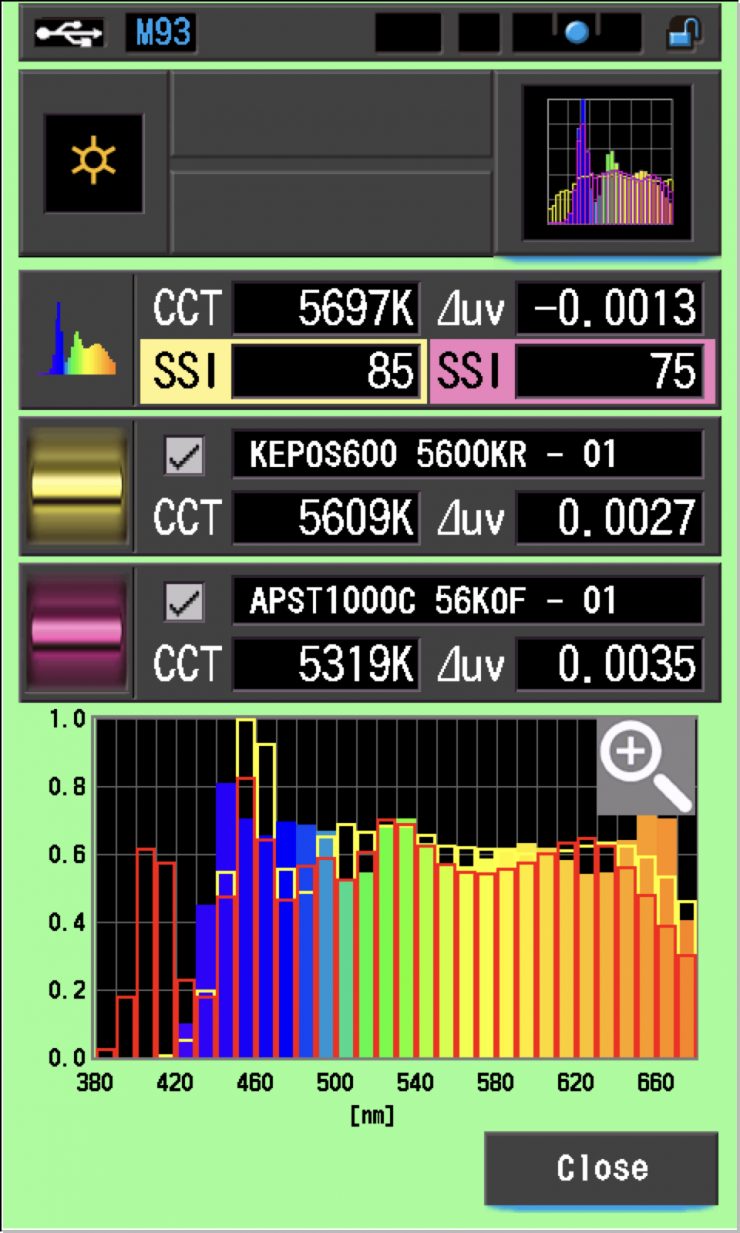
As you can see, neither light is a perfect match to the Evoke 600C, but you could potentially fine-tune the lights to try and get them to match more closely. The Evoke 600C was a much closer match to the Kelvin Epos 600 than it was to the Aputure 1000c.
As another test, I thought I would compare those same lights against the Evoke 600C at 3200K. Below you can see the results.

As you can see, at 3200K, the lights were a slightly better match, but again, they weren’t an exact match to the Evoke 600C. In saying that, very few lights from different manufacturers are ever going to be an exact match.
Okay, so now let’s see how well the Evoke 600C matches itself when used with its 25-degree reflector and against its smaller sibling, the Evoke 150C. In theory, these scores should be very high.
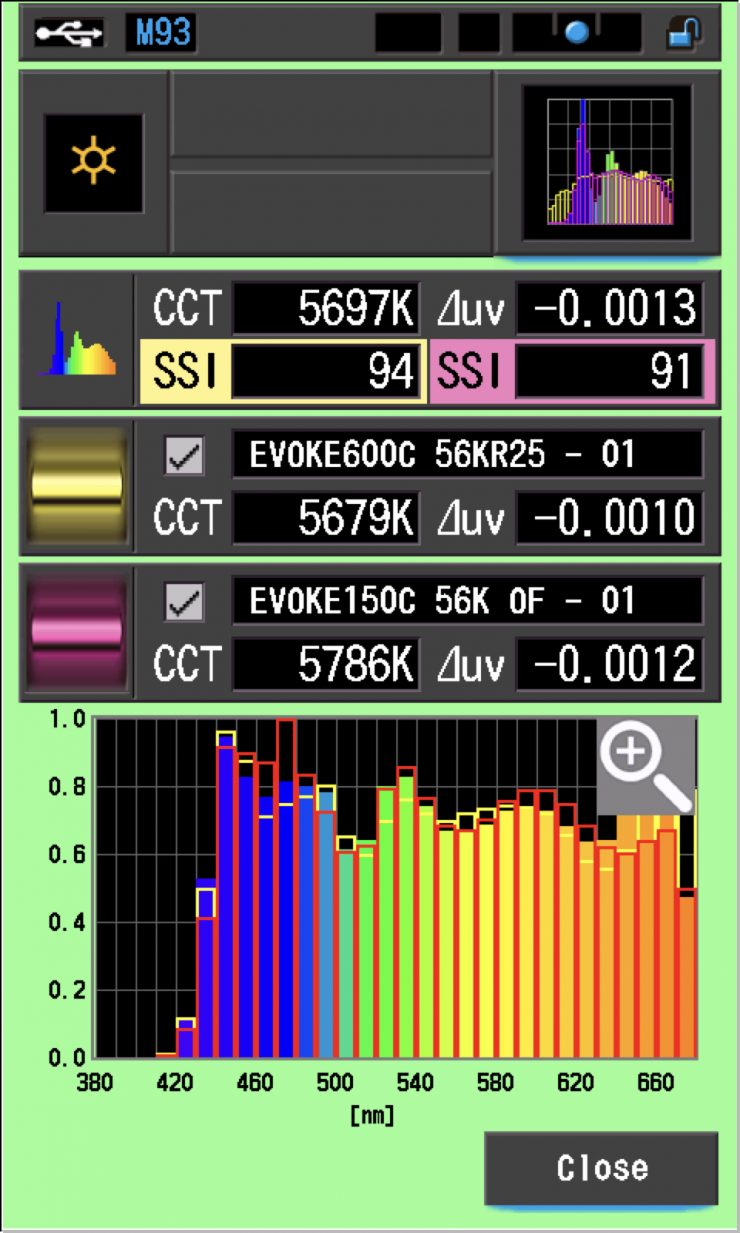
As you can see, neither was an exact match. I was a little surprised to see that the score from the smaller Evoke 150C was only 91. As they use the same light engine, I would have thought that the score should be in the high 90s.
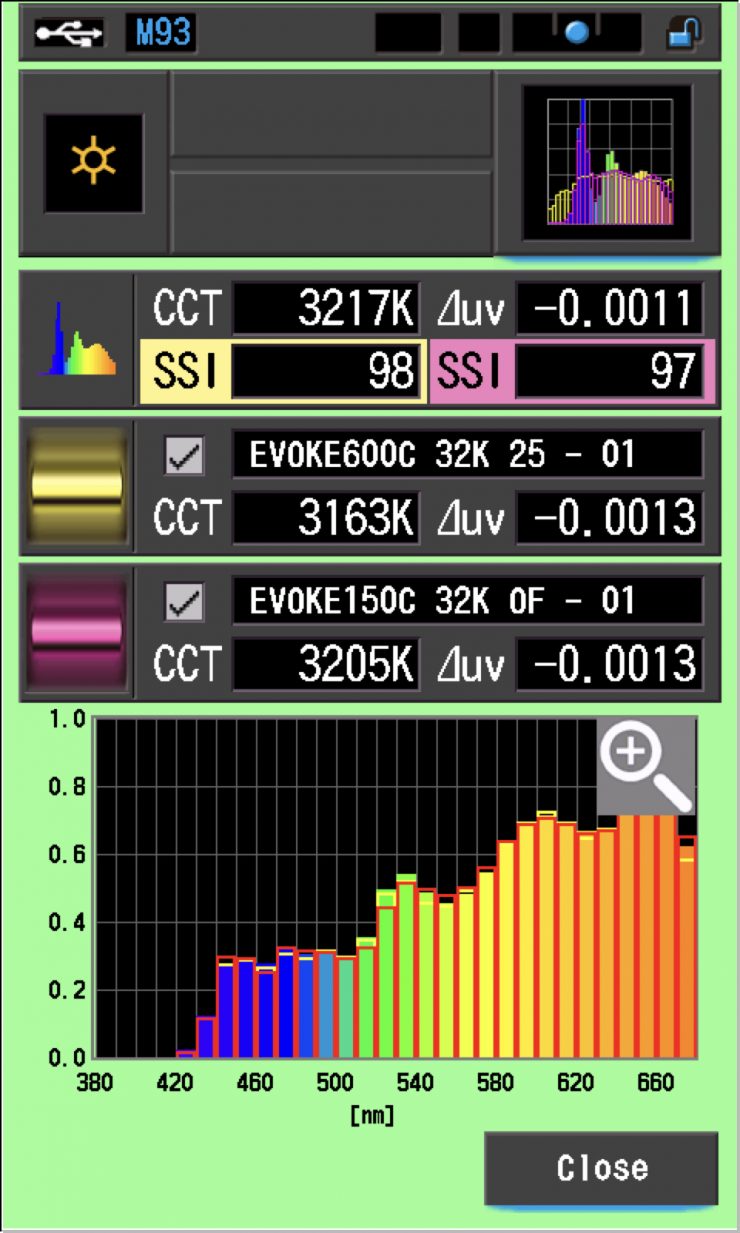
Again, at 3200K, it wasn’t a perfect match, but it was a lot closer.
SSI tests are a great way of telling you what lights you own or use will work well together.
Spectral Distribution
Evoke 600C 5600K

Above, you can see the spectral distribution of the Evoke 600C when it is set at 5600K. The spectral distribution is very full, and it has a lot of information in the 640 nm to 680 nm range that you don’t see in a lot of competing lights.

As a comparison, above you can see the spectral distribution for the Kelvin Epos 600.

As another comparison, above you can see the spectral distribution of the Prolycht Orion 675 FS when it is set at 5600K

As another comparison, above you can see the spectral distribution of the Aputure STORM 1000c.

If you want to see what another really good spectral response looks like for a spotlight at 5600K, above is the result for the Maxima 3.
Evoke 600C 3200K

Above, you can see the spectral distribution of the Evoke 600C when it is set at 3200K. The spectral distribution isn’t overly linear.
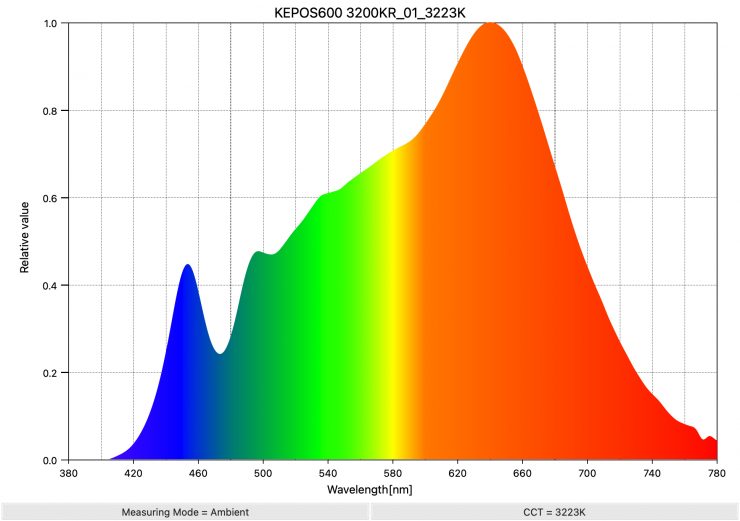
As a comparison, above you can see the spectral distribution for the Kelvin Epos 600.
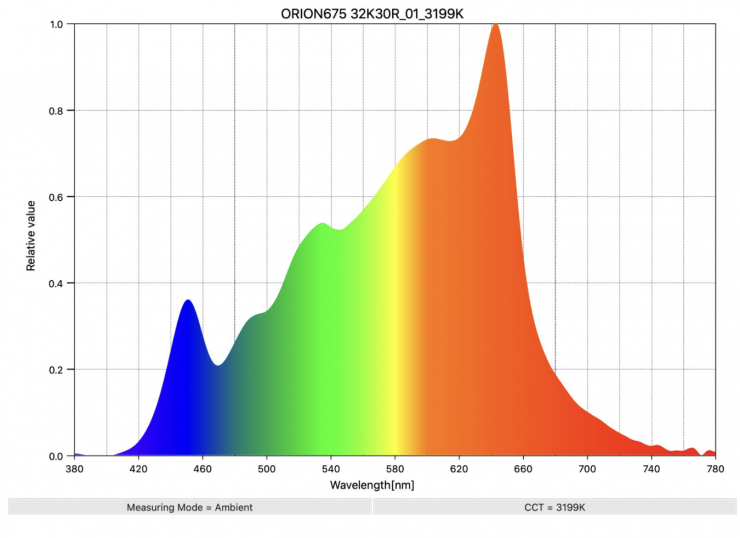
As another comparison, above you can see the spectral distribution of the Prolycht Orion 675 FS when it is set at 3200K

As another comparison, above you can see the spectral distribution of the Aputure STORM 1000c.
Real-World Performance & Quality of Light
As I always say, photometric scores only tell you part of the story. So let’s find out if the scores from the Evoke 600C translate into good real-world performance.
The photometric results can only give me scientific data, and it is much more important for me to see how the light looks and performs, especially with skin tones.
It is very easy to create a very soft, flattering light source using the Evoke 600C. I found that by using a softbox, you could create a very soft lighting source without needing to punch it through a diffusion screen. This makes it a very quick and easy light to use for interview situations or for any scenario where you need soft light.

Above, you can see what the light looks like with a DoPChoice Octa 3 softbox being used. I am not using any other lights in this example.
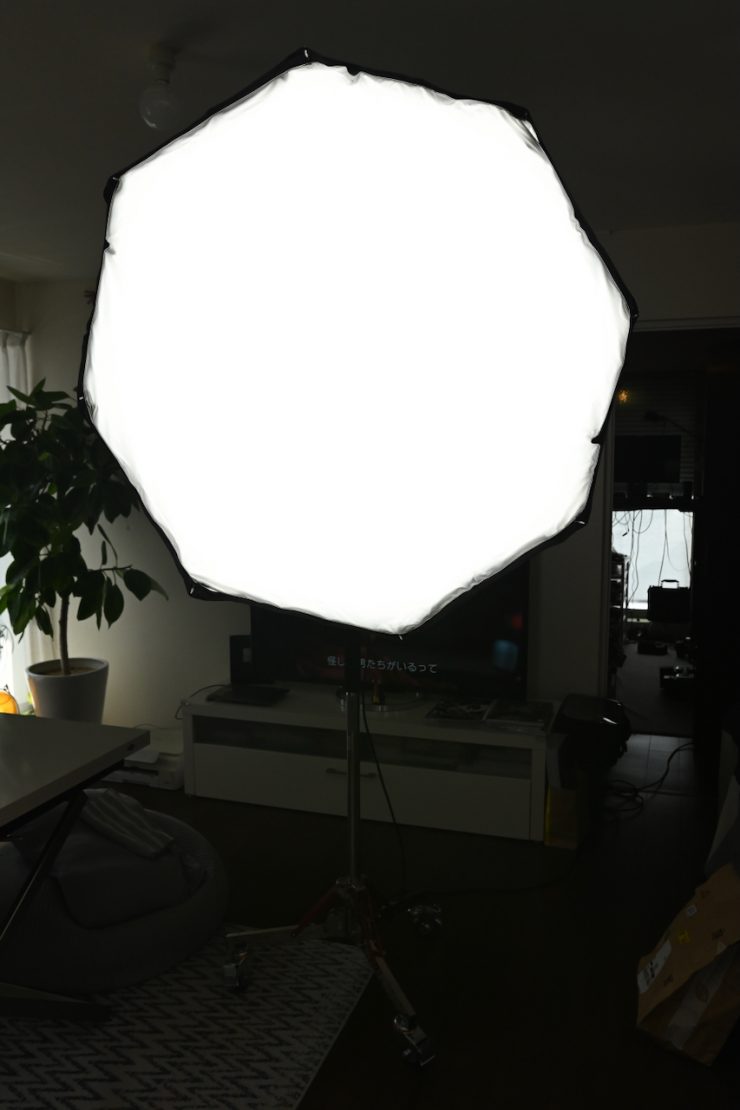
The light doesn’t completely fill up a large softbox because the beam angle isn’t overly wide, although that is also the case when using most point source lights. In saying that, there is still plenty of illumination, and it works well.
It also works well when you punch the light through a large diffusion screen or into some polyboard.
Above, you can see comparison images showing the light when used with its 25 Degree Reflector and positioned outside and punched through a sheer. I have kept the camera settings the same for all of these tests.
Above, you can see what the light looks like with its 25 Degree Reflector being punched directly down into a table and into the ceiling.
Above you can see what the light looks like when used open face and punched into the ceiling.
FL-22E Motorized Fresnel
The optional FL-22E Motorized Fresnel provides a range of 15-50°. It communicates with the Evoke 600C through the electronic contacts on the BE mount (with electronic contacts). The Evoke 600C recognizes the FL-22E and corrects color casts; it also powers the motorized attachment.
The FL-22E Motorized Fresnel can be controlled via the menu on the fixture, the wired remote controller, and from two buttons on the Fresnel itself.
Above, you can see how this works.
All of the movement happens internally within the housing, so nothing extends or retracts.
The Fresnel can also be physically adjusted, but you do need to loosen a hand screw on the motor mechanism to do this.
The FL-22E also comes with adjustable barn doors. These work ok (at wider degree settings), but they don’t provide a sharply defined cut when used with the Fresnel.
Overall, the Fresnel works really well, and it is manageable size.
Who is the NANLUX Evoke 600C aimed at?
You could use the Evoke 600C for lots of different applications, but the light is certainly being aimed as a versatile, high-output, well-made lighting fixture for professionals in the TV and film industry.
It is priced to appeal to mid to high-end owner-operators who are looking for a jack-of-all-trades lighting solution. Just like most modern-day LED spotlights, the Evoke 600C has the ability to be a hard light source, a soft source, a fresnel, a gobo, a Source 4, or just about anything else you want it to be.
Is the Evoke 600C likely to appeal to solo shooters and small crews who are looking for a similar light to say an Aputure LS 600c Pro II? That is hard to say because it is around $600 USD more expensive. It is, however, better built, and it offers, at least in my opinion, superior performance. In saying that, it does face stiff competition from Aputure’s new STORM 700x, even though that light draws 250W more, it costs $ 374 USD less.
Price & Availability
The Evoke 600C retails for $2,064.00 USD. This does make it more expensive than a lot of other competing fixtures that could be considered competition.
Below you can see how the price compares to the competition:
*Currently on sale at B&H as of the 25/9/2025
Conclusion
The NANLUX Evoke 600C is a very impressive fixture. It is well-made, easy to use and operate, and it has a great feature set. With so many lighting modifiers available, it makes it a fixture you can use for so many different applications.
The new NANLUX Nebula C8 light engine is very good and a big step up from the previous lighting engines the company was using.
The interface and operating system are super easy to use, as is the app. The new BE mount (with electronic contacts that can recognize accessories and correct color casts, as well as power the motorized attachment) is very impressive. As the light is also compatible with the Bowens mount accessory ecosystem and the NL mount accessories via the NL to BE mount adapter, you can use a vast array of lighting modifiers.
The occasional oscillating high-pitched fan noise did slightly concern me. The consistency of the light when it comes to output and color accuracy is impressive. In my opinion, the light is priced well given its feature set, output, and capabilities. The color accuracy is some of the best I have seen from any LED spotlight.
The new FL-22E Motorized Fresnel works really well, but if you are travelling a lot, you do need to factor in the size and weight.
What some users may find disappointing is that if you want to run the light remotely without mains power, then you will need to use a 48V solution. This arguably puts it at a disadvantage if that is one of the things you are looking for in a light. In saying that, with so many affordable portable battery solutions now available from companies such as Ecoflow and BLUETTI, etc, maybe it’s not as big of a deal as it used to be.
The light has a good amount of output, and the photometric performance is impressive. At least in my opinion, if you are looking for a 600W full color fixture, then the two best options on the market are the NANLUX Evoke 600C and the Kelvin Epos 600. Where NANLUX has the advantage is that they offer a lot more lighting modifiers, and they have a complete ecosystem of lighting products. The Aputure STORM 700x, which was just announced, is also a light that is going to provide fierce competition.
The Evoke 600C is also relatively lightweight given its power draw, and this is advantageous if you are travelling a lot. In saying that, there are better options if you need to power a light remotely in the field.
If you don’t need all of the bells and whistles and build quality that come with a light like this, then you may well find that lower-priced options from other companies may be a better option. If, however, you are looking for a no-compromise full color COB fixture with great build quality and performance, then the Evoke 600C ticks a lot of boxes.
The direct competition, at least in my opinion, comes from the older Aputure LS 600c Pro II or Kelvin Epos 600. Aputure currently doesn’t have a 600W full color fixture in its new STORM series; however, you could arguably compare it against the STORM 400x, which draws 500W, and the new STORM 700x that draws 850W.
The Evoke 600C is an extremely impressive fixture, and it does a lot of things really well, without compromising on any of them. You get a good amount of output, and that output isn’t at the expense of color accuracy. It is right up there with some of the best lighting fixtures I have ever reviewed.
Like what we do and want to support Newsshooter? Consider becoming a Patreon supporter and help us to continue being the best source of news and reviews for professional tools for the independent filmmaker.



